Foreword
MESSAGE FROM THE PRESIDENT & CEO, ASIA PACIFIC FOUNDATION OF CANADA
The extraordinary first months of this new decade serve as a stark reminder of how central the Asia Pacific has become to all aspects of our lives. Now more than ever, Canada is witness to the increasing significance of the region as the engine of the new global economy – and witness to what happens when the engine stops, however temporarily.
The need for Canada to strategically deepen and diversify its linkages with the Asia Pacific has become more pressing, as even the strong, historical trade and investment ties with our partners in the United States and Europe face stress from the confluence of disease and economic downturn. As Canada looks ahead to a period of recovery and re-engagement, policy-makers, the business community, and the public will need to return to discussions – and debate – around foreign direct investment (FDI).
In 2020, the APF Canada Investment Monitor is turning its attention to the connections between Canada’s free trade agreements with Asia Pacific economies and FDI. Canada’s trade agreements provide a rules-based system that encourages both trade and investment with partners in the region. With 2019 concluding the first year of our participation in the Comprehensive and Progressive Agreement for Trans-Pacific Partnership (CPTPP), this report adds to our understanding of how agreements can provide a road map for Asia Pacific engagement.
Additionally, the report expands on our city-level coverage of FDI by analyzing how Canada’s cities are hubs as both investors and recipients and describing FDI’s role in rural Canadian communities. You will also find new analysis on investment in health care, pharmaceuticals, biotechnology, and clean technologies, and descriptions of bidirectional impacts on FDI in 2008-2009, filling gaps in the data and analysis that is otherwise publicly available on where investment opportunities have been – and where we can expect them to re-emerge once again.
On behalf of APF Canada, I would like to acknowledge the efforts of those involved in producing this report, especially our partner, The School of Public Policy at the University of Calgary, and our sponsors – Export Development Canada, Invest in Canada, the Government of British Columbia, Advantage BC, and the Bank of Canada. I would also like to extend my appreciation to our Advisory Council members – Sarah Albrecht, Eugene Beaulieu, Joan Elangovan, Lori Rennison, Clark Roberts, Siobian Smith, and Stephen Tapp – for the valued feedback they have provided.
And finally, I would like to thank the members of our APF Canada research team who were responsible for writing and finalizing this report: Jeffrey Reeves, Vice-President, Research; Pauline Stern, Program Manager, Business Asia; Grace Jaramillo, Interim Program Manager, Business Asia; Kai Valdez Bettcher, Research Specialist; our Post-Graduate Research Scholars and Junior Research Scholars, Isaac Lo, Phebe Ferrer, and Sainbuyan Munkhbat; and APF Canada’s communications team for editing and designing the final publication, Michael Roberts, Communications Manager, and Jamie Curtis, Graphic Designer.
Stewart Beck,
President and CEO, Asia Pacific Foundation of Canada
Executive Summary
Over the past two decades, the Asia Pacific’s dynamic, fastest-growing economies have played a central role in the global economy, boasting unprecedented opportunities for foreign investment in a number of key markets – in terms of both opportunities for Canada to receive foreign investment and opportunities for Canadian investors to invest abroad.
To describe this relationship, the APF Canada Investment Monitor aggregates raw data from the Asia Pacific Foundation of Canada’s archive of investment deal announcements from 2003 to present (see methodology section for further details).
Each year of the project corresponds with an annual theme; this year’s theme is investment and free trade agreements, with previous years focusing on inbound investment, outbound investment, and city-level data.
This annual report presents the following:
- General trends in Canada’s foreign direct investment relationship, with specific reference to the Asia Pacific, up to 2019;
- The connections between Canada’s free trade agreements in the Asia Pacific and investment; and
- Inbound and outbound relationships at the national, provincial, and city levels.
Key Takeaways from the Report
In 2019, the total two-way value of Canadian investment with CPTPP-ratified economies was C$5.8B by way of 56 deals.
Of these, C$3.0B was in Canadian outbound investment to these trade partners, while C$2.9B came into Canada. However, investment flows for 2019 between Canada and CPTPP economies decreased from 2018.
In the Asia Pacific, the strongest evidence for increased FDI after a free trade agreement is the Canada-South Korea free trade agreement signed in 2015.
Canada received an additional C$870M from South Korea from 2015 to 2019, while the total value of two-way investment flow in the period increased significantly by 35 percent, from C$5.1B in the five years prior to the agreement to C$7.8B in the five years post-agreement.
In 2019, Canada received a total of C$8.3B of foreign direct investment from Asia Pacific economies.
This represents a decline in new investment received from the historic high of C$33B in 2018. From 2015 to 2019, Canada received C$56B in Asia Pacific investment through 428 deals, hitting a 16-year high.
The number of inbound investment deals in 2019 set a record with 151 deals.
The Asia Pacific’s investment activity in Canada was high, part of a multi-year trend with investments increasing each year since 2015.
In 2019, Canada invested a total of C$7.2B in the Asia Pacific.
This represents a significant drop from 2018’s C$18B in investment. Deal counts also dropped and reached the lowest point since 2003, with only 75 outbound FDI deals made that year.
Many provinces saw increases in new investment received across the past decade.
The value of Ontario’s new investments received increased C$12.6B in the second half of the decade, while Quebec added C$5.1B in new investment. Flows of Asia Pacific investment received by BC nearly tripled, rising to C$32.8B, but new Asia Pacific investment into Alberta dropped from C$44.0B in the first half of the 2010s to just C$2.9B in the second half.
Over the past 17 years, 97 Canadian cities have invested into the Asia Pacific, and 191 cities have received investment, representing a strong network of ties across the Pacific.
During that same period, 21 Canadian cities invested half a billion or more into the region, some with hundreds of deals. On the Asia Pacific side, Beijing, Tokyo, and Hong Kong lead as sources of investment in Canada, while Melbourne and Sydney are the top destinations for Canada.
Introduction
GENERAL TRENDS IN INVESTMENT TO 2019
With the turn of the new decade, the Asia Pacific continues to be a dynamic region of economic growth and opportunity. In 2020, some are heralding the start of an “Asian century,” where the region becomes “the new centre of the world” as it continues to grow and expand.[1] According to the 2019 World Investment Report released by the United Nations Committee on Trade and Development (UNCTAD), Asia remains the largest recipient region of FDI flows, with 4 percent growth since 2018.[2] China is the second FDI receiving economy after the United States, closely followed by Hong Kong and Singapore, in third and fourth place, respectively. In particular, Southeast Asian economies like Singapore and Indonesia are expected to continue being “the region’s growth engine,” with an estimated 19 percent increase in FDI flows for 2019. Overall, in terms of shares of world GDP in purchasing power parity, the Asia Pacific region is projected to become larger than all other economies combined.
Recent developments in US-China trade tensions have led to uncertainty in the global economy, as have slowdowns in the US and Chinese economies, raising the risk of slowed economic growth.[3] Indeed, the growth of the Asia Pacific was expected to slow, even before the ongoing COVID-19 pandemic: the most recent Global Investment Trend Monitor update forecast a 6 percent drop in regional FDI inflows for 2019.[4]
For Canada, while the Asia Pacific region is a small part of its FDI flows, it is a growing region of interest. From 2015 to 2018, Canada’s FDI flows to the region made up 7 percent of its total outbound FDI. In the same period, incoming flows from the region made up 10 percent of Canada’s total inbound FDI.
HOW CANADA STACKS UP IN ITS INVESTMENT RELATIONSHIP WITH THE ASIA PACIFIC
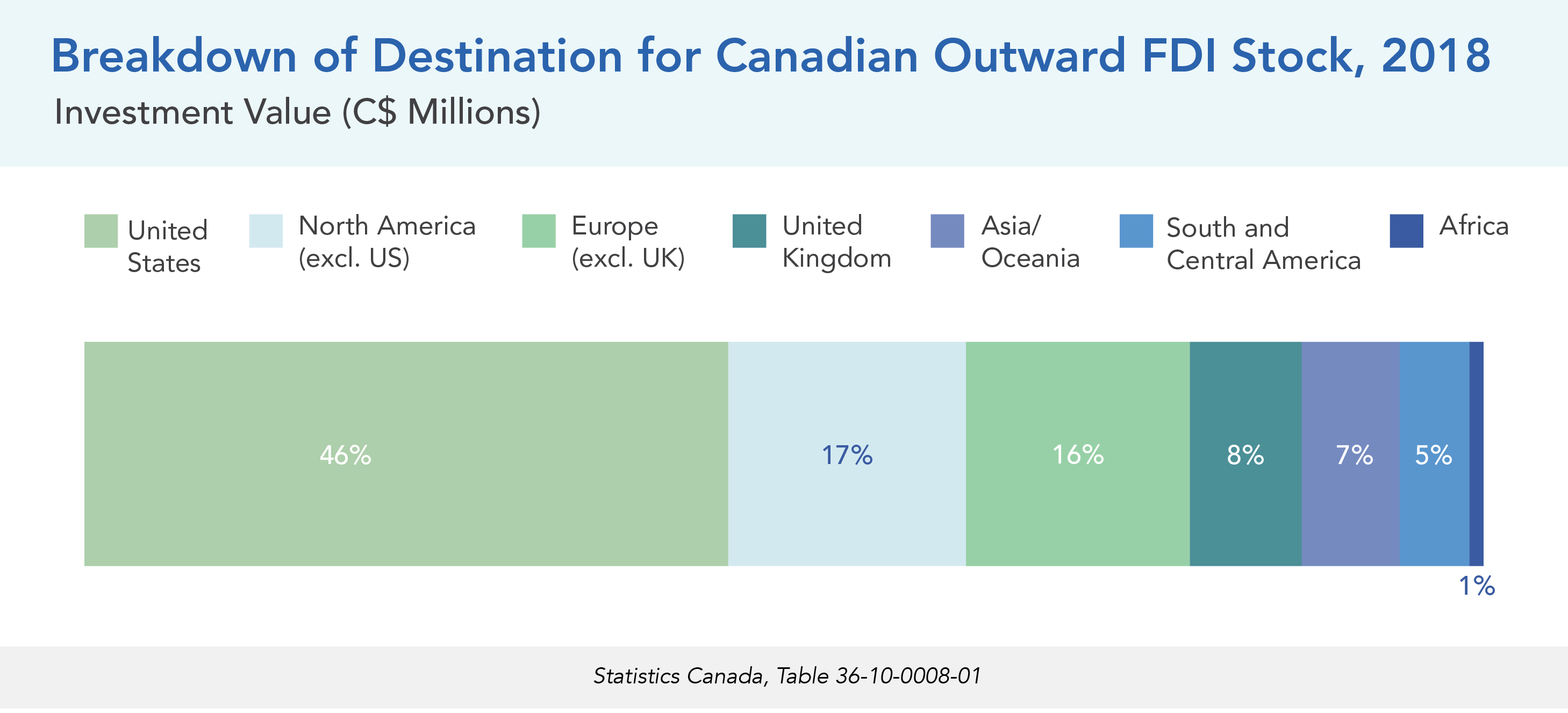
Canadian outward direct investments are highly concentrated in traditional economic partners. Europe, the United Kingdom, and the United States accounted for almost 80 percent of Canadian FDI stocks in 2018. The United States, in particular, remains Canada’s top investment destination: in 2018, Canada’s southern neighbour accounted for 46 percent of Canada’s outward foreign direct investment stock with C$595B of value, a 13 percent increase from the previous year. Europe and the United Kingdom, on the other hand, accounted for 33 percent of Canadian investment stock. Canadian investment in the Asia Pacific region remains limited: in 2018, the region accounted for 6.9 percent of Canada’s total outward FDI stock, a 0.4 percent drop from 2017 data.
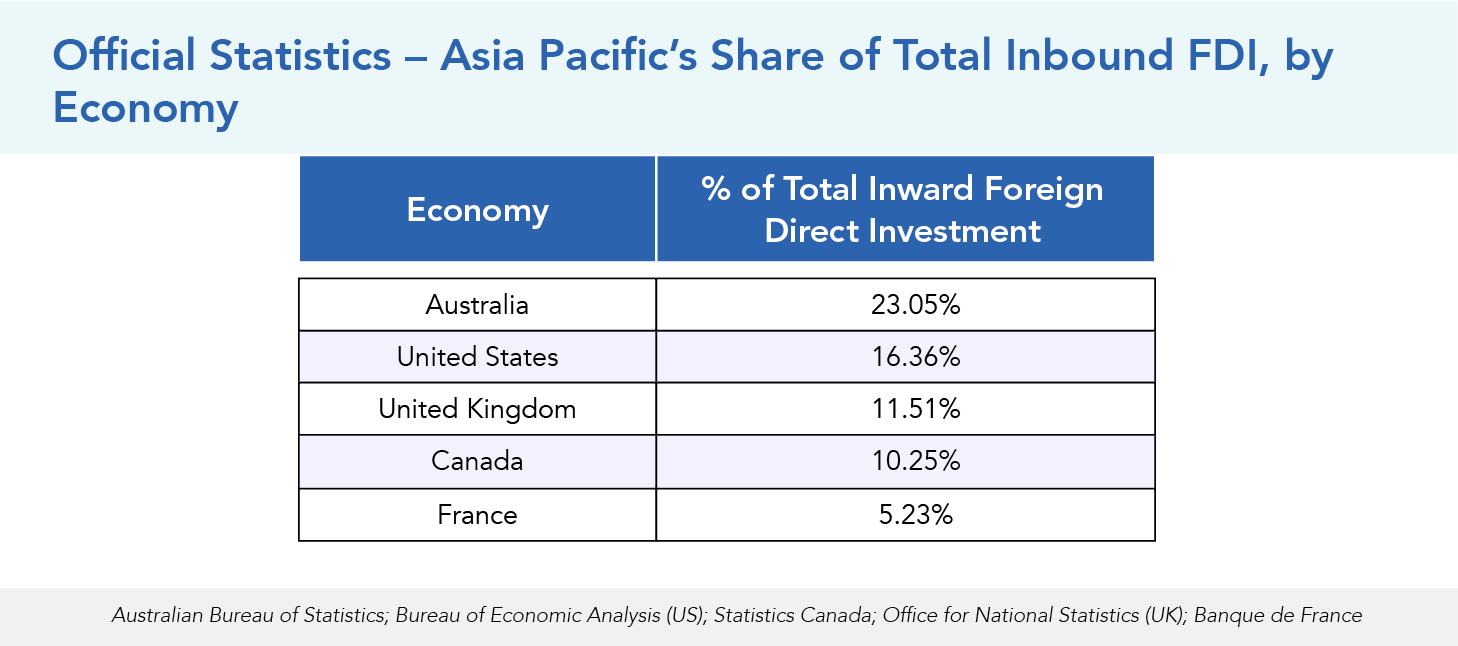
When it comes to the economy’s share of total investment from the Asia Pacific, Canada ranks low compared to many comparator economies, including Australia, the United States, and the United Kingdom. The average proportion of their Asia Pacific investments in 2018 was 14 percent, and Canada was about 4 percentage points below the average. This suggests that there remains room for Canada to improve investment ties with the region.
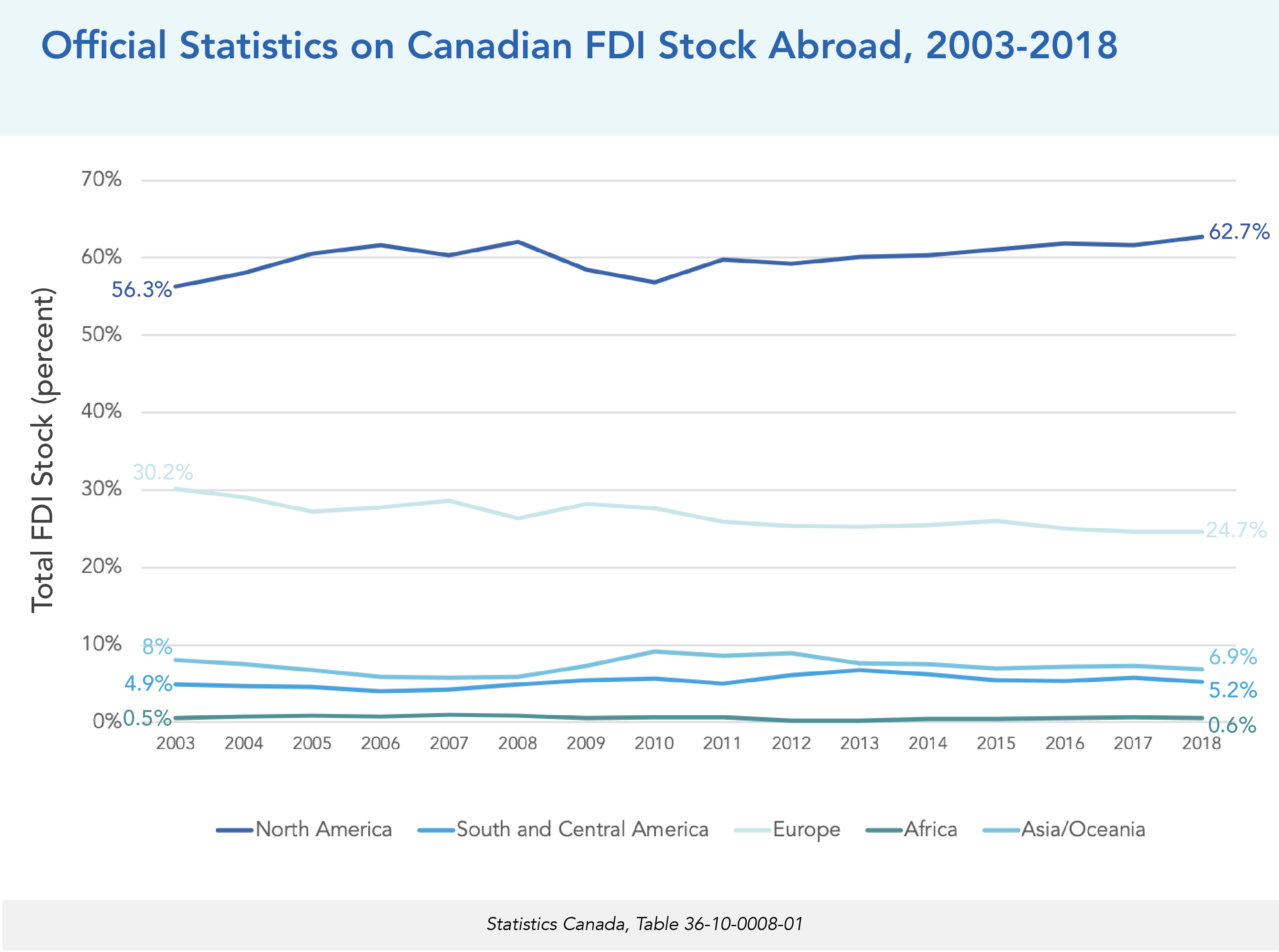
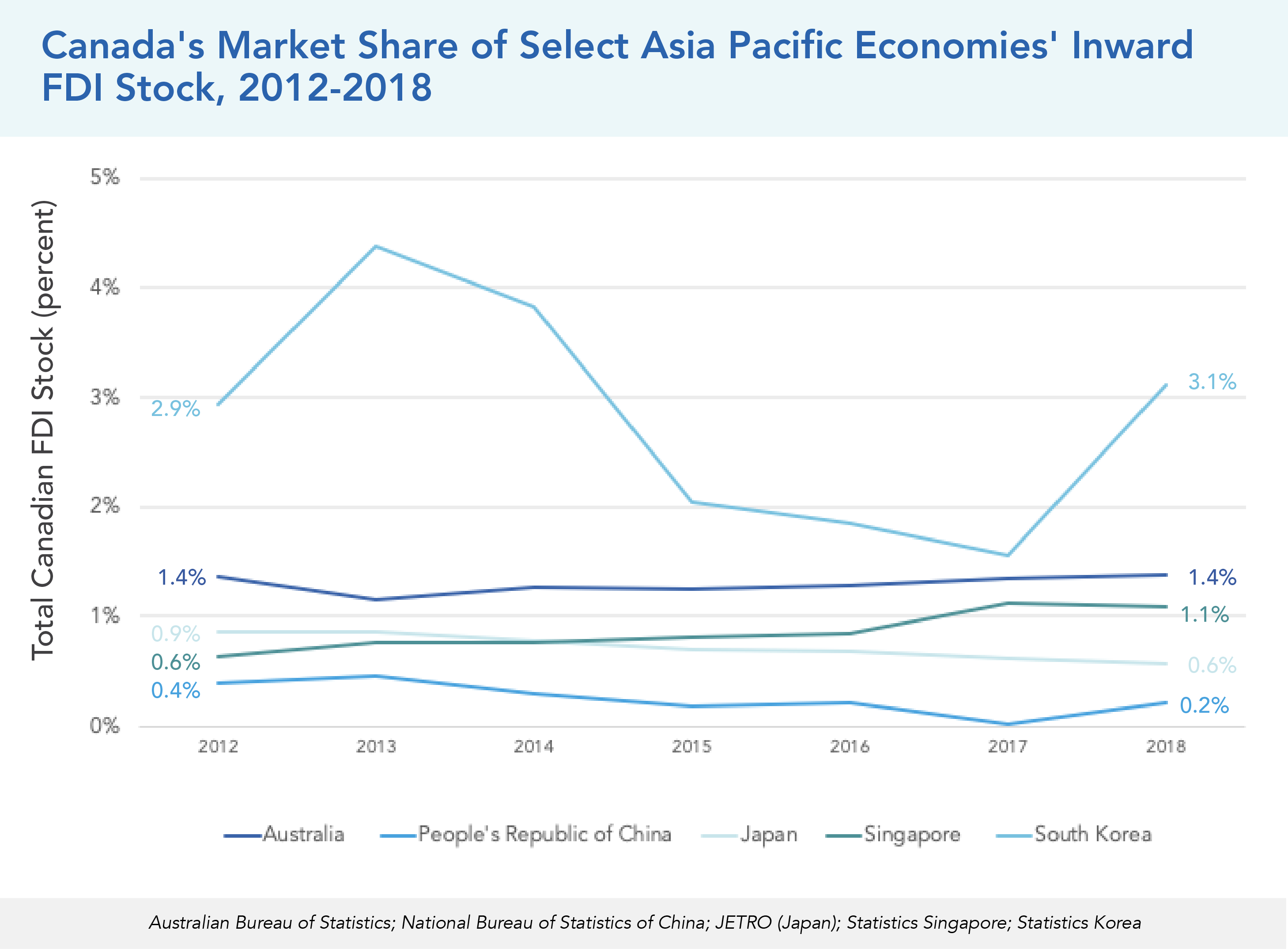
Canada’s role as investor in the Asia Pacific remains small, both as a share of Canada’s total outward investment and as a share of investment received by Asia Pacific economies. As of 2018, Canadian investment in the region totalled C$88.9B, or 10 percent of all Canadian investments abroad. Some of the most invested-in economies in the region are Australia, China, Hong Kong, and Japan, which have shares of total Canadian outbound flows ranging from 0.5 to 2.4 percent. Inbound investments from the Asia Pacific are also small, but have been generally stable since 2015. Japan notably has the highest relative share of inbound investment into Canada, while Singapore has the lowest share. Official statistics from economies across the Asia Pacific similarly show that Canada is a small investor in the region. Data from 2018 for Australia, China, Japan, Singapore, and South Korea show that Canada’s share in their inward FDI flows ranged from only 0.2 to 3.1 percent.
For investment coming into Canada, these statistics also show that Canada is not a significant destination for the Asia Pacific. One notable exception is South Korea, where outward FDI to the Canadian market is steadily rising.
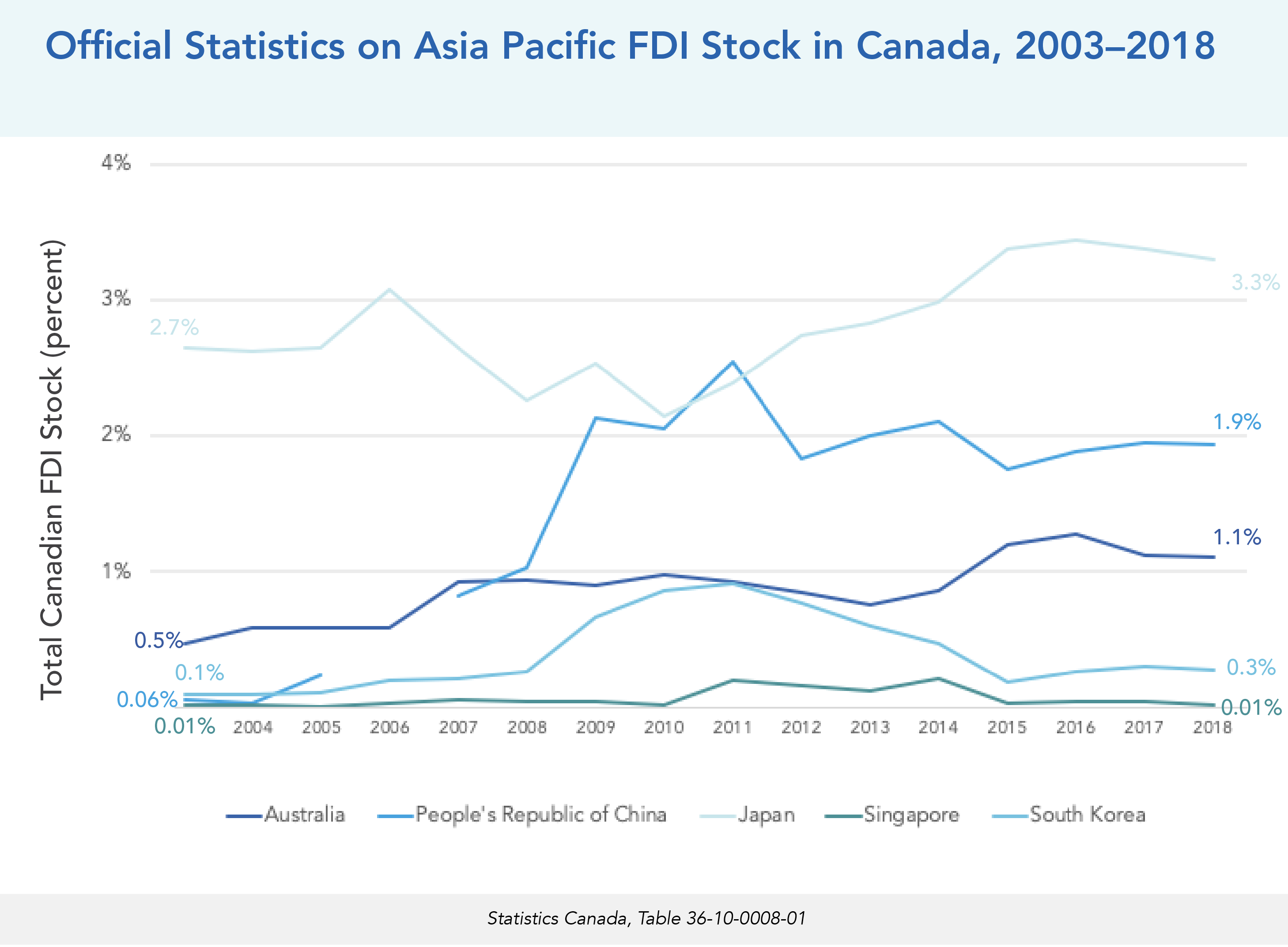
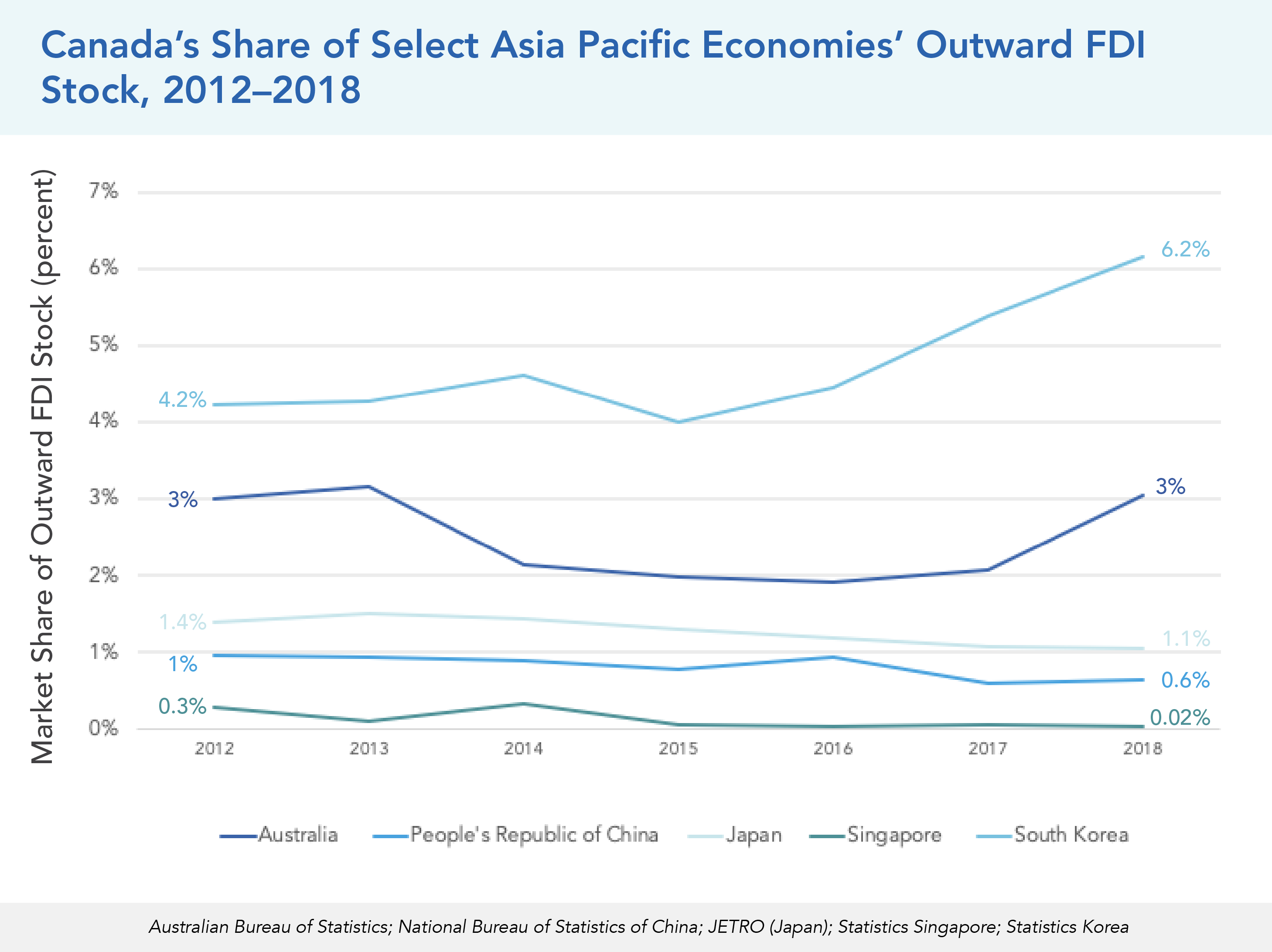
The official statistics provided by Statistics Canada show Canada’s international investment position on a national level, using a top-down approach in its collection of data. The data is mainly gathered from surveys of Canadian and foreign firms, as well as reports from government bodies like the Bank of Canada.
Due to the top-down nature of the data, Statistics Canada is unable to record the ultimate sources and destinations of investments, the subnational-level distribution of investments, and the distribution of investments by industry. As such, national data provided by Statistics Canada and Asia Pacific economies does not offer transaction-level information on FDI, nor details on the number of deals and distribution of investments across geographic regions and industries.
BOX 2. CROSS-BORDER INVESTMENT AND FDI
Cross-border investments can be separated into two major groups: 1) foreign portfolio investment (FPI) and 2) foreign direct investment (FDI).
Foreign Portfolio Investment
FPI is a temporary investment by a resident or enterprise of one economy into a financial asset of another economy. This investment involves a non-controlling stake in an enterprise in the form of equity, debt securities, or loans. For example, a Canadian firm increasing its stake from 3 percent to 5 percent in a South Korean firm would be an FPI.
Foreign Direct Investment
FDI is a long-term or lasting-interest investment by a resident or enterprise of one economy into a tangible asset of another country. This type of investment is deemed “long term” or of “lasting interest” if it is either a greenfield investment or an acquisition of at least 10 percent of the equity or voting shares of an enterprise. This 10 percent threshold is considered a controlling interest in an enterprise and is what primarily distinguishes FDI from portfolio investment, since it usually coincides with a transfer of management, technology, and organizational skills along with capital. One example of FDI is Canada-based Gildan Activewear’s investment of $45M into a new manufacturing plant in another country that would expand its textile and sewing operations in the country.
The concepts of stock and flow are commonly used in economics and accounting. Stock refers to an existing quantity at one specific time, whereas flow refers to the movement of quantities in and out of the stock. There are two types of flows: inflow, which is an addition to the stock, and outflow, which is a deduction from the stock. The numerical difference between the inflow and outflow is called a net inflow. If the net inflow is positive, this means that the stock is rising, whereas if it the net inflow is negative, this means that the stock is falling. A bank account can illustrate these concepts. The balance of the account is the stock, while deposits and withdrawals from the account are the flows. In an investment scenario, the total amount of capital that Canada has accumulated and depleted through investment over the years is considered the stock. The amount of investment flows coming into and exiting Canada then represent its inflows and outflows, respectively.
[1] Romei, Valentina, and John Reed. 2019. The Asian Century is Set to Begin. Financial Times. https://www.ft.com/content/520cb6f6-2958-11e9-a5ab-ff8ef2b976c7
[2] United Nations Conference on Trade and Development. 2019. World Investment Report 2019: Special Economic Zones. https://unctad.org/en/PublicationsLibrary/wir2019_en.pdf
[3] Pacific Economic Cooperation Council. 2019. State of the Region: 2019-2020. https://www.pecc.org/resources/regional-cooperation/2627-state-of-the-region-2019-2020
[4] United Nations Conference on Trade and Development. 2020. Investment Trends Monitor. https://unctad.org/en/PublicationsLibrary/diaeiainf2020d1_en.pdf
Free Trade Agreements in the Asia Pacific and FDI: Any Correlation?
KEY SECTION TAKEAWAYS
- Free trade agreements have a strong positive effect on boosting foreign direct investment among developed economies. The main causal mechanisms are the additional investment protection clauses included in all agreements, the expanded market, and the lowered costs and barriers for doing business.
- In the Asia Pacific, the strongest evidence for increased FDI after a free trade agreement is the Canada-South Korea free trade agreement signed in 2015. Canada received an additional C$870M from 2015 to 2019.
- In 2019, two-way investment flows between Canada and the CPTPP economies were mostly tied to the software and computer services sector, which accounted for 25 percent (C$1.4B) of the total value of inward and outward investment. The next two biggest sectors were mining (C$1.2B) and aerospace and defence (C$963M).
- In 2019, the Association of Southeast Asian Nations (ASEAN) economies invested over C$1.2B (12 deals) in Canada, whereas Canada invested C$112M (8 deals) into ASEAN.
- In the past five years, Canadian companies have been investing in greenfield deals in the economies of the Pacific Alliance, with a cumulative investment value of C$17.1B.
FDI AND TRADE THEORY
In this report, APF Canada decided to explore one of the most common questions about foreign direct investment: What is the relationship between FDI and trade, and more specifically free trade agreements? Since the 1990s, economic theory and research has been conducted on if and how increasing bilateral investment treaties and free trade agreements heightens investors’ confidence by securing equal treatment, respect for international norms, and rule of law, including protection of the right to profit and capital repatriation.[5] The proliferation of free trade agreements after the 2000s put this theory to the test. Different studies have proved that there are not one, but numerous causal mechanisms behind the strong relationship existing between FTAs and foreign direct investment, depending on the size of the market, the levels of commercial exchange, and the possibilities of expansion.[6]
The first and most important incentive for investment as a result of an FTA is the enhancing credibility of the chapter on investment protection that is included in every FTA. Investment protection chapters now not only prohibit expropriation without prompt and adequate compensation, but they also prohibit discriminatory treatment toward foreign investors. In addition, all FTAs, as well as most bilateral investment treaties (BITs), offer the additional benefit of settling any international investor-state dispute through third-party arbitration and other dispute-settlement mechanisms.
These benefits provide levels of guarantees that help investors feel safe moving in and out of the member countries in the new agreement. They reassure the investor that the host country will eliminate production distortions and procedural or institutional barriers to conducting business in that country.[7] For the Canadian economy this is significant because FTA investment protection chapters have protected one of its most important investment sectors, mining and extractive industries, whose products are usually not covered by tariff reductions.
Other scholars have found that the potential size of the market induced investment in local production and incorporation in core value chains of the most developed country.[8] For instance, South Korea’s FDI in greenfield investments and advanced manufacturing expanded rapidly with FTA partners because of the added value of bilateral tariffs over time.[9] Trade openness offers additional incentives for South Korean companies as they use the agreements to expand manufacturing facilities and create economies of scale. Our own findings suggest this relationship in the case of South Korea, as Canada’s investment in South Korea increased almost threefold after the ratification of the FTA. While Korean investment in Canada was already significant, it increased even more after the agreement. Korea’s wide manufacturing base and Canada’s large market provided additional incentives, but the FTA explains at least 50 percent of the additional investment Canada received from this new partnership.
Mega free trade agreements tend to provide further incentives to increase foreign direct investment. Jang has shown that, at least for developed countries like Canada, the existence of a regional FTA increased FDI by 14 to 35 percent from member countries alone and by 28 to 35 percent from non-member countries.[10] Multilateral and plurilateral trade agreements such as the CPTPP can create additional incentives, such as regional market integration and regional supply chains in both goods and services, which make investment flows easier and more attractive. In other words, these mega agreements not only enhance investors’ confidence in a common set of rules and legal protections for investments, but also in the fluidity and increase in labour services, equity markets, financial services, innovation, and technology that become available when distance stops being an issue.
In sum, FTAs are potentially better at increasing foreign direct investment – rather than trade – in the new member countries, at least in the first five years after ratification.[11] Increasing investment protection, national treatment, expanded market possibilities, and implicit economic co-ordination compound the incentives that boost FDI in new FTA partners, even before the agreement enters into force. The Investment Monitor 2020 report presents only an example of what Canadians should observe about the relationship between FTAs and foreign direct investment inward and outward. We start by analyzing the deals and investment in the largest free trade agreement in the Pacific, the CPTPP, and then look at the Canada-Korea Free Trade Agreement (CKFTA). For comparative purposes, this chapter will also examine Canada’s investment ties with the ASEAN economies and the Pacific Alliance FTA under analysis by the Canadian government.
FTAS AND INVESTMENT
The Comprehensive Progressive Trans-Pacific Partnership
The CPTPP was signed in March 2018 between Canada and 10 other economies in the region, and entered into force on December 30 of the same year. As of April 2020, the trade agreement has been ratified by seven economies, including Australia, Japan, Mexico, New Zealand, Singapore, and Vietnam.[12]
The CPTPP was first implemented in 2019, but this was a difficult year for the global economy and the Asia Pacific region in particular. The US-China trade dispute derailed many trade and investment opportunities on both sides of the Pacific, and it is difficult to assess to what extent the trade war influenced the final investment outcome compared to the opportunities lost.
The total two-way value of Canadian investment with economies that ratified the CPTPP was C$5.8B (56 deals). In particular, outward and inward Canadian investments were valued at C$2.95B (25 deals) and C$2.9B (31 deals), respectively. The biggest inbound investment deal of 2019 into Canada from the CPTPP was a C$731M deal from Tokyo-based Mitsubishi Heavy Industries Ltd. to acquire the Canadair Regional Jet Program from Bombardier Inc. Meanwhile, the biggest outward Canadian investment transaction was a C$917M investment from Toronto-based Brookfield Asset Management Inc., acquiring a 49 percent stake of Vodafone New Zealand Limited.
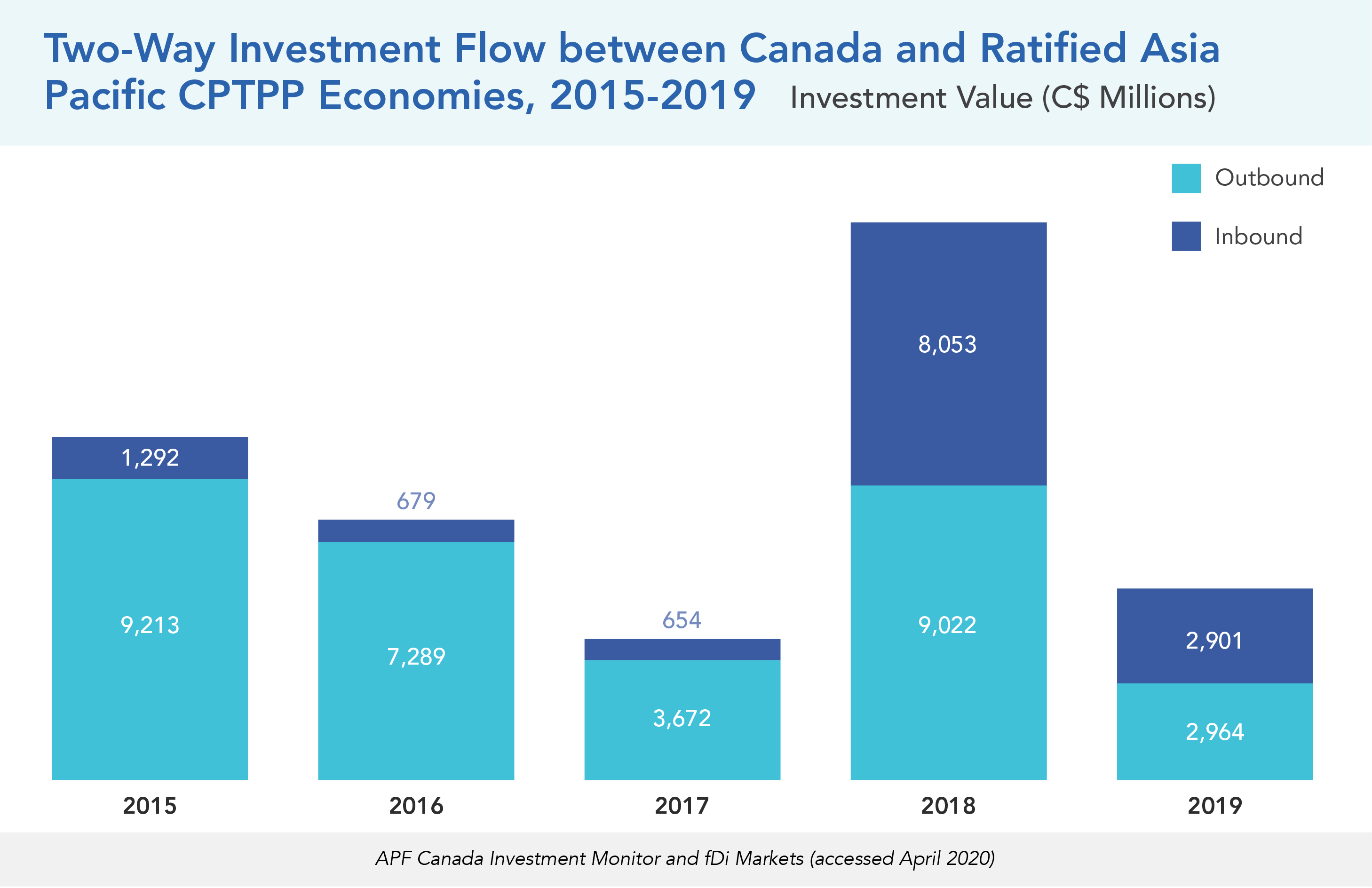
Canada and five other economies in the region have ratified the CPTPP, including Australia, Japan, New Zealand, and Singapore. Overall, the investment flows for 2019 between Canada and CPTPP-ratified economies decreased from 2018. However, in 2018, there were a few deals that dominated the share of total investment flow. Of these high-scale deals, state-owned enterprises such as the Ontario Municipal Employees Retirement System and the Canada Pension Plan Investment Board had the lion’s share (over 50 percent) of investments into the Australian real estate and mining sectors. These pension-backed enterprises from Canada invest in a diverse range of assets in public and private sectors worldwide.
Similarly, the volume of inward Canadian investment in 2018 was dominated by a few investment deals. Over three-quarters of the total inward investment (C$6.1B) was from Japanese Mitsubishi Corporation through its joint venture, LNG Canada, into the oil and gas producers’ sector of Canada, building a liquefied natural gas export facility in BC. LNG Canada is a joint venture among Shell Canada Energy, Petronas, PetroChina Company Limited, Mitsubishi Corporation, and Korea Gas Corporation.
Within the CPTPP economies, Australia, New Zealand, and Japan were the top investment destinations for Canada in 2019. Canada invested over C$1.4B (18 deals) into Australia, C$1.1B (3 deals) into New Zealand, and C$436M (4 deals) into Japan. The target investment sectors in Australia were diverse, with chemicals (C$623M), health care equipment and services (C$335M), and travel and leisure (C$150M) at the top. On the other hand, New Zealand’s software and computer sector attracted the most Canadian investment (C$1B) to the country. Canada invested in Japan’s utilities sector (C$436M), particularly in alternative electricity.
In terms of Canadian inward investment from the CPTPP economies in 2019, Australian investment into Canada amounted to over C$1.5B (25 deals), and Japan invested C$1.3B (31 deals). The majority of Australian investment (C$1.2B) went to the mining sector of Canada, while a big share of the Japanese investment (C$933M) was in the aerospace and defence sector.
Overall two-way investment with Australia is the highest in both scale (C$2.9B) and number (43 deals) of deals among the CPTPP-ratified economies, whereas Japan is the second-largest investing partner with Canada, accounting for C$1.7B in 35 deals in 2019. Moreover, New Zealand had only six deals in both inward and outward investments with Canada, but their value was quite high (C$1.1B) compared to the number of deals.
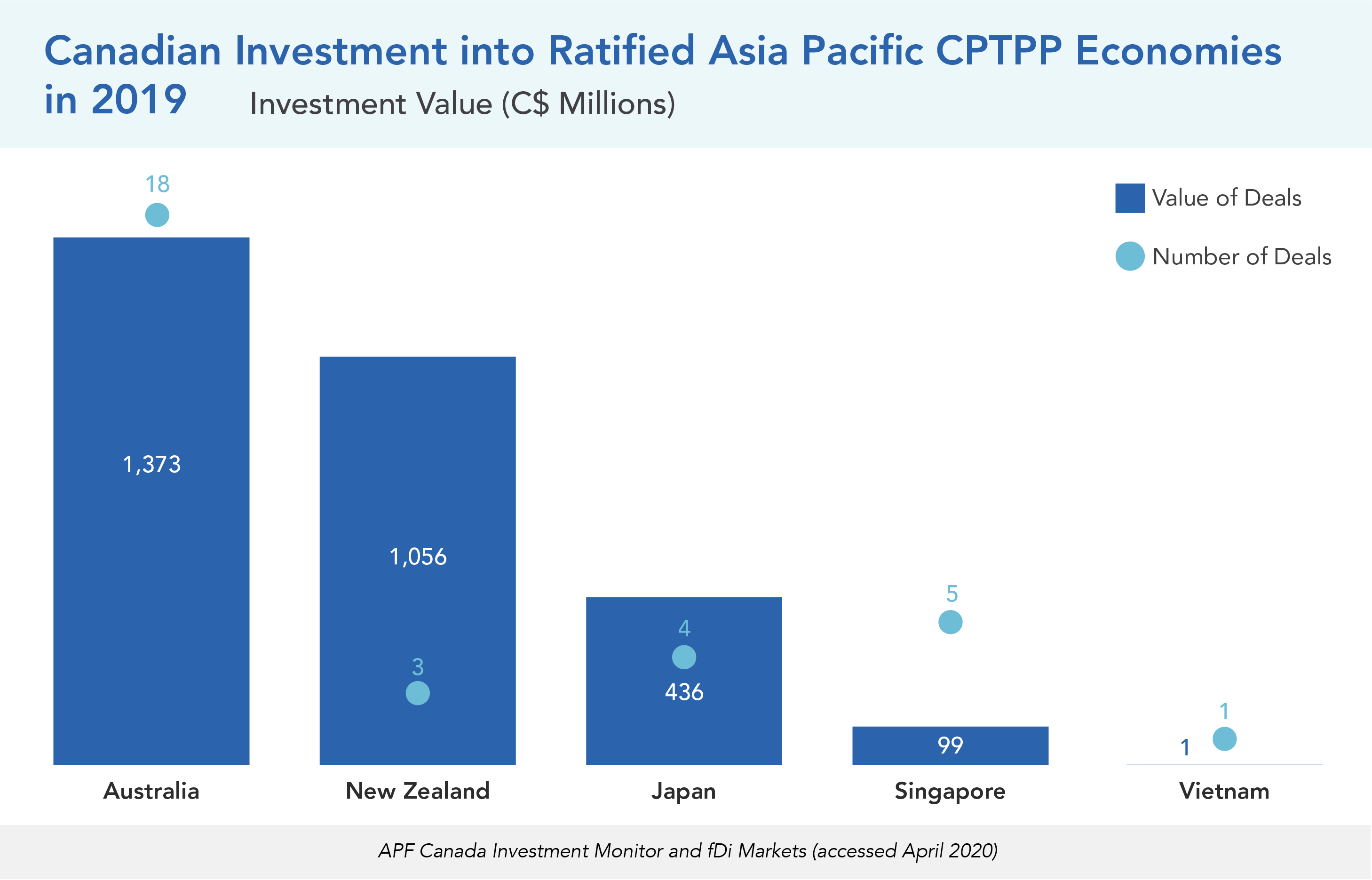
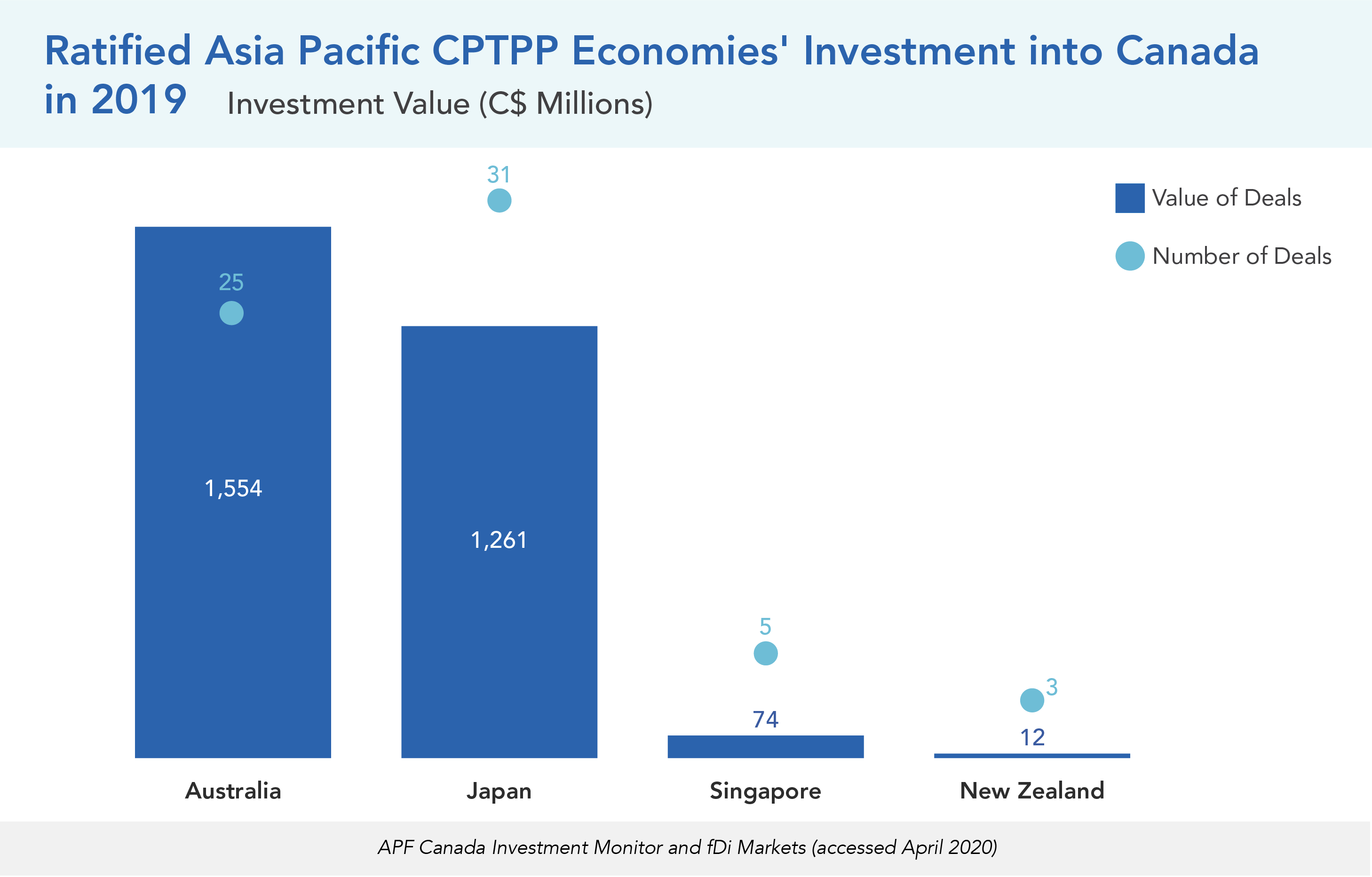
Two-way investment flows between Canada and the CPTPP economies were mostly tied to the software and computer services sector, which accounted for 25 percent (C$1.4B) of the total value of inward and outward investment in 2019. The next two biggest sectors were mining (C$1.2B) and aerospace and defence (C$963M). While the former accounted for 21 percent, the latter accounted for 16 percent in the last year. Other sectors did not receive as much investment as these three sectors received in 2019.
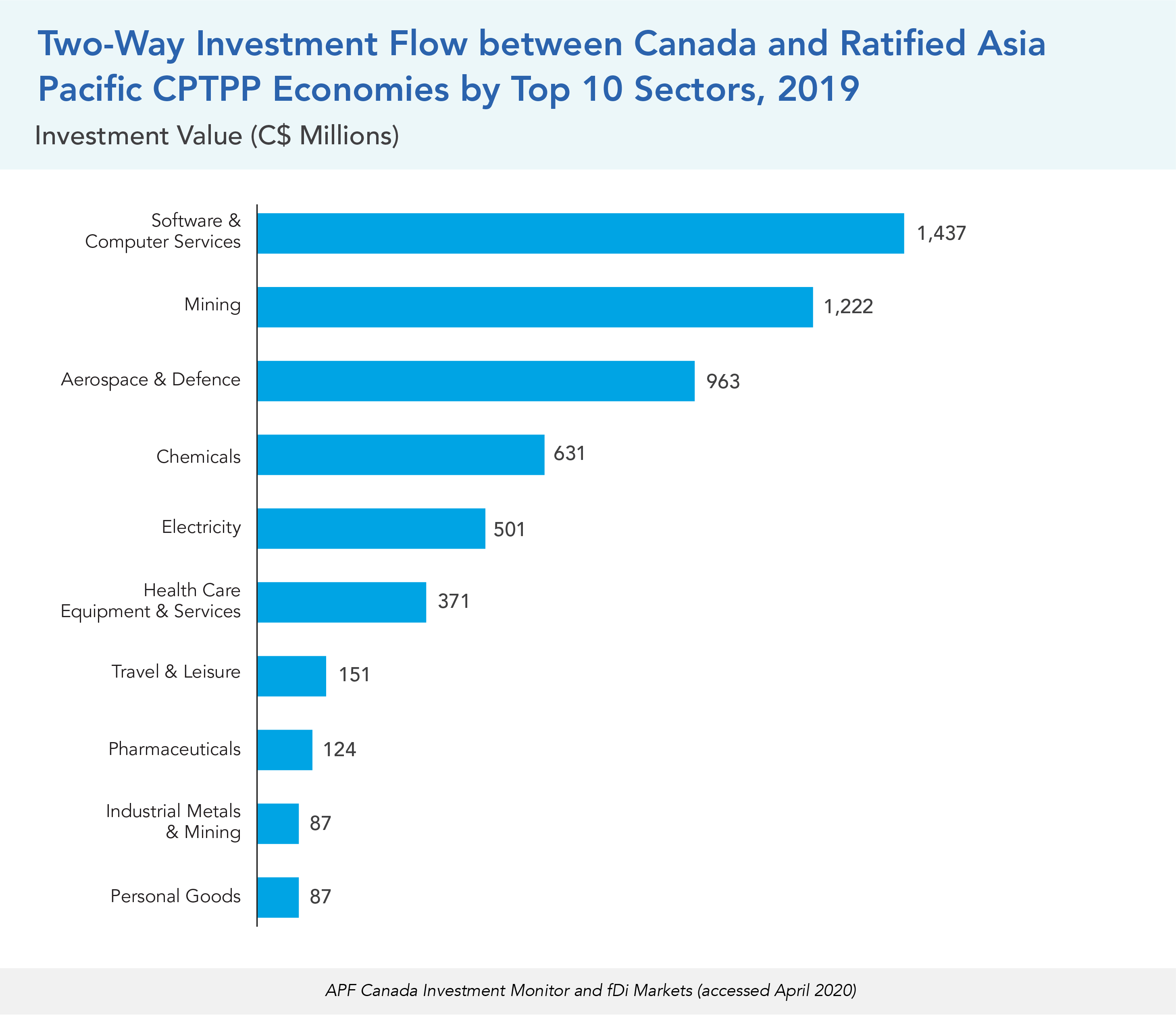
Canada-Korea Free Trade Agreement
Canada and South Korea signed their free trade agreement in 2014, and the treaty came into force in January 2015. The CKFTA contains protection clauses that aim to set out a more transparent and predictable environment for both Canadian and Korean investors.[13] After the CKFTA was ratified, there were a total of 37 investment deals between the two countries, and the value of the two-way investment flow was C$7.8B between 2015 and 2019.
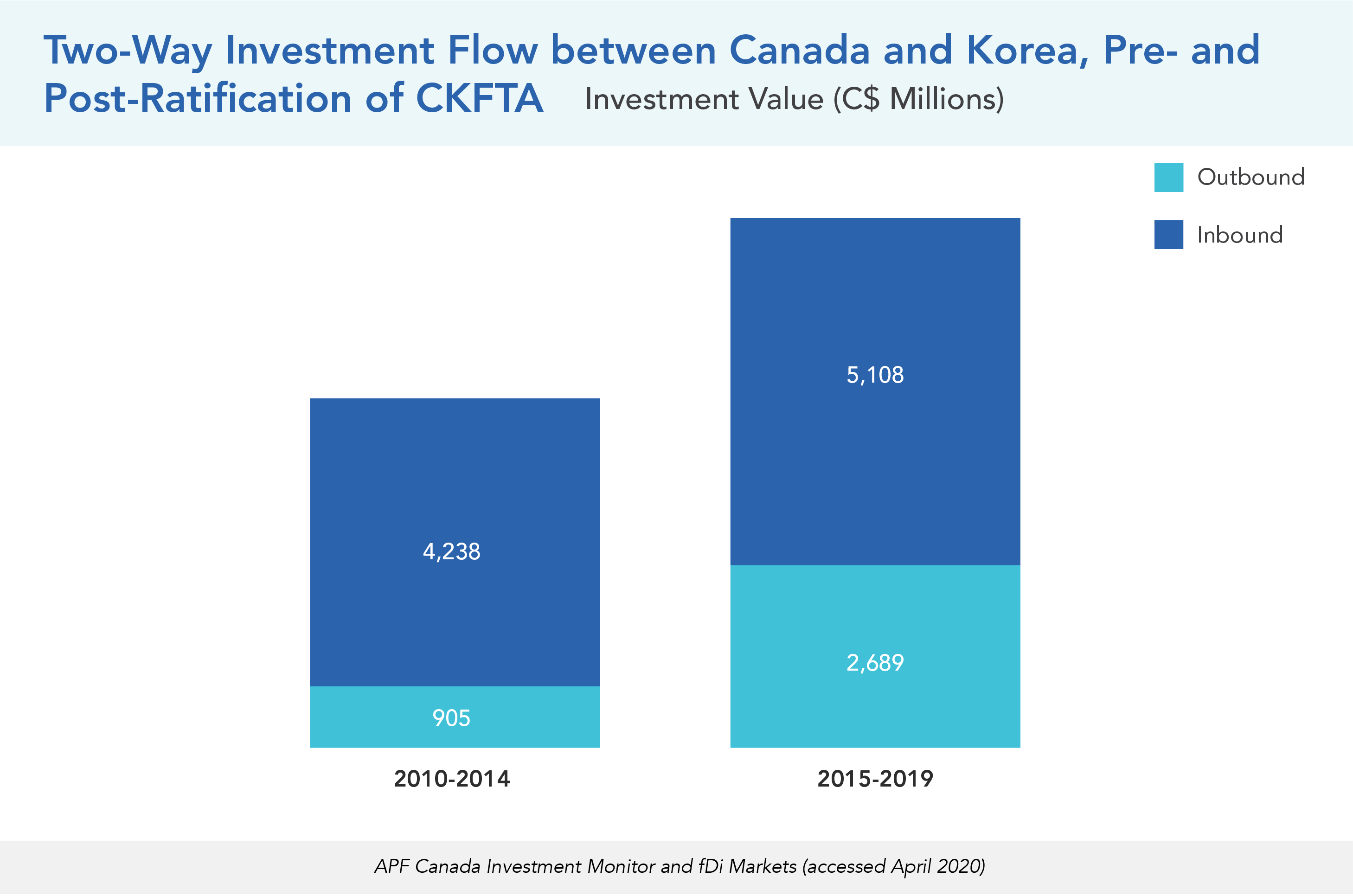
Although it has been only five years since the ratification, the value of total two-way investment flows in the period increased significantly, by 35 percent, from C$5.1B to C$7.8B. Compared to the preceding period (2010-2014), the number of total deals made between Canada and Korea increased by 16 percent, from 31 deals to 37 deals.
Over the last 10 years, Korean investment into Canada has consistently surpassed outbound Canadian investment into South Korea. Within the previous five years, inbound investment from Korea rose by 17 percent, reaching C$5.1B, from C$4.2B (2010-2014). On the other hand, interest in the Korean market by Canadian businesses surged after ratifying the FTA, reflected by the number of deals and the value of investments made from Canada to Korea. Canada invested over C$2.4B between 2015 and 2019, a 63 percent increase compared to the pre-ratification period. There were 13 deals from Canada to Korea from 2015 to 2019, while there were only nine deals in the previous five years. This growth is consistent with what the theory predicted about the positive effect of FTAs in boosting foreign direct investment for new partnerships.
In terms of sectors, Canadian investment into South Korea in the last five years focused on a few main sectors, including general retailer (28 percent), real estate investment and services (26 percent), electronic and electrical equipment (22 percent), and industrial transportation (13 percent). Two of the largest investment deals into South Korea were from one source, the Canada Pension Plan Investment Board (CPPIB). In the year the CKFTA was ratified, the CPPIB invested over C$763M in one of the largest retailers in Korea, Homeplus. Also, in 2018, the pension fund invested C$250M to own a 50 percent stake in real estate located in the centre of Seoul, the Kumho Asiana Main Tower. The CPPIB has stated that its investment in the Korean real estate sector reflected its desire to enhance the firm’s investments in the Asia Pacific region as well as its strategy to invest in top-tier, well-located properties.
In the previous five years, inbound investment from South Korea was worth C$5.1B. Of this C$5.1B, 43 percent went into the oil and gas producers sector, 32 percent into the industrial engineering sector, 8 percent into the pharmaceuticals sector, and 5 percent into the construction and materials sector of Canada. The biggest investment deal made in the oil and gas producers sector was C$2B from Korea Gas Corporation, which entered the Canadian market through its joint venture, LNG Canada, in 2018. In the same year, Korean Hanon Systems invested over C$1.6B to acquire the fluid pressure and controls business of Magna International Inc., an Ontario-based auto parts company.
LOOKING AHEAD: CANADA’S INVESTMENT TIES WITH ASEAN AND PACIFIC ALLIANCE ECONOMIES
Canada and ASEAN
ASEAN is one of the world’s fastest-growing economic regions, including Brunei Darussalam, Cambodia, Indonesia, Lao PDR, Malaysia, Myanmar, Philippines, Singapore, Thailand, and Vietnam. According to the 2019 ASEAN Economic Integration Brief, the economic growth rate of ASEAN was 5.1 percent in 2018, compared to 3.6 percent of the world growth rate. From 2003 to 2019, two-way investment between Canada and ASEAN accounted for only 13 percent of total investment between Canada and the Asia Pacific, still lagging behind the other Asia Pacific economies. Therefore, both a gap and an opportunity exist for Canada to strengthen its two-way investment ties with ASEAN and other emerging economies.
In 2019, the ASEAN economies invested over C$1.2B (12 deals) in Canada, whereas Canada invested C$238M (11 deals) in ASEAN. Those 12 deals from ASEAN economies in 2019 marked a significant increase in activity, up from seven deals for the four years prior combined. The source of investing economies (Malaysia, Singapore, and Thailand) became more diversified in 2019. Before 2019, there were only one or two economies of ASEAN, such as Singapore and Malaysia, invested in Canada. One of the sources that became active in the Canadian market in 2019 was Bangkok-based Charoen Pokphand Group, which acquired Manitoba-based HyLife for C$498M. HyLife operates in the fishing and animal production sector, focusing on producing and supplying pork products.
On the other hand, Canadian investment in the ASEAN economies shrank both in the value of investment and in the number of deals from the previous four-year period. The majority of Canadian investment to ASEAN in 2019 was in the Philippines, which accounted for 52 percent (C$124M) of the total Canadian outbound investment in the ASEAN economies. There were two big deals made into the Philippines’ financial market out of a total of 11 outward investment deals from Canada.
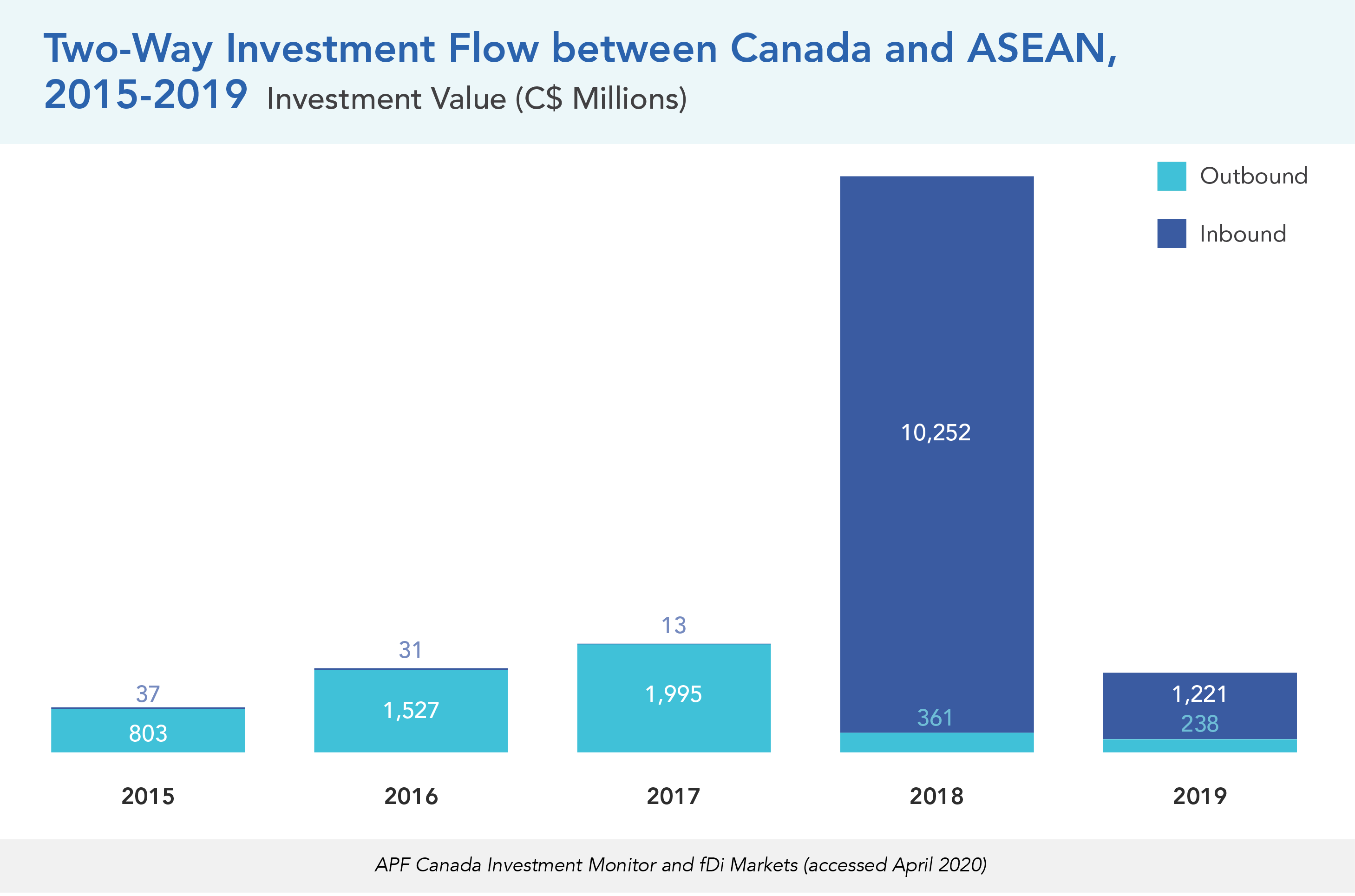
Although total two-way investment decreased significantly in 2019, the reason for the large amount of investment inflows into Canada in 2018 was one deal from a Malaysian state-owned enterprise, Petronas. The deal, which saw C$10B invested in LNG Canada, was the biggest investment made in Canada from the ASEAN economies between 2003 and 2019.
Canada and the Pacific Alliance
The Pacific Alliance is a regional economic bloc composed of Chile, Colombia, Mexico, and Peru, established in 2011. The Alliance was formed to deepen the integration between the members, promoting free trade in goods and services and increasing mobility of capital and labour within the bloc. In June 2017, Canada was invited to be an Associated State of the Pacific Alliance, which required it to begin the negotiation of an FTA with the bloc. The negotiation between Canada and the Pacific Alliance is still ongoing.[14]
In 2019, Canadian investment value in the Pacific Alliance was over C$2.6B, made through 37 greenfield investment deals. Of the total Canadian investment in the Alliance, C$1.2B (48 percent) flowed to Mexico through 18 deals, and C$678M (26 percent) went to Peru through 3 deals. Considering Colombia’s inward investment from Canada, despite a high number of deals (14 deals), the total amount of the investment barely reached C$644M. Meanwhile, Chile had only two investment deals from Canada in 2019, which accounted for C$4M. The biggest outbound deal in 2019 to the Pacific Alliance was by Vancouver-based PPX Mining Corp. in the mining sector of Peru to build a heap leach gold and silver processing plant, valued at C$655M. Meanwhile, there was only one inbound deal (C$12M) made in greenfield investments in 2019 from the Alliance, which was from Mexico to the Canadian software and computer service sector.
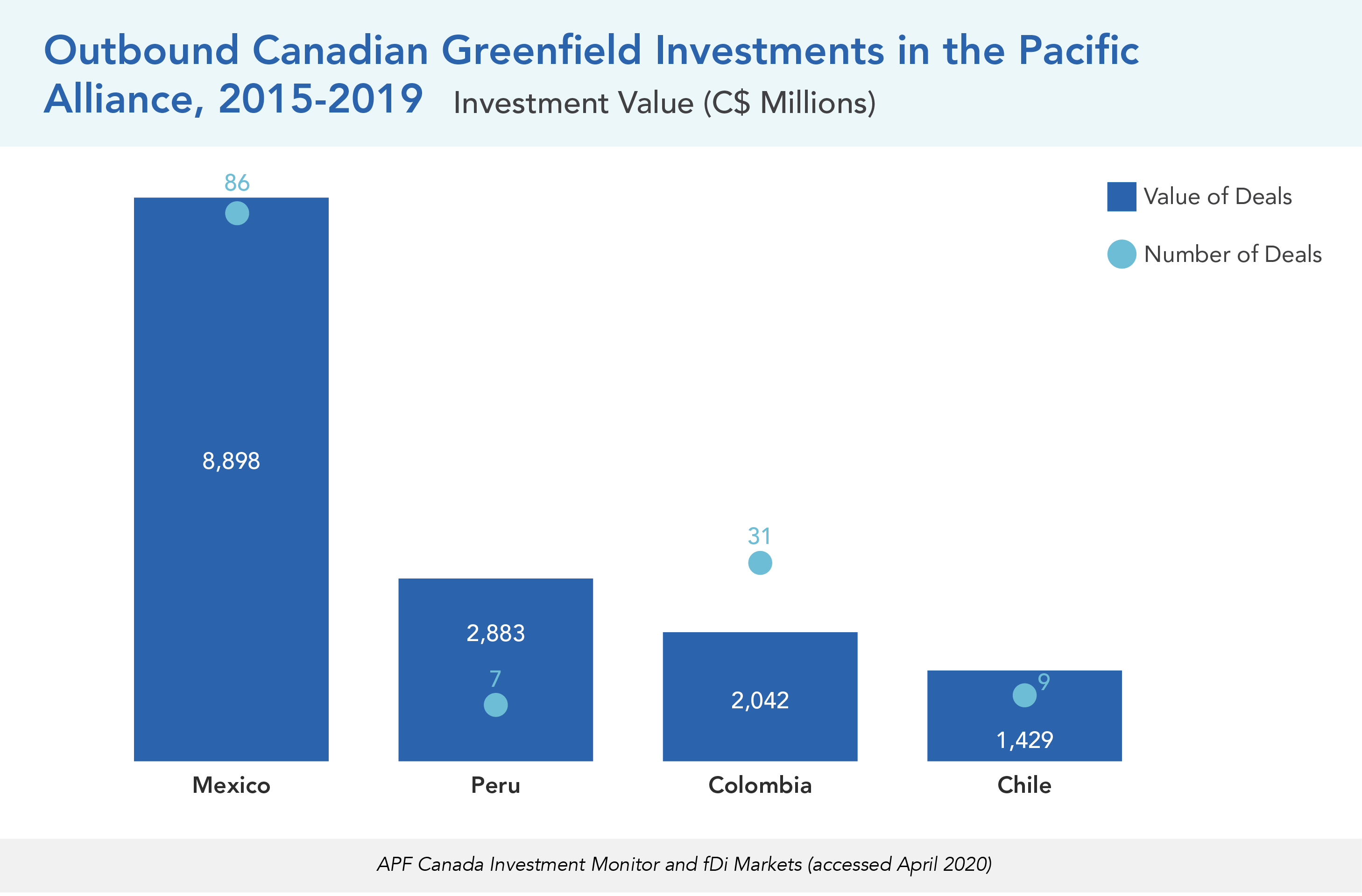
Over the past five years, Canadian investment in Pacific Alliance economies had a cumulative value of C$17.1B, and the investment flow trend has fluctuated. A majority of Canadian outbound investment in the Alliance went to Mexico, valued at over C$8.9B (86 deals). The second most popular investment destination in the Alliance for Canadian business was Peru, with over C$2.9B invested (7 deals), the third was Colombia, valued at C$2B (31 deals), and the last was Chile, with C$1.4B (9 deals) between 2015 and 2019. Despite the significant flow of Canadian investments into the bloc, the reverse flow of investment has not occurred, except for sporadic Mexican investments into Canada, which were valued at C$56M (4 deals) from 2015 to 2019. The reason for the higher investment scale between Canada and Mexico is that these two countries have a long-term partnership rooted in the North American Free Trade Agreement (NAFTA), while the other economies have only recently partnered with Canada. The additional reason is that the positive effect of FTAs on investment is stronger in developed economies and weaker when the partnership includes developing ones. Even when an FTA provides the same clauses for investment protection, the realities on the ground and the size of the market works against a stronger benefit for the developed economy, while the benefit is still there for the developing one.[15]
USAGE CHALLENGES AND FUTURE PROMISES
In all, the CPTPP adds an additional positive effect, as predicted by the theory. Within the Pacific Alliance, the economies of the CPTPP are the top investment partners of Canada in terms of the number of deals and the value of investments. Although the investment volume with the CPTPP did not increase after the FTA ratification, it is still too early to determine the potential of the FTA based on the one-year investment flows between Canada and the CPTPP.
On the other hand, the CKFTA has showed a significant increase in the number of deals as well as the value of investments between Canada and South Korea over the past five years. Thanks to the FTA, opportunities were provided not only to South Korea to increase its investment into Canada, but also to Canadian businesses to expand their investments in the South Korean market. Meanwhile, Canadian investments with ASEAN and the Pacific Alliance showed inconsistencies in investment trends, because Canada’s investment flows were often distorted by high-scale transactions, particularly in inbound investments with ASEAN in 2018. However, with the Pacific Alliance, the two-way flow in greenfield investments was mainly composed of outbound Canadian investment, the majority of which went to Mexico based on their relatively long-term partnership through NAFTA.
The Pacific Alliance represents a promise for Canadian foreign direct investment that needs to be monitored and understood in the future as Canada moves closer to securing a free trade agreement with the bloc. The economies of scale, especially in the energy and mining sectors, can be multiplied with an enhanced trade ecosystem that involves the Canadian service sector.
[5] Guzman, Andrew T. "Why LDCs sign treaties that hurt them: Explaining the popularity of bilateral investment treaties." Va. j. Int'l L. 38 (1997): 639.
[6] See Moon, Jongchol. "A Study of the Effects of Free Trade Agreements on Foreign Direct Investment." Order No. 3388134, University of California, Los Angeles, 2009. http://ezproxy.library.ubc.ca/login?url=https://search-proquest-com.ezproxy.library.ubc.ca/docview/304853969?accountid=14656. Jang, Yong Joon. "The impact of bilateral free trade agreements on bilateral foreign direct investment among developed countries." The World Economy 34, no. 9 (2011): 1628-1651.
[7] Ibid, 5
[8] Kahouli, Bassem, and Samir Maktouf. "The proliferation of free trade agreements and their impact on foreign direct investment: An empirical analysis on panel data." Journal of Current Issues in Globalization 6, no. 3 (2013): 423.
[9] Bae, Chankwon and Yong Joon Jang. "The Impact of Free Trade Agreements on Foreign Direct Investment: The Case of Korea*." Journal of East Asian Economic Integration 17, no. 4 (12, 2013): 417-444.
[10] Jang, Yong Joon. 2011. The impact of bilateral free trade agreements on bilateral foreign direct investment among developed countries. The World Economy. 34.9: 1630.
[11] See our CPTPP Tracker for examples of trade imbalances immediately after ratification. There is also abundant literature about this matter.
[12] Government of Canada. 2020. Comprehensive and Progressive Agreement for Trans-Pacific Partnership (CPTPP). https://www.international.gc.ca/trade-commerce/trade-agreements-accords-commerciaux/agr-acc/cptpp-ptpgp/index.aspx?lang=eng
[13] Government of Canada. 2017. Canada-Korea Free Trade Agreement (CKFTA). https://www.international.gc.ca/trade-commerce/trade-agreements-accords-commerciaux/agr-acc/korea-coree/summary-sommaire.aspx?lang=eng#2
[14] Government of Canada. 2019. Canada-Pacific Alliance Free Trade Agreement. https://www.international.gc.ca/trade-commerce/trade-agreements-accords-commerciaux/agr-acc/pacific-alliance-pacifique/index.aspx?lang=eng
[15] Jang, op. cit., p. 9.
The National Picture
KEY SECTION TAKEAWAYS
- Between 2016 and 2019, Canada received C$60B in inbound investment from the Asia Pacific through 413 deals, hitting a 16-year high.
- While investments from the Asia Pacific into Canada are still primarily in natural resources, which comprises the energy, mining, and agriculture industries, inbound investments in the technology sector have been increasing, from C$396M from 2008 to 2011, to C$1.7B from 2016 to 2019.
- Since 2003, Australia, China, and India have been the top destinations for outbound Canadian investment into the Asia Pacific. Investment in these economies totalled C$136.7B, accounting for 73 percent of all outbound investment to the region.
- In 2019, 17 percent of Canadian investment went to the automobiles and parts sector, with a dollar value of C$1.3B. Most of these deals involved the establishment of new manufacturing plants for electric cars in China.
INBOUND TRENDS AND PARTNERS IN A YEAR OF RECORD DEALS
In 2019, Canada received a total of C$8.3B of foreign direct investment from Asia Pacific economies. While it was a drop from the historic high of C$33B in 2018, of which the liquefied natural gas (LNG) project in Kitimat made up close to C$25B, the number of inbound investment deals in 2019 set a record with 151 deals.
From 2015 to 2019, Canada received C$56B of Asia Pacific investment through 428 deals, hitting a 16-year high. Compared to the previous four-year period, inbound investment from the Asia Pacific has jumped by C$9B, or 19 percent. Other than the well-known LNG project in 2018, one of the largest Asia Pacific investments came in 2019, when Jiangxi Copper Corporation acquired PIM Cupric Holdings Limited from Pangaea Investment Management Limited for C$1.5B.[16]
Over the last 16 years, Asia Pacific investment into Canada has been growing both in terms of the investment amount and the number of deals. In this period, APF Canada’s Investment Monitor has captured approximately C$161B in investment through 997 deals. The bulk of the investment came in the last eight years, accounting for 66 percent of the captured investment.
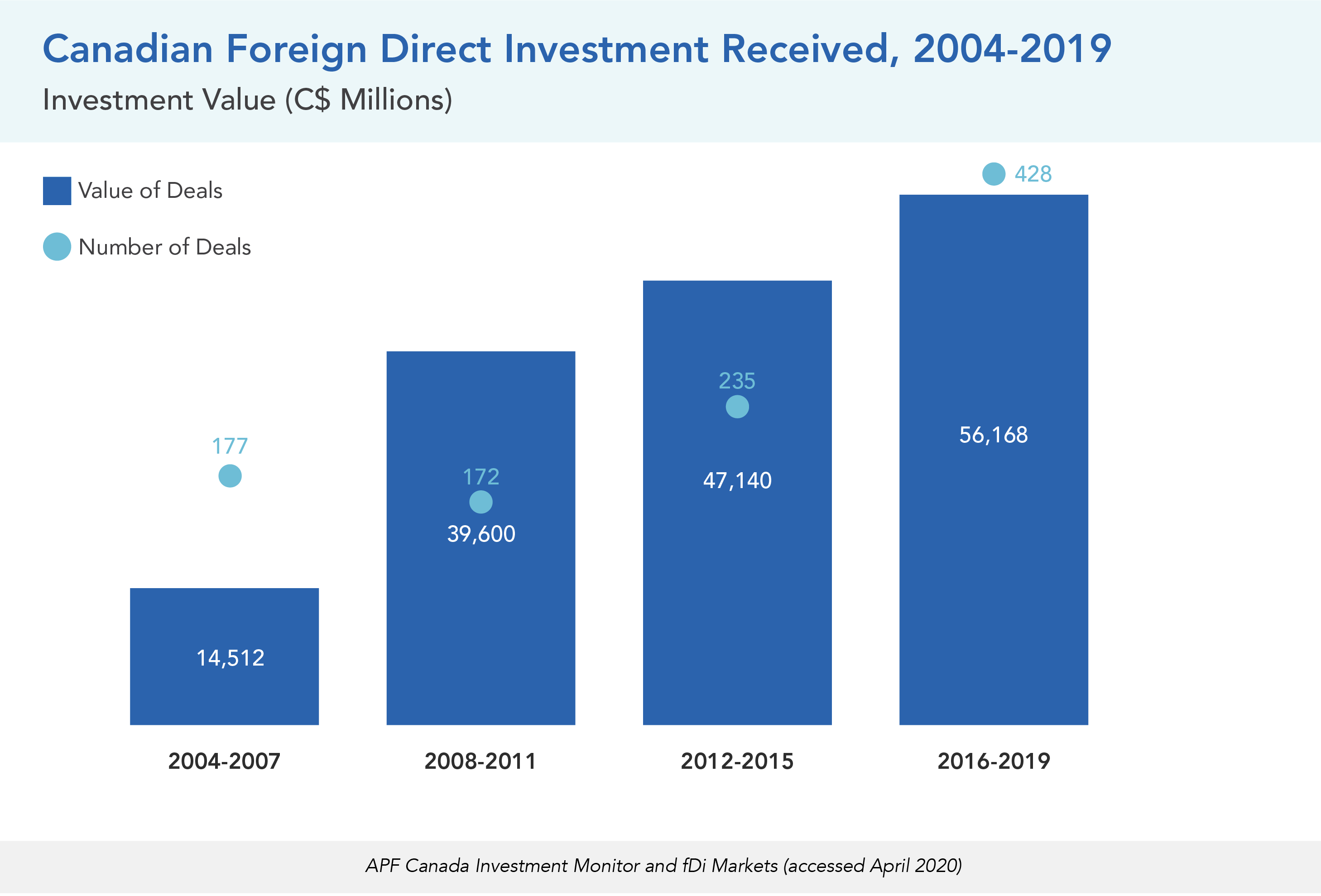
While high-dollar-value investments continue to have significant sway in shaping the total amount of inbound FDI from the Asia Pacific to Canada, the sharp increase in investment deals in the 2016 to 2019 period renders a lower concentration of investment per transaction in comparison to the previous four-year period. The average investment per deal has dropped from C$201M in the 2012 to 2015 period to C$131M in the most recent four years. This figure suggests that while Asia Pacific investment into Canada continues to grow in dollar amount, investment activities ¬– an indicator of investment ties – are increasing at a more rapid pace and smaller-dollar-amount investment forms a growing proportion of inbound investment into Canada.
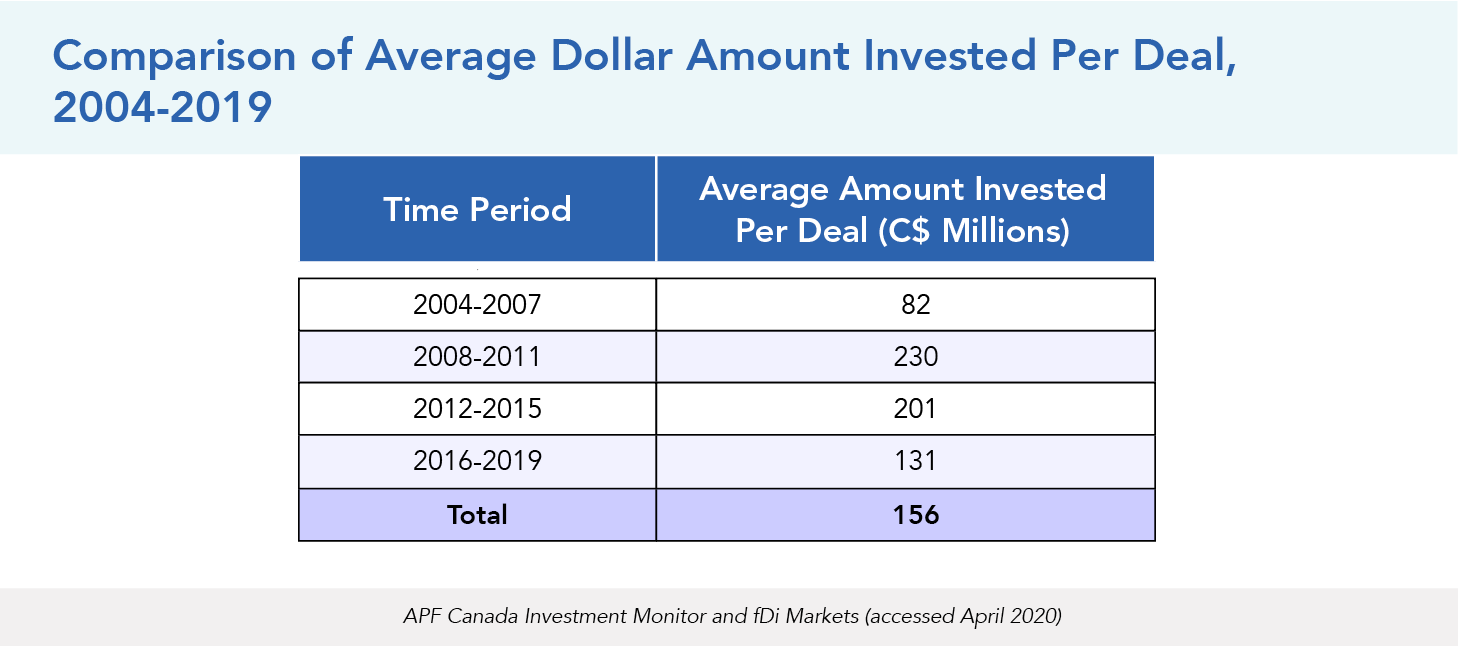
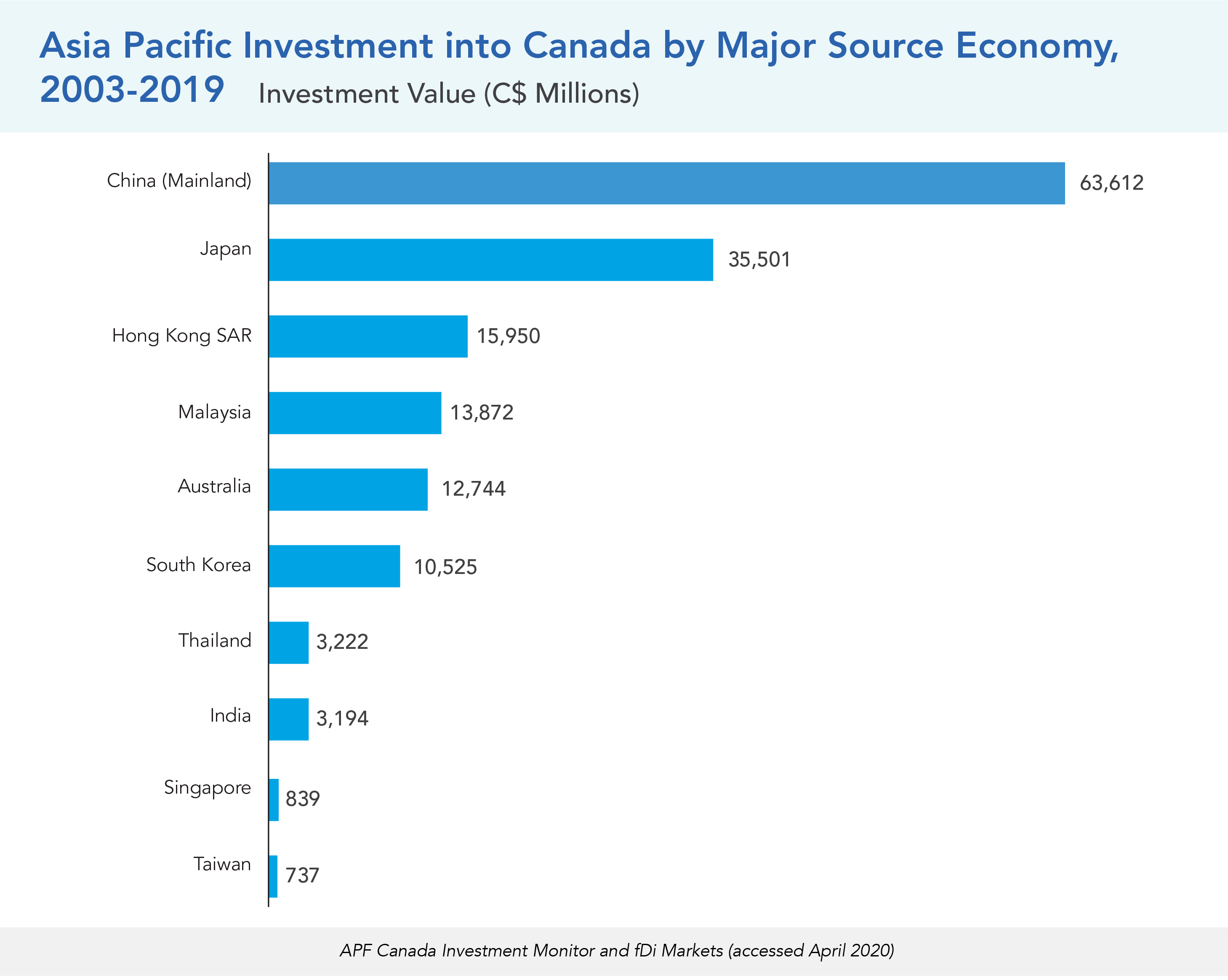
Consistent with previous reports, inbound Asia Pacific investment into Canada has been highly concentrated in a few source economies. The top three source economies alone account for 72 percent of the total Asia Pacific inbound investment into Canada. Over the last 17 years, China remains Canada’s top investor in the region with C$64B injected into Canada’s economy through 275 deals, followed by Japan with C$36B through 292 deals and Hong Kong with C$16B through 74 deals.
China remained the top Asia Pacific FDI source economy for Canada in 2019 with C$3.5B of investment injected into the Canadian economy. The value of new investments from China dropped significantly between 2018 and 2019, with the impact attributable to the significant investment made by China in the LNG project in 2018. Without the China-sourced investment in LNG in 2018, the investment levels between 2018 and 2019 would be roughly the same (C$4.0B and C$3.5B, respectively).
However, China’s investment has subsided in the last four-year period compared to earlier periods. Chinese investment into Canada has decreased from C$27B in the 2012 to 2015 period to C$21B in the most recent four-year period, a C$6.6B, or 24 percent, drop. In comparison to the previous four-year period, Chinese investments are less concentrated in the Canadian oil and gas sector, but China has developed a more diversified portfolio with investments in the mining, real estate investment and services, and health care equipment and services sectors.
Canada has seen dollar-value growth in its inbound Asia Pacific investment from both traditional and non-traditional economic partners. Over the last eight years, investments from Malaysia, Hong Kong, South Korea, and Japan have seen the sharpest increase. The four economies combined represent growth of C$18B when comparing the data between the two most recent four-year intervals. The bulk of the increase is driven by Canada’s oil and gas sector. For Japan, Malaysia, and South Korea, the growth mostly stemmed from their respective investments into the construction of the LNG Canada facility in Kitimat 2018, whereas Hong Kong’s increase can be attributed to CK Hutchison’s C$2.3B investment via Husky Energy into an offshore oil exploration project near St. John’s, Newfoundland, in 2017.
ASIA PACIFIC INVESTMENT IN CANADA’S SECTORS: RESOURCES, TECHNOLOGIES, AND THE REST
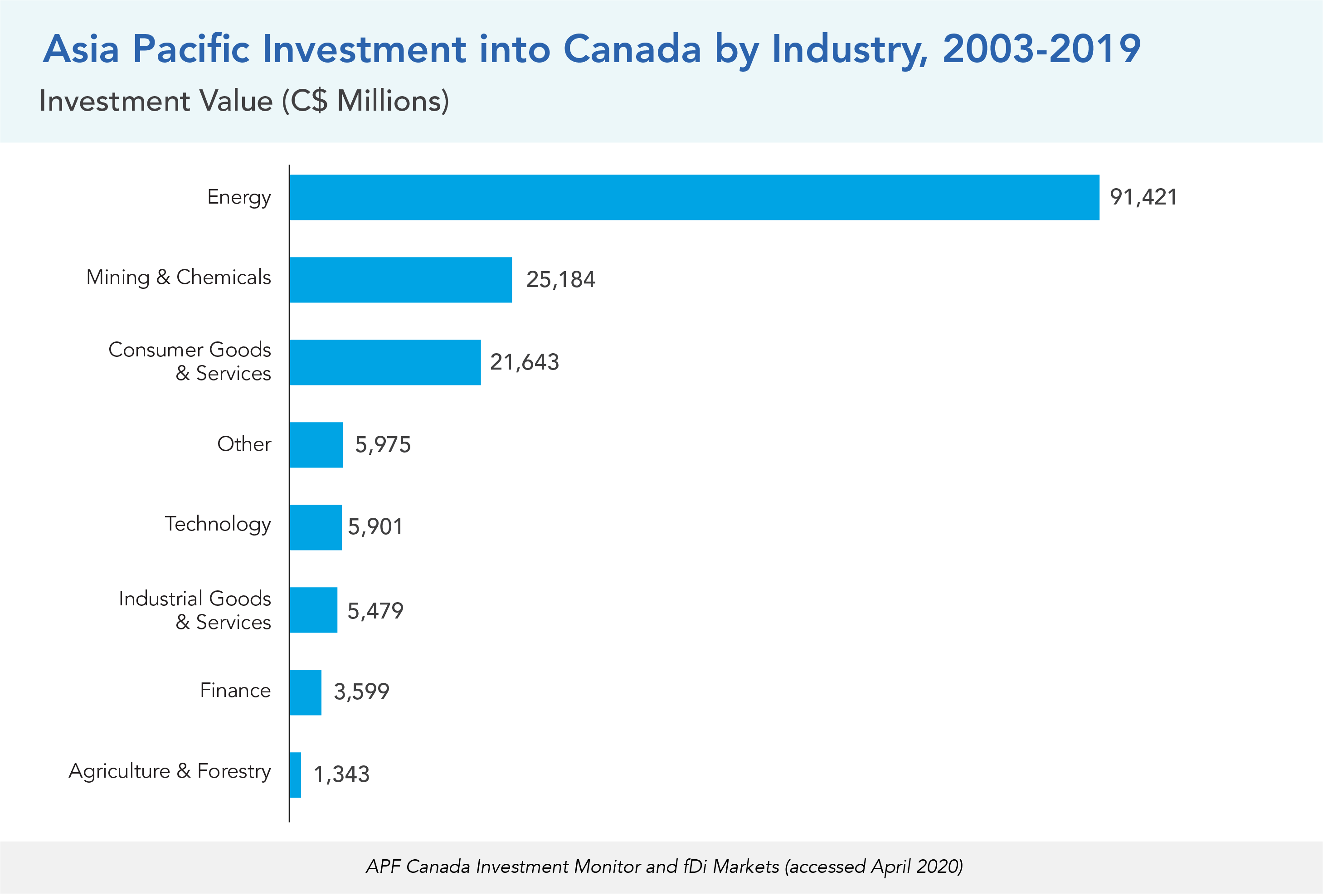
Investments from the Asia Pacific into Canada are still primarily in natural resources, which comprises the energy, mining, and agriculture industries. In 2019, half of all inbound investments were in the mining and chemicals industry. This includes the largest deal made in 2019: the C$1.5B acquisition of a 17.6 percent stake in Vancouver-based First Quantum Minerals by Chinese state-owned enterprise (SOE) Jiangxi Copper, through its purchase of PIM Cupric Holdings. This investment is closely followed by the C$1.3B acquisition of Continental Gold by another Chinese SOE, Zijin Mining. Zijin Mining’s acquisition of Toronto-based Continental Gold is its second in Canada, following the company’s 2018 acquisition of Nevsun Resources for C$1.9B. In contrast, Jiangxi Copper’s acquisition of a stake in First Quantum Metals is its first deal in Canada.
Another noteworthy deal in the mining industry is the acquisition of Halifax-based Atlantic Gold Corporation and Atlantic Mining NS Corp for C$723M by Australian company St. Barbara Ltd. This acquisition is St. Barbara’s first Canadian mine, adding to its existing assets in Western Australia, Papua New Guinea, and the Solomon Islands. Considering other investments in natural resources, one notable deal in 2019 occurred in the agriculture industry. Manitoba-based pork producer and supplier La Broquerie was acquired for C$498 by Thailand-based Charoen Pokphand Foods PCL through its Canadian subsidy.
As for the main sectors of inbound investment in Canadian natural resources, in 2019 the mining sector received the highest dollar amount, made up of the deals mentioned above. Overall since 2003, the top sector continues to be oil and gas production, totalling C$83.1B. From 2016 to 2019, this sector again tops inbound investment at C$30.4B, remaining largely consistent with the 2012 to 2015 period, when the sector received C$30.6B. For the mining sector, there was a substantial increase in investments, from C$1.9B from 2012 to 2015 to C$7.3B during the 2016 to 2019 period. This increase is largely due to acquisition deals in 2018 and 2019.
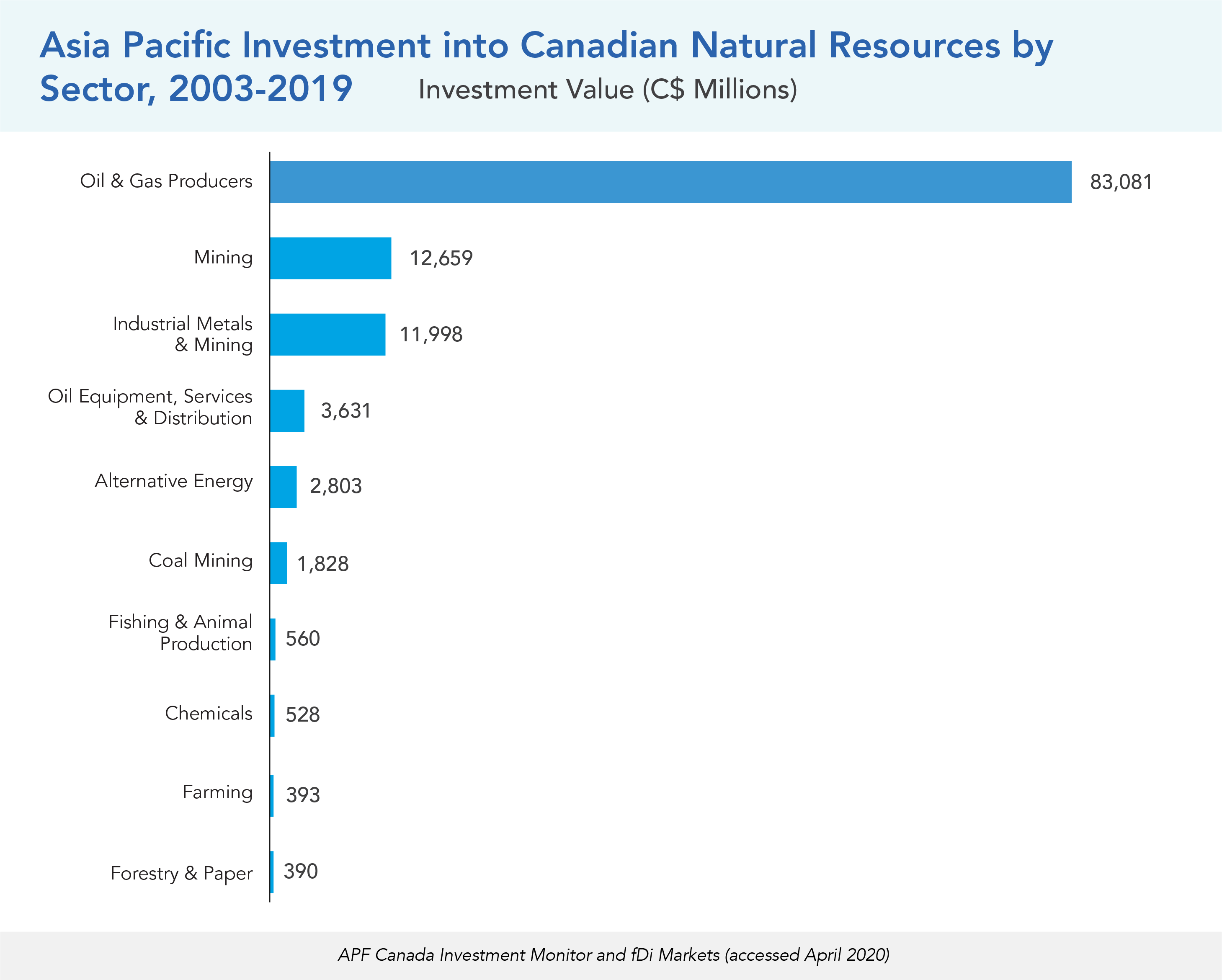
While natural resources are by far the largest area of inbound investment from the Asia Pacific, there is also substantial investment being made in other sectors. Among these, automobiles and parts is the largest, with C$14.1B invested since 2003. This is followed by the software and computer services sector at C$3.7B and the travel and leisure sector at C$2.8B. Investments in these sectors mainly come from Japan and China, with the exception of travel and leisure, which is dominated by Hong Kong-based investors.
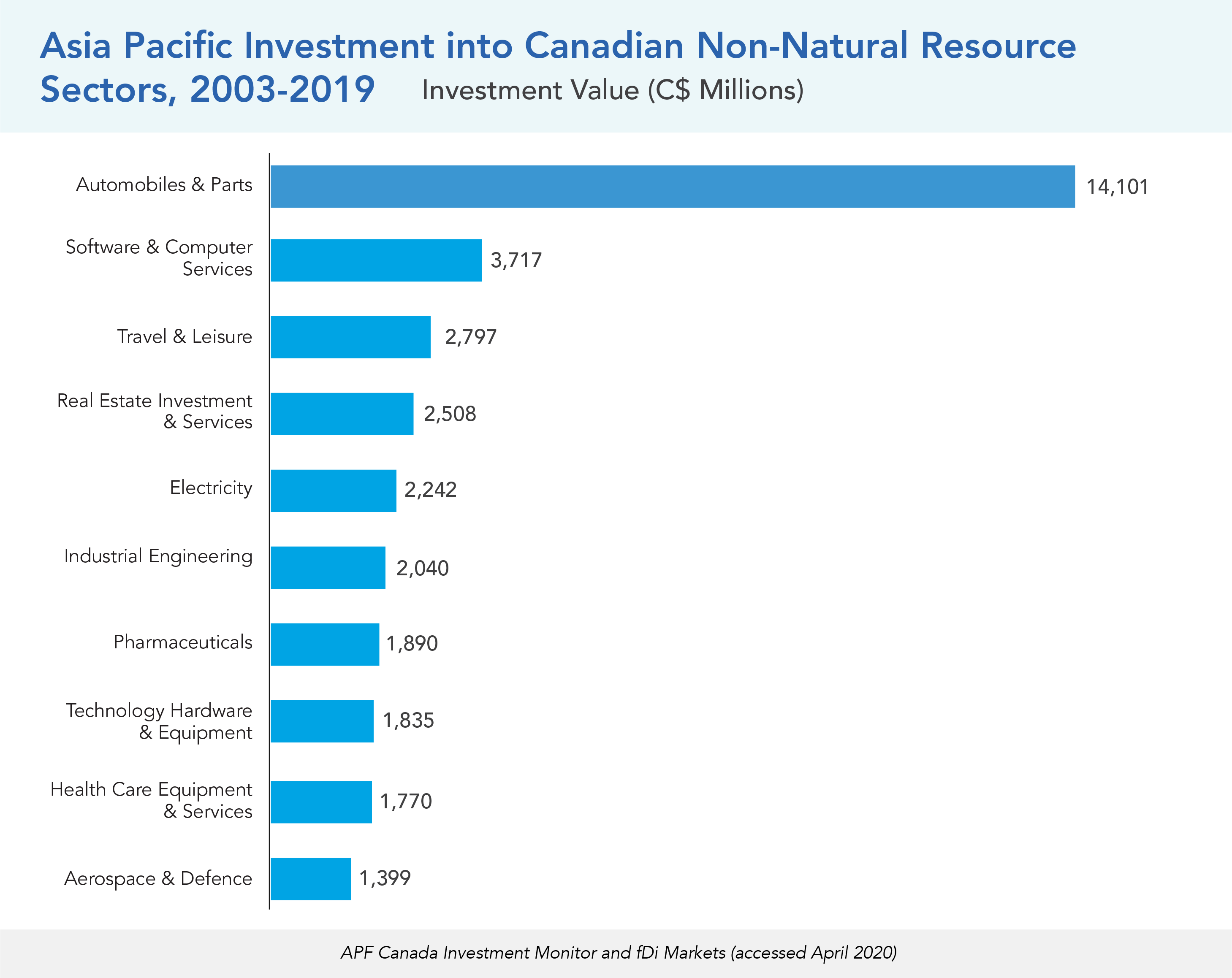
One growing area of inbound investment is the technology industry. The number of deals in technology has steadily been rising, from 13 during the 2008 to 2011 period, to 67 during the 2016 to 2019 period. Investment amounts have also risen, from C$396M in 2008 to 2011, to C$1.7B in 2016 to 2019. From 2016 to 2019, 32 percent of investment in Canadian tech was located in Toronto, while Montreal and Vancouver received 13 percent and 7 percent shares, respectively. In 2019, the largest deal was China-based Huawei Technologies’ C$452M expansion of its operations in Canada. Another notable deal in 2019 was Indian multinational tech company HCL Technologies’ C$213M investment in a new office in Moncton, New Brunswick.
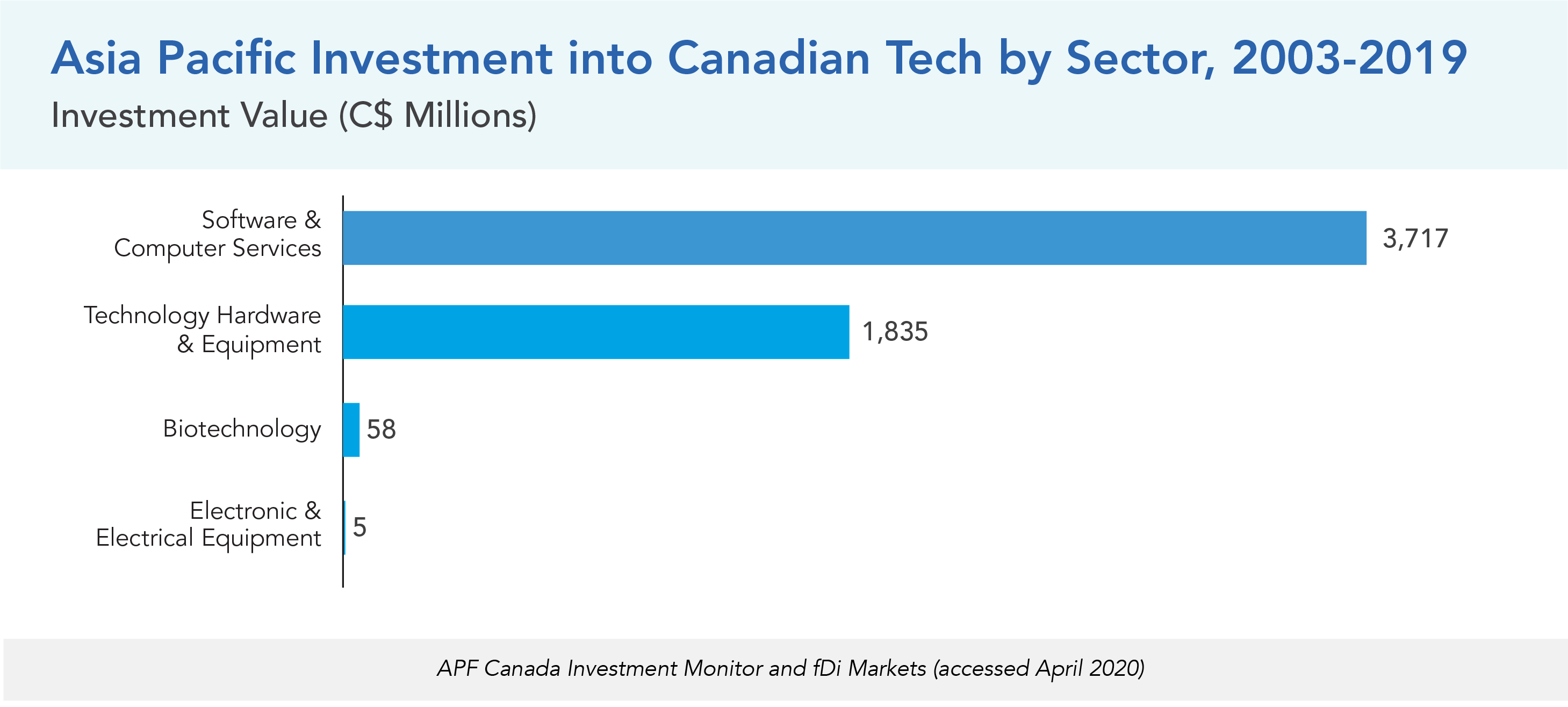
Canada’s natural resource industries (energy, mining and chemicals, and agriculture and forestry) have been significant drivers of investment from the Asia Pacific and accounted for 74 percent (C$120B) of the total value of investment from 2003 to 2019. Of total investments in the industry, the energy sector had a majority share at 75.6 percent (C$91.4B), while the mining and chemical sector and the agriculture and forestry sector account for 23.3 percent (C$28B) and 1.1 percent (C$1B), respectively.
Investment inflows from the Asia Pacific experienced a peak of 40 percent (C$48.2B) of total investment in the industry during the 2011 to 2014 period, when Canada had a large-scale C$16.7B investment deal when Nexen was purchased by the China National Offshore Oil Corporation in 2013. However, the inward flows of investment in the industry have been decreasing since 2013 because of declining commodity prices and a lack of big deals. Investments from the Asia Pacific into Canada’s natural resource industry continue to persist, however. For instance, in the energy sector, LNG Canada, a joint venture comprised of multiple companies from Canada and Asia, invested C$24.5B into Canada’s oil and gas producers in 2018.
Within Canada’s natural resources industries, investment in the agriculture and forestry sector was not as big as it was in other sectors. One of the largest deals in the sector was a purchase of the assets of the Terrace Bay Pulp Mill in Ontario by India-based Aditya Birla Group for C$279M in 2012. Moreover, no investments were recorded between 2016 and 2018 in the sector. However, in 2019, Thailand’s Charoen Pokphand Foods acquiring Manitoba-based HyLife for C$498M was one of the highlights in the sector.
Canada is a global hub for video games. With appealing tax incentives and globally recognized creative talent, Canada has attracted renowned foreign studios, like the French company Ubisoft and American studios Epic Games and Electronic Arts, to settle in cities like Montreal and Vancouver. Beloved game franchises like Ubisoft’s Assassin’s Creed series and Epic Games’ online game Fortnite are being developed in Canada with homegrown talent. Overall, according to the Entertainment Software Association of Canada, the Canadian video game industry contributed C$4.5B to national GDP in 2019. (Moreover, an estimated two-thirds of Canadians are gamers.) It comes as no surprise that studios based in the Asia Pacific are also interested in benefitting from Canada’s growing video game industry. According to the Investment Monitor, from 2005 to 2019, C$1.3B in investment arrived from the region into Montreal, Vancouver, Burnaby, Toronto, and Saskatoon.
Montreal, in particular, has become one of the top cities in the world for video game development. Called by some the “Hollywood of video games,” Montreal is the fifth most popular city for game development, after Tokyo, London, San Francisco, and Austin. This is largely thanks to Quebec’s multimedia tax credit, which subsidizes up to 37.5 percent of labour costs for eligible companies that develop digital products. One notable studio that has chosen to put down roots in Montreal is Square Enix, a Japanese game developer globally renowned for its Final Fantasy and Kingdom Hearts game franchises. In 2007, Square Enix invested C$226M to establish its first studio in Montreal, named Eidos-Montréal. It has since invested in expanding the studio in 2011 and 2019. Eidos-Montréal is best known for producing games in the Tomb Raider and Deus Ex franchises. Most recently, in 2019, one of China’s top online game providers, NetEase, invested C$130M into a new studio focused on research and design. NetEase is known for publishing games like Crusaders of Light and UNO! the mobile game.
However, not all inbound investments have been successful. In 2005, Japanese developer Koei Tecmo invested C$380M to establish a Canadian subsidiary and studio in Toronto. The studio, responsible for games like Fatal Inertia and Samurai Cats, eventually closed in 2013. In 2014, Japanese company Gumi invested C$176M in its first Canadian studio in Burnaby. Gumi is well-known in Japan for the mobile role-playing game Brave Frontier. However, after 18 months and no titles released, Gumi closed its doors in 2016, along with its other studios in Sweden, Germany, the United States, and Hong Kong. There are several reasons for each closure. For Koei, observers attribute its closing to unpopular titles as well as competition from Ubisoft, once the French studio settled in Toronto in 2010. For Gumi, its closures are seen as a consequence of rapid hyper-expansion.
Overall, while some big players like Square Enix have found success in Canada, others like Gumi have not. Reasons for closures vary across studios, from releasing unpopular titles, losing provincial tax incentives, merging with a bigger studio, and competition. Considering these barriers, provincial governments must go beyond just attracting studios to settle in their cities, and work toward sustaining their long-term presence.[17]
INVESTMENT TYPES: GREENFIELD INVESTMENT VS. M&A
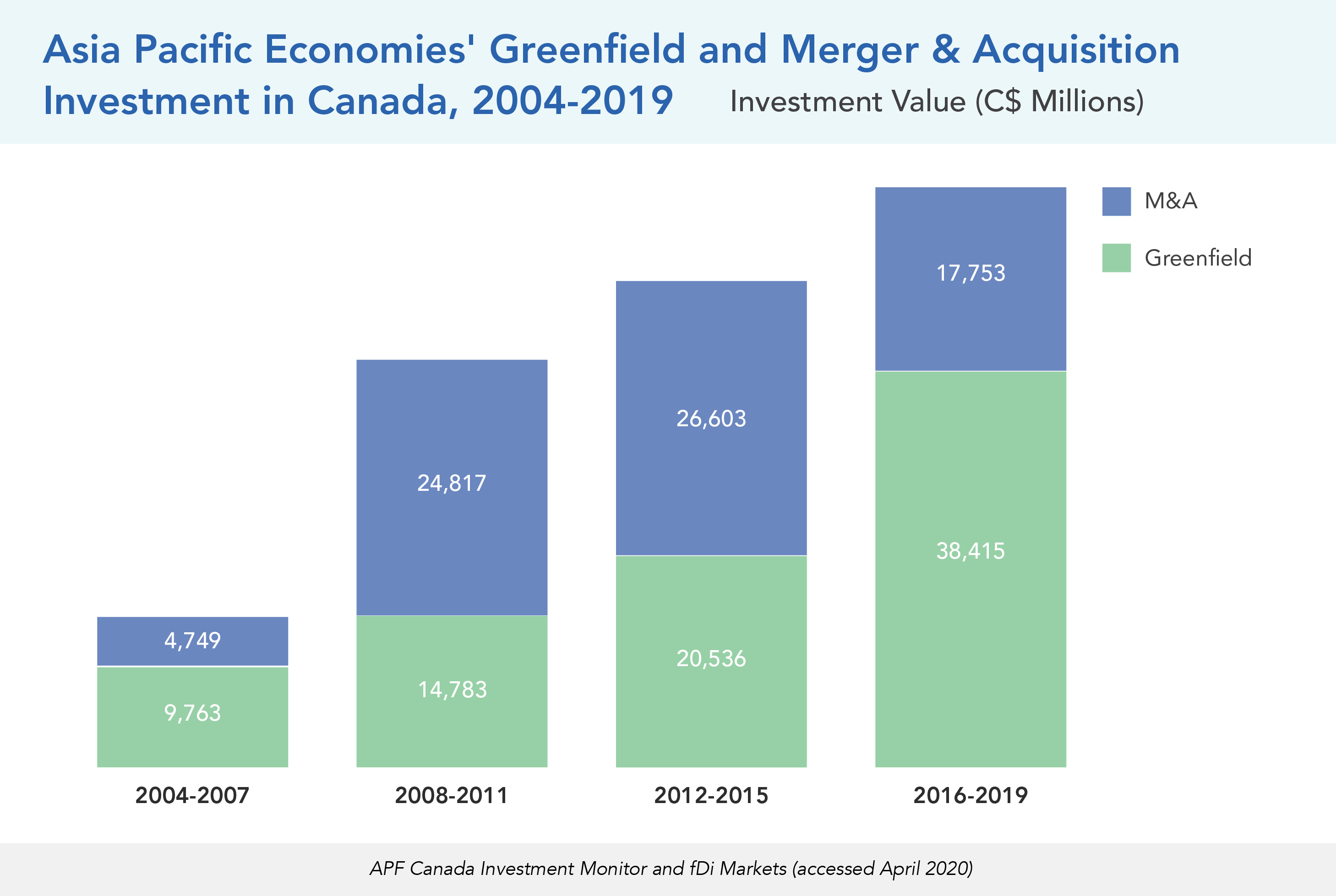
Overall, Asia Pacific investments into Canada are greenfield-oriented. In last 16 years, greenfield deals account for 62 percent of all inbound investment transactions from the Asia Pacific, while mergers and acquisitions (M&A) only make up 38 percent. However, given that M&A transactions on average carry a higher dollar value per transaction, they make up a larger proportion of the inbound investment value compared to deal numbers. Over the last 16 years, M&A makes up 47 percent of the value of inbound investments from the Asia Pacific, while greenfield investments account for 53 percent.
In the most recent four-year period, greenfield investments remained the dominant mode of entry for Asia Pacific companies. From 2016 to 2019, greenfield investments accounted for 247 of the 428 deals (58 percent) and C$38B of the C$56B inbound Asia Pacific FDI (68 percent). Compared to the period from 2012 to 2015, greenfield investments have increased by C$18B in dollar value and 89 in deal count.
While inbound Asia Pacific M&A investments continued to grow in number of deals, the dollar value of this mode of entry slightly dropped over the last eight years. From 2016 to 2019, Asia Pacific companies invested C$18B into Canada through 181 M&A deals. Compared to the previous four-year period (2012-2015), Asia Pacific M&A investments from 2016 to 2019 more than doubled in deal count, but dropped by C$9B in dollar value.
STATE-OWNED ENTERPRISES IN CANADA: DESPITE THE PUBLIC ATTENTION, A DECLINING FACTOR
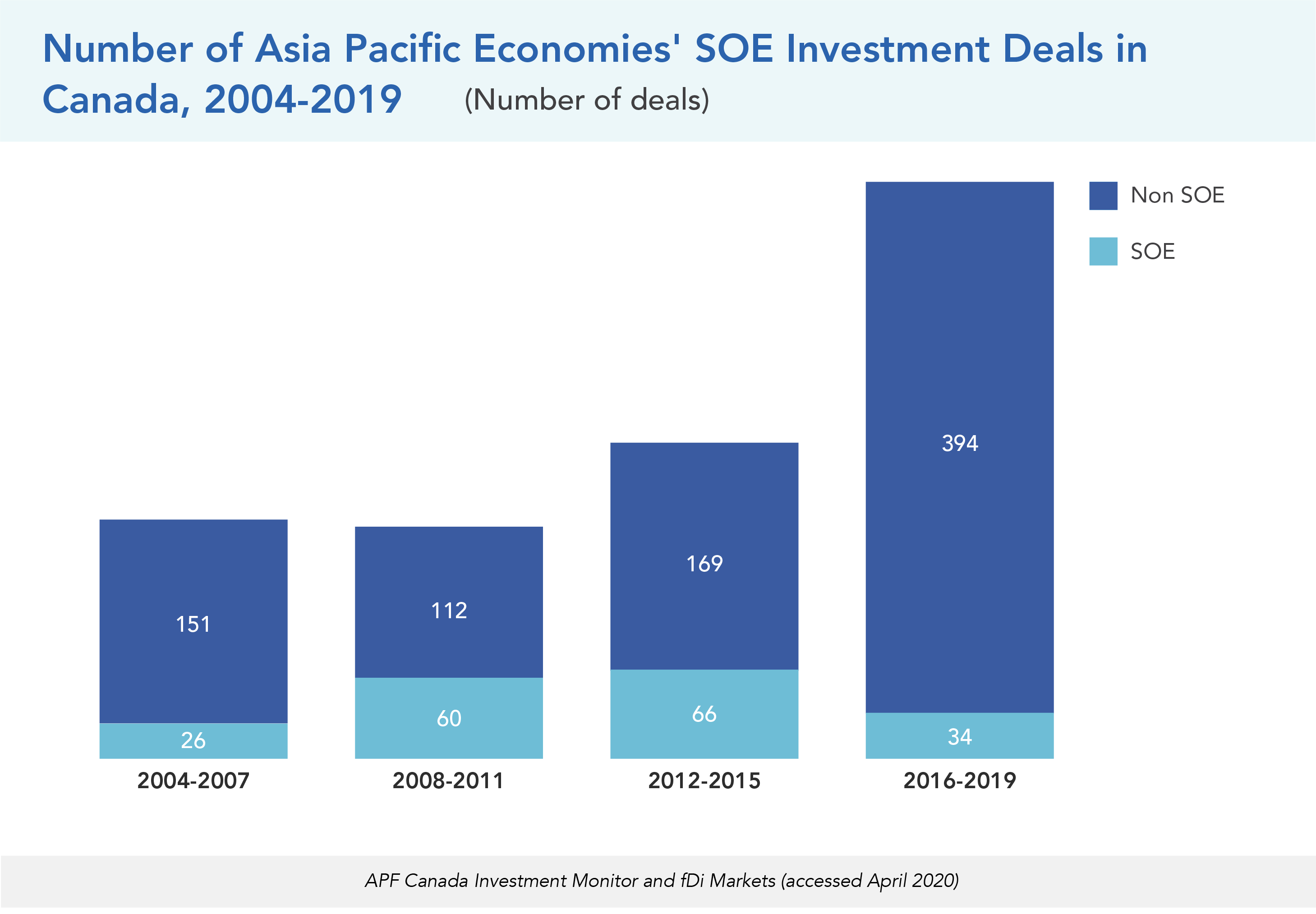
APF Canada’s 2019 National Opinion Poll showed that Canadians are more skeptical of inbound Asia Pacific investments from SOEs in the high-tech sector. Compared to investments from a privately owned company, investments from SOEs are five percentage points more likely to be disapproved of by Canadians.[18]
While Asia Pacific investments by SOEs into Canada had steadily grown from 2004 to 2015, activities subsided in the most recent four-year period. From 2016 to 2019, there were 34 inbound investment deals by Asia Pacific SOEs, and this number was less than half that of the 2012 to 2015 period. In the same period, China remains the most active source of SOE investments, accounting for 18 of the total 34 SOE deals.
The most recent four years have also seen a substantial increase of non-SOE investment in comparison to the 2012 to 2015 period. Between 2016 and 2019, non-SOE investment was at a 16-year high with 394 transactions, more than doubling the deal count from the previous four-year period. China, Japan, and India are the top sources of Asia Pacific non-SOE investment, with 95, 87, and 62 inbound deals, respectively.
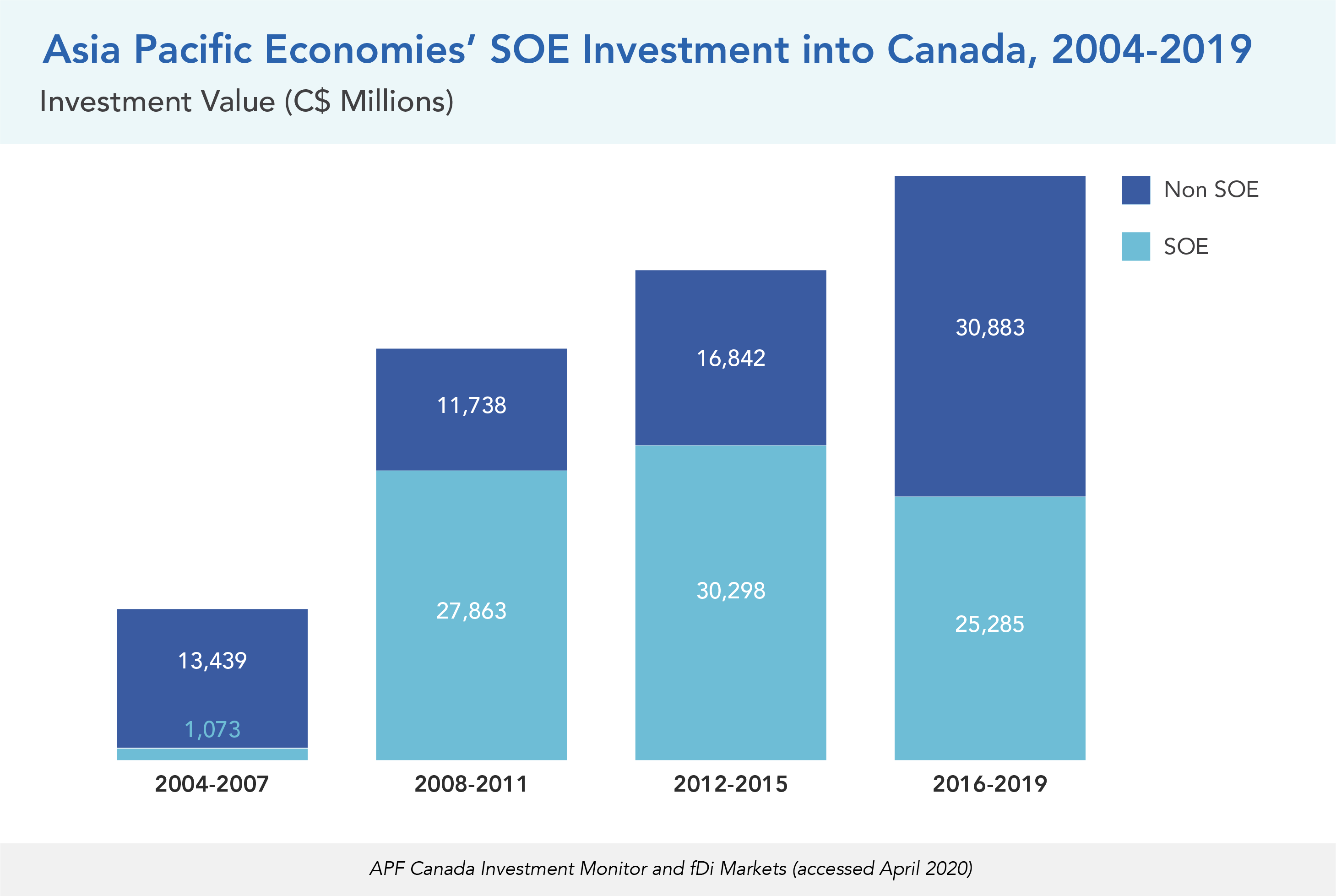
A similar picture can be painted when looking at Asia Pacific SOE investment in dollar value. As Figure 15 shows, investments into Canada from Asia Pacific SOEs peaked in the 2012 to 2015 period with C$30B and declined to C$25B in the 2016 to 2019 period. As Asia Pacific SOE investment into Canada has dropped, inbound non-SOE investment from the region has skyrocketed. Canada saw C$31B of investment by Asia Pacific non-SOEs in the latest four-year period, an 83 percent increase from the 2012 to 2015 period.
During the 2008 financial crisis, Canadian FDI inflows from Asia Pacific economies remained strong as a new wave of investments led by China’s “Go Global” policy in Canada started. In 2008, Canada received C$5.2B in investment from the region, an 85 percent increase from the previous year’s total of C$2.8B. Furthermore, in 2009, Canadian inbound investment from the Asia Pacific reached C$7.3B, a 42 percent increase from 2008. During the economic crisis, three economies – China, Japan, and Australia – dominated Canadian inbound investment. The biggest source economy between 2008 and 2009 was China with C$5.8B, accounting for 46 percent of the total C$12B of investment from the Asia Pacific. Meanwhile Japan invested C$4.6B, making up 37 percent of the total amount. Lastly, Australia invested C$1.7B, accounting for 14 percent of the total investment inflow from the region during this period.
The biggest deal made in 2008 was a C$1.2B investment by the Japanese automaker Toyota Group in the Canadian automobiles and parts sector, for a new auto assembly plant in Ontario. In 2009, the biggest deal was a C$2.3B investment by Chinese SOE China National Petroleum Corp. in the Canadian mining and oil and gas sector, when it acquired 60 percent of the shares of Calgary-based Athabasca Oil Sands Corp.
On the other hand, outbound Canadian investment into the Asia Pacific amounted to C$17B in 2008, a 35 percent increase from the previous year’s total of C$12.6B. However, in 2009, Canadian outward investment dropped by 43 percent to C$9.7B. Between 2008 and 2009, China saw the lion’s share of Canadian investment, receiving C$8.6B and accounting for 32 percent of the total C$26.7B of outward investment flows to the region. In second place, Vietnam received C$5.6B, accounting for 21 percent of the total outward investment, while in third place Australia received C$4.2B, accounting for 16 percent. India also received C$3B of investment from Canada (11 percent), making it the fourth-largest recipient among the Asia Pacific economies during the economic crisis.
In 2008, the biggest outbound Canadian investment to the Asia Pacific was made by Toronto-based Asian Coast Development Ltd. with a C$5.1B investment in the Vietnamese travel and leisure sector to build a casino and beach resort. In 2009, the biggest deal was made by Toronto-based Brookfield Asset Management with a C$1.4B investment in Sydney-based Babcock & Brown Infrastructure to acquire a 40 percent stake of the firm.
OUTBOUND TRENDS AND PARTNERS: CANADA CONDUCTING FEWER DEALS, WITH FEWER DOLLARS
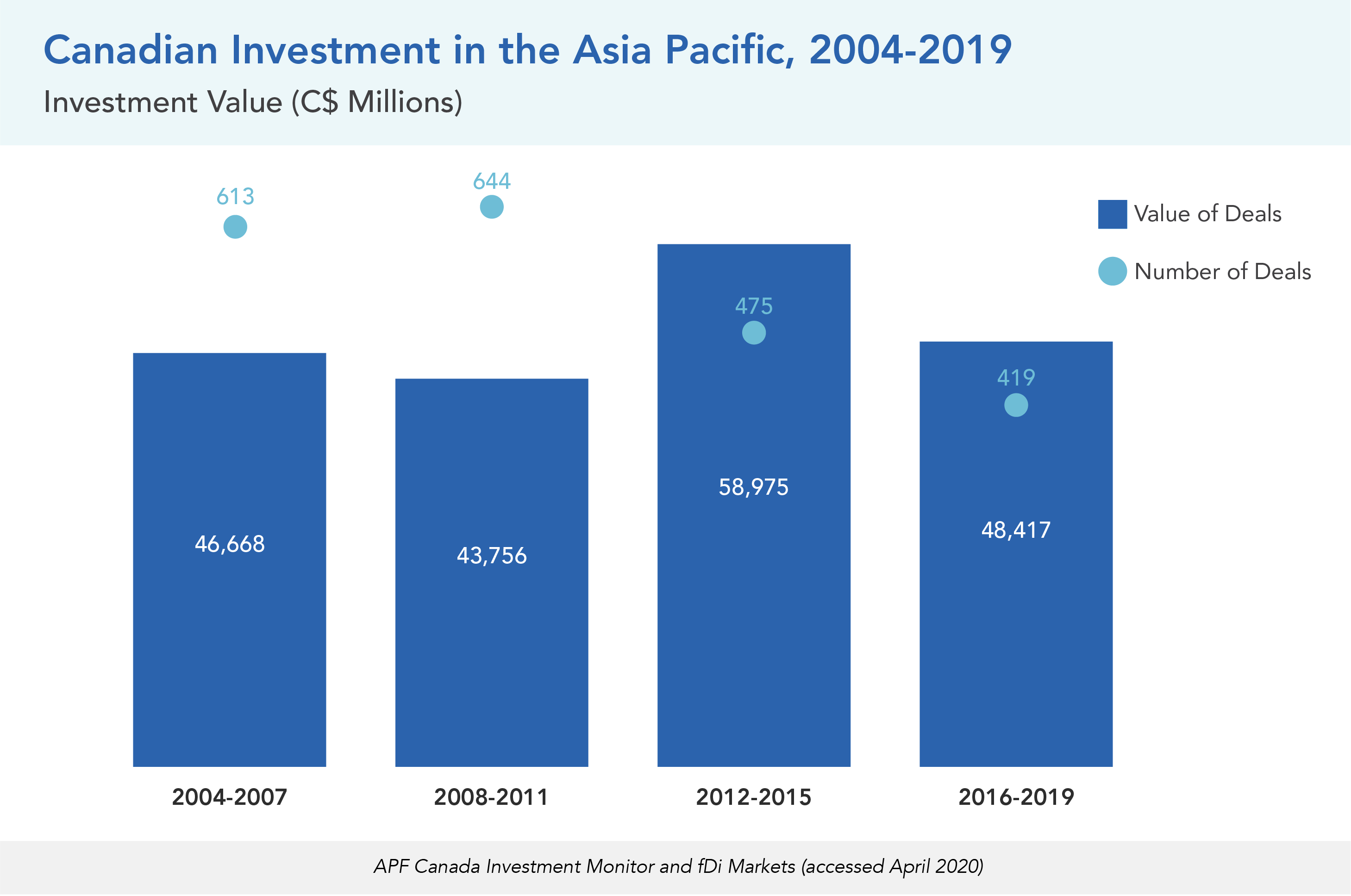
Canada has invested C$198B in the Asia Pacific economies over the last 16 years through 2,151 transactions. It reached its peak in the 2012 to 2015 period with C$59B. Outbound Canadian investment to the Asia Pacific has since seen a slight drop in the most recent four years. From 2016 to 2019, Canada invested C$48B into the Asia Pacific region. While the investment value in this period was C$10.6B lower than the previous four-year period (2012- 2015), it remains slightly above the two four-year periods before 2011.
In 2019 specifically, Canadian outbound FDI to the Asia Pacific was valued at C$7.2B, a significant drop from the C$18B in 2018. Deal counts also dropped and reached the lowest since 2003 with only 75 outbound FDI deals made that year. The trend in the deal counts in the last 16 years suggests that Canadian companies’ investment interest in the Asia Pacific has declined since 2012. In particular, in the latest four years there has only been 419 outbound investment deals from Canada to the Asia Pacific. This deal count is 12 percent less than the 2012 to 2015 period, which had 475 deals.
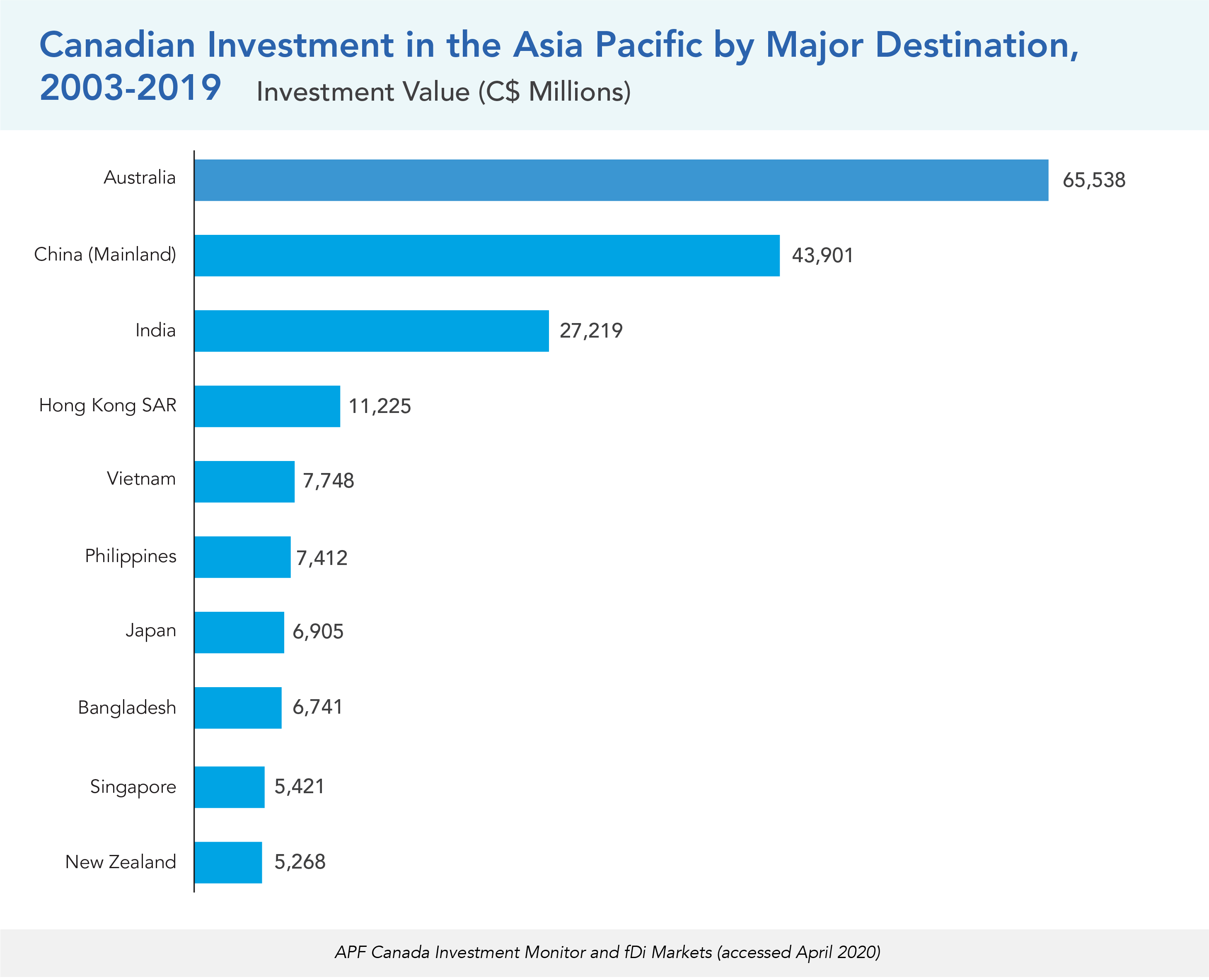
From 2003 to 2019, Australia, China, and India were the top destinations for outbound Canadian investment in the Asia Pacific. In this period, the Investment Monitor captured C$66B, C$44B, and C$27B of outbound Canadian investments into Australia, China, and India, respectively. The three economies account for 73 percent of outbound investment into the Asia Pacific region in this period.
India, in particular, has seen a surge in Canadian investment interests. In 2019, the country saw close to C$2B of Canadian investment over 16 deals, making India the second-largest recipient of Canadian outbound FDI that year. In the most recent four-year period, India received more than C$9.4B of investment from Canada, C$1.7B more than the amount of Canadian investment into China. Compared to the 2012 to 2015 period, Canadian outbound investment into India in the most recent four years has jumped by C$5.7B, more than a 150 percent increase. The increased Canadian investment interest in India is also confirmed by deal counts, as the number of outbound investment deals to India increased from 51 transactions in the previous four-year period to 72 from 2016 to 2019.
The Toronto-based Brookfield Asset Management Inc. has become one of the most active Canadian players in the Indian market. In the last four years, the company has invested more than C$2B in the country with a focus on the country’s real estate investment and services and technology hardware and equipment sectors. One of its biggest investments came in 2016 when Brookfield acquired retail and offices spaces from Hiranandani Group for C$1B. Brookfield made another significant investment in India 2019, as the company made a C$493M acquisition in the Mumbai-based telecom tower company Reliance Industrial Investment and Holdings limited. In its press release, the CEO of Brookfield Infrastructure explained the move, saying that “this is a unique opportunity to invest in a large-scale, high-quality telecom business and participate in India’s high-growth data industry.”[19]
CANADA INVESTING IN A VARIETY OF SECTORS
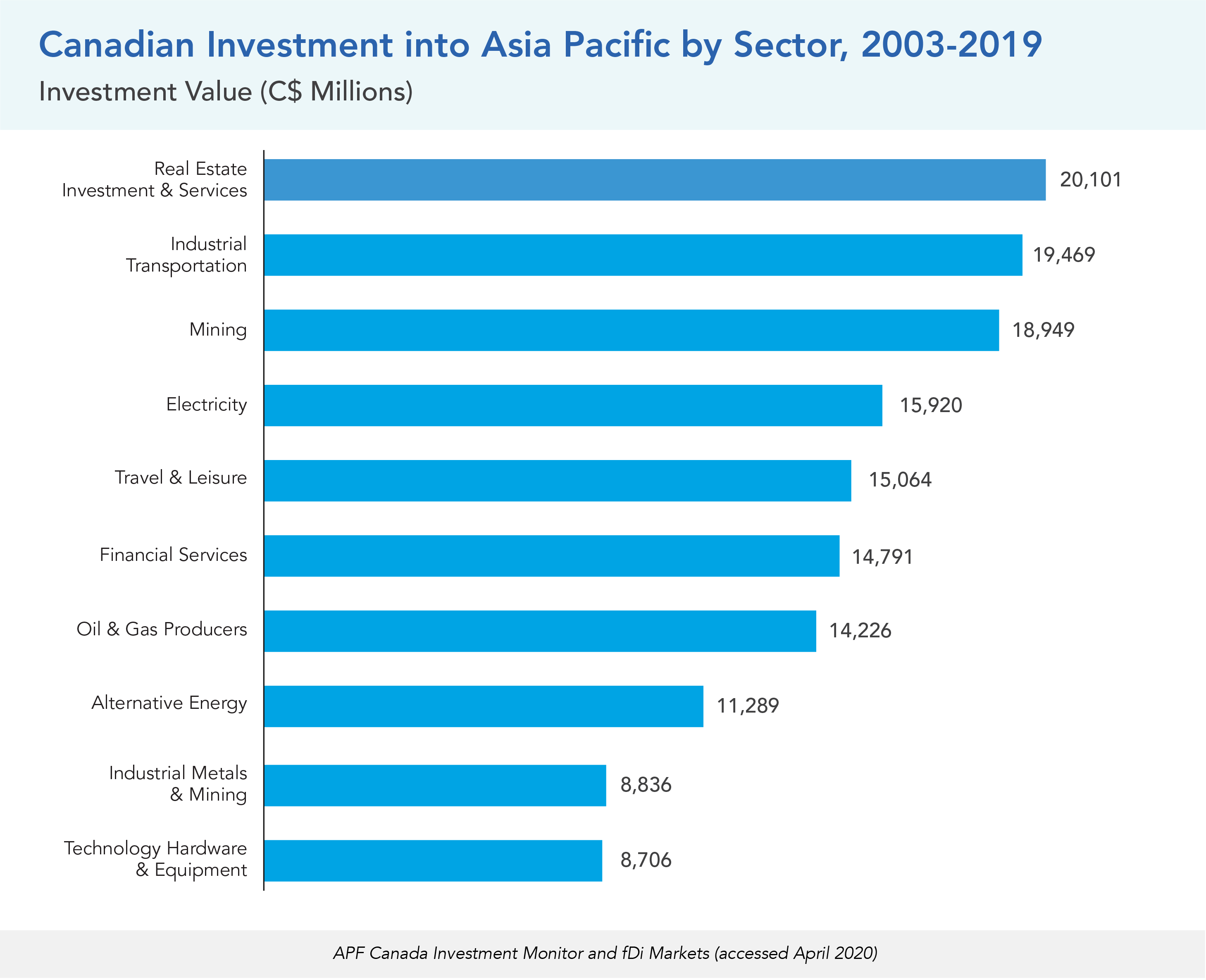
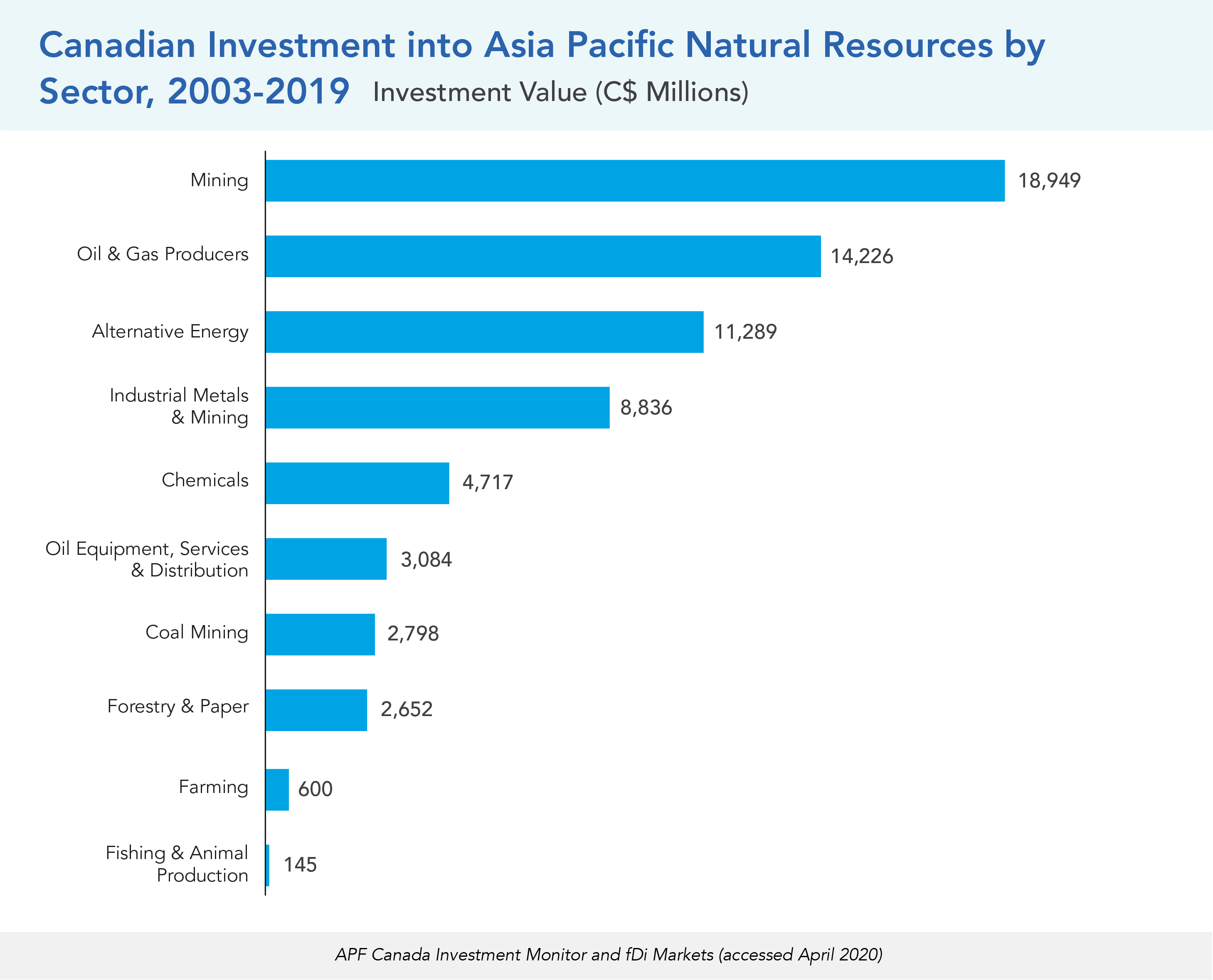
The top sectors for Canadian investment in the Asia Pacific continue to be industrial transportation, real estate investment and services, and mining. Real estate investment and services has been the top sector of outbound investment since 2003. The sector is worth C$20.1B and makes up almost 10 percent of all Canadian outbound investments to the region. It is followed by industrial transportation at C$19.5B and mining at C$18.9B, making up 9 percent each of Canada’s total outbound investment. The mining sector notably fell to third place from its previous ranking as the top sector in the last annual report.
For 2019, 17 percent of Canadian investment went toward the automobiles and parts sector, with a dollar value of C$1.3B. The majority of these deals involved the establishment of new manufacturing plants for electric cars in China. The largest deal is from electric car manufacturer Electra Meccanica Vehicle Corp., which invested C$798M into a new production facility in Chongqing, China. The second biggest deal is Magna International’s joint venture with China-based BAIC Group to build an electric car factory for C$398M in Zhenjiang, China.
Canadian investment in the Asia Pacific’s energy industry peaked in the 2012 to 2015 period, at C$12.4B, more than doubling its previous value of C$5.3B during the 2008 to 2011 period. However, for 2016 to 2019, this value fell to just C$673M. The reason for this decrease is several large deals from 2012 to 2015. The biggest of these took place in 2015, made by SkyPower, Baytex Energy Corp., and Fulcrum Environmental Solutions Inc. SkyPower is a Toronto-based solar power producing company that invested C$6.1B in Bangladesh’s solar power sector. Baytex Energy Corp. is a Calgary-based oil and gas company that acquired Australia-based Aurora Oil & Gas Limited for C$2.9B. Fulcrum Environmental Solutions Inc. is an Edmonton-based clean technology company that invested C$1.2B worth of proprietary technology into China-based DGF Shandong Industries Corporation’s new clean-coal thermal steam power facility.
On the other hand, Canadian investment in the region’s mining and chemicals industry has significantly decreased. The industry experienced a 73 percent drop in investment since the 2008 to 2011 period, from C$6B during this time to just C$1.6B during the current period (2016-2019). However, 2019 saw several notable deals for the industry. The largest deal is Toronto-based global agribusiness Nutrien’s C$623M acquisition of Australian agricultural merchandiser Ruralco. This is followed by two Toronto-based mining companies’ expansions of operations in Australia, namely Kirkland Lake Gold’s C$361M expansion of its Fosterville mine, and RNC Mineral’s C$361M expansion of its Kambalda mine.
Canada is one of the leading countries in clean technology in the world. The country supplies 17.3 percent of its energy from renewable sources, whereas other Organisation for Economic Co-operation and Development (OECD) countries only produce 10.2 percent, on average. Moreover, Canada was recorded as the second-largest producer of hydroelectricity, providing 60 percent of the country’s electricity generation in 2016. The country has developed not only hydroelectricity intensively but also biomass, wind power, solar power, and liquid biofuels. With such high potential and capacity, Canadian businesses have invested in cleantech markets all over the world, and APF Canada monitors these outflows and investment trends in the Asia Pacific using the modified Industrial Classification Benchmark (Modified ICB) as well as the North American Industry Classification System (NAICS).
From 2003 to 2019, Canada invested over C$22.6B in 72 cleantech deals in the Asia Pacific. Top destinations for the outbound investments were China, Bangladesh, Japan, Pakistan, India, and Australia. The Investment Monitor data captured C$6.6B worth of Canadian cleantech investment into Bangladesh (3 deals), C$5.1B worth of investment into China (22 deals), C$3.5B worth of investment into Japan (18 deals), C$2.8B worth of investment into Pakistan (2 deals), C$1.9B worth of investment into India (9 deals), and C$1.4B worth of investment into Australia (8 deals). In the past four years, there was a significant increase in the number of Canadian investment deals in the Asia Pacific cleantech sector. The number of deals made between 2015 and 2019 doubled from 16 deals to 35 deals compared to the preceding period (2011-2014), and the amount of Canadian investment in the Asia Pacific increased from C$4.2B to C$13.7B. In 2015, the biggest deal made in cleantech was from Toronto-based SkyPower Global to Bangladesh’s solar power sector, worth C$6.1B.
Considering outbound cleantech investments from Canada, between 2003 and 2019, 50.2 percent was in alternative electricity, 43.7 percent was in renewable energy equipment, and 6.1 percent was in alternative fuels. While almost 55 percent of the total cleantech investment went through greenfield deals, 44 percent went to M&A deals.
Between 2016 and 2019, the Asia Pacific cleantech industry received 22 investment deals (C$3.7B) from Canada, 14 in alternative electricity (C$3B), 6 in renewable energy equipment (C$0.4B), and 2 in alternative fuels (C$0.2B). Top destinations were Japan (40%), India (26%), Australia (17%), and China (6%).
In the past 17 years, health care-related sectors in Canada have received C$3.7B of Asia Pacific investment. The bulk of the Asia Pacific investment in Canada concentrates in the pharmaceutical and health care equipment and services sector, with C$1.9B and C$1.8B of capital injected, respectively. There has been a dramatic increase in inbound investment from the Asia Pacific in the last eight years. In the latest four-year period, Canada has received C$2.1B of Asia Pacific investments, a C$874M increase from the 2012 to 2015 period. Much of the increase has been driven by a 2017 transaction that saw Cedar Tree Investment, a subsidiary of Chinese SOE Anbang Insurance Group, acquire the Vancouver-based Retirement Concept, a retirement home chain, for C$1B. One notable investment in 2019 was the Japan-based Terumo Medical Corporation, a medical device manufacturer, which expanded into the Canadian market with a C$27M investment to open a new facility in Vaughan, Ontario.
From 2003 to 2019, Canadian outbound FDI to the Asia Pacific in health care-related sectors saw a similar level of investment in dollar terms to the inbound FDI from the region. In this period, Asia Pacific economies saw a total of C$3.8B of Canadian investments in health care-related sectors. Of the C$3.8B in outbound investment, C$1.7B went to the pharmaceutical sector, C$1.1B to biotechnology, and C$945M to health care equipment and services. In the last eight years, Canadian investment in the region has drastically increased, from C$273M in the 2012 to 2015 period to C$1.1B in the most recent four-year period. One of the largest dollar-value transactions in the recent period came in 2018, when Toronto-based NorthWest Healthcare Properties acquired a 10 percent stake in Melbourne-based Healthscope, a private healthcare provider, through a C$402 investment.
CANADIAN FIRMS STILL ENTERING WITH GREENFIELD DEALS
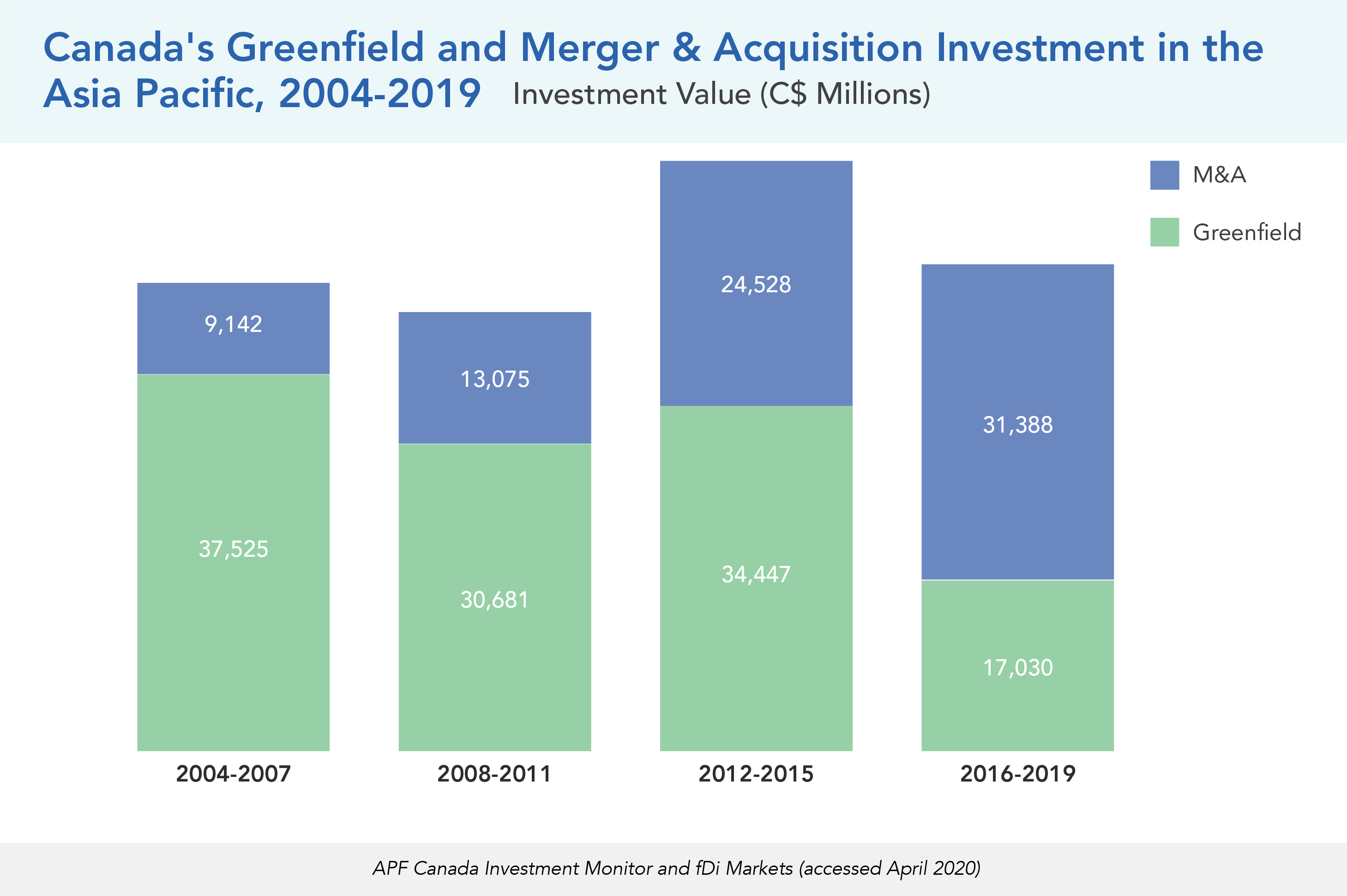
Overall, greenfield remains the preferred method of entry for most Canadian companies when investing in the Asia Pacific region. Over the last 16 years, greenfield investments account for 1,531 of the 2,151 deals (71 percent) in total outbound FDI to the Asia Pacific, while M&A only account for 620 deals in this period. In terms of dollar value, greenfield investments captured 61 percent of the dollar amount of Canadian investments in the region, while M&A deals captured the remaining 39 percent.
However, this pattern has changed in the most recent four years. While greenfield deals still made up majority of the Canadian outbound investment deals in the Asia Pacific, the proportion of greenfield investment deals to total outbound transactions has dropped from 77 percent in the 2012 to 2015 period to 66 percent in the most recent four-year period.
Outbound Canadian M&A investments in the region also overtook greenfield investments in terms of dollar amount in this period. Despite making up only 34 percent of outbound deals, M&A deals accounted for 66 percent of total outbound investment value, with C$31B. The 2016 to 2019 period is the only four-year period in the last 16 years in which outbound M&A investments make up a larger proportion of the outbound FDI than do greenfield investments.
CANADA’S SOES NOW MAKE UP A SIGNIFICANT PORTION OF YEARLY FLOW
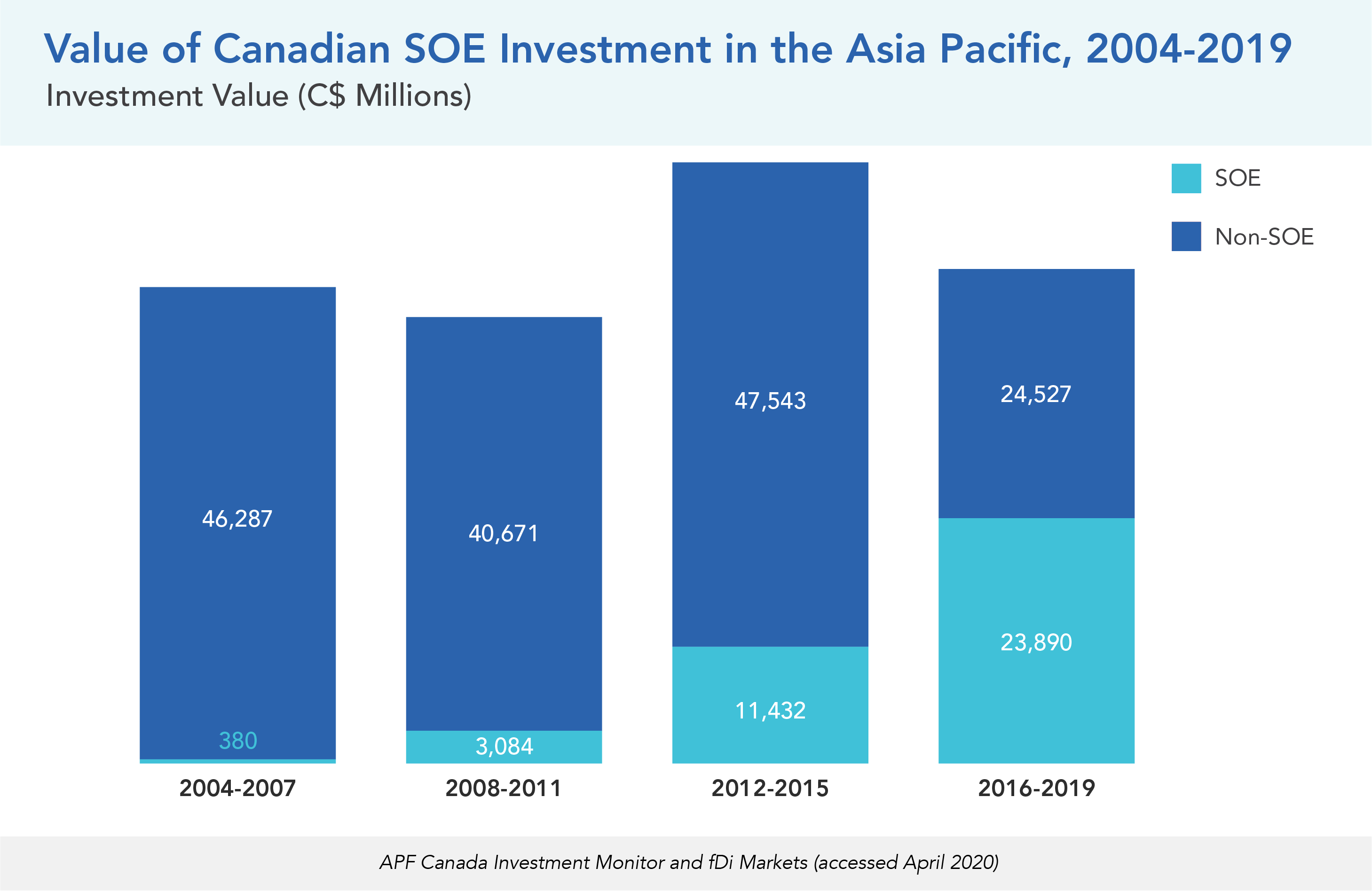
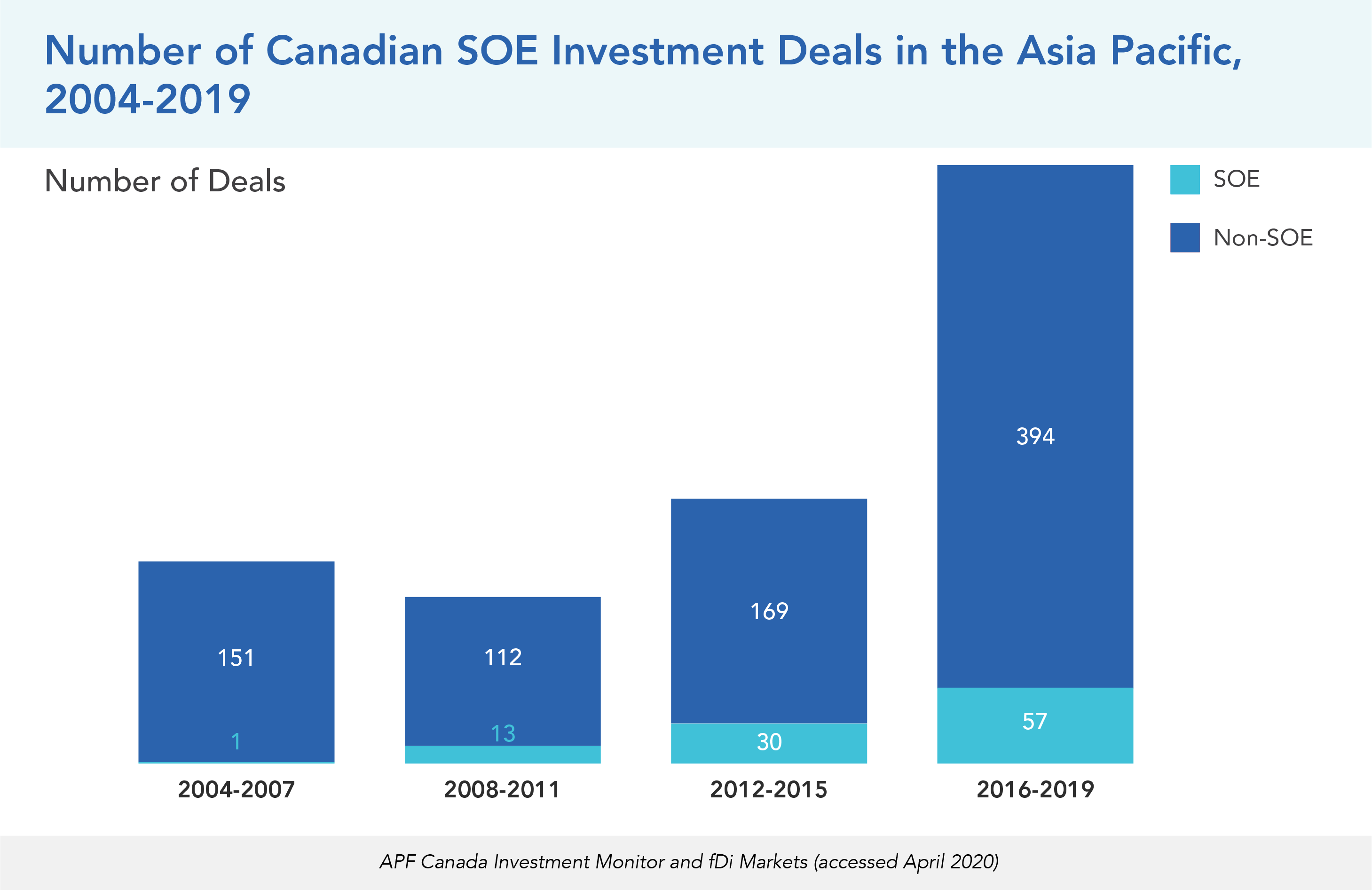
While Canadians have been particularly concerned about inbound Asia Pacific SOE investments in the high-tech sector, Canadian SOEs have been increasingly active investors in the Asia Pacific region both in terms of the dollar value of their investments and investment activities in the last 16 years. From the 2012 to 2015 period to the most recent four years, Canadian SOEs’ investment in the region increased from C$11B to C$24B, a 109 percent increase. During the last eight years, the number of SOE outbound investments also increased, from 30 deals in the 2012 to 2015 period to 57 deals from 2016 to 2019.
The CPPIB is one of the most active Canadian SOEs in the region. Of the 57 SOE outbound investments recorded from 2016 to 2019, the CPPIB accounted for 25 deals, with a total investment value close to C$14B. Some of its recent notable investments include a C$1.7B investment in Sydney’s WestConnex toll road project and C$1.9B in a Chinese logistics company in 2018. In 2019, the CPPIB also committed C$296M of investment in the Mumbai-based India Resurgence Fund, a distressed asset buyout platform, through its subsidiary CPPIB Credit Investment Inc.
Another notable SOE investment in 2019 was made by the Caisse de dépôt et placement du Québec (CDPQ), which acquired C$346M of compulsory convertible debentures from the Mumbai-based Piramal Enterprises Ltd. In its company statement, the CDPQ said that the transaction will include a real estate co-investment platform between its subsidiary Ivanhoé Cambridge and the Mumbai-based company.
More than ever, Canada’s outbound investment relationship is being shaped by the presence of large, state-owned funds. The 2010s saw their activity increase dramatically, as these funds – primarily pensions – nearly tripled their flow of new investments, from C$10.2B in the first half of the decade to C$28.3B in the latter half. But while more than half of the investment value in the 2010 to 2014 period was in Australia’s financial services and real estate sectors, more recent years have seen a diversification of investment targets. Investments in Australia’s industrial transportation and real estate sectors still played a major role in the 2015 to 2019 period, but were supplemented by large flows into Mainland China’s real estate investment and services sector and Hong Kong’s general retail sector. Additional flows of investment, worth hundreds of millions of dollars apiece, went into India’s industrial transportation, electricity, and real estate sectors and into South Korea’s general retail and real estate sectors.
The Toronto-headquartered Canada Pension Plan Investment Board, a Canadian state-owned Crown corporation, leads the pack for all Canadian investors in the Asia Pacific. Last year’s C$296M invested into India’s equity investment sector was a small fraction of the C$26.6B in CPPIB investments recorded by the APF Canada Investment Monitor, C$14.7B of which was invested in just the past four years. These high investments have been driven by the CPPIB’s acquisitions in the Australian financial services and industrial transportation sectors, Mainland China’s real estate and industrial transportation sectors, and Hong Kong’s general retail sector.
Another of Canada’s largest, state-owned pension plans entered the Indian market last year, with the Ontario Municipal Employees Retirement System (OMERS) investing C$160M into India’s financial services sector. OMERS’s C$6.1B invested into the region has been mainly focused on Australia’s real estate investment and services sector. Likewise, state-owned pension and institutional investor CDPQ invested C$346M into Indian non-equity investment instruments last year, bringing the firm’s total to C$4.2B in the region. Aside from non-equity investments in India, the CDPQ’s investments in the region have centred on India’s electricity sector, Mainland China’s real estate investment and services sector, and Australia’s health care equipment and services sector.
Another state-owned Canadian investor to cross the billion-dollar mark is British Columbia Investment Management Corp., a pension and investment manager, with C$1.3B invested in Australia’s industrial transportation sector. Similarly, the Public Sector Pension Board crossed that threshold with its C$1.1B invested in the region, almost entirely in New Zealand’s travel and leisure sector.
Even with the emergence of Canadian state-owned pensions in the region, large private-sector funds continue to invest significant amounts in the Asia Pacific, typified by the C$1.0B invested in 2019 by Brookfield Asset Management Inc. in New Zealand’s software and computer services sector. The Toronto-based asset management company’s C$14.0B invested in the region, C$9.5B of which was invested in just the five most recent years, has been heavily focused on Australia’s industrial transportation and financial services sectors and in India’s real estate investment and services sector.
Similarly, Toronto-based financial institution Manulife Financial has invested C$6.1B in the Asia Pacific region, mainly in Mainland China’s financial services sector, Singapore’s real estate investment and services sector, and Hong Kong’s life insurance sector.
[16] Newswire. 2019. Jiangxi Copper Acquires FQM Shares from Pangaea Investment Management. https://www.newswire.ca/news-releases/jiangxi-copper-acquires-fqm-shares-from-pangaea-investment-management-823519821.html
[17] Entertainment Software Association of Canada. 2018. Canada – A Nation of Gamers. http://theesa.ca/2018/10/29/essentialfacts2018/
Entertainment Software Association of Canada. 2019. The Canadian Video Game Industry 2019. http://theesa.ca/wp-content/uploads/2019/11/CanadianVideoGameSector2019_EN.pdf
Montréal International. 2020. Montréal, a major player in video games. https://www.montrealinternational.com/en/keysectors/video-games/
O’Mara, Matthew. 2013. Tecmo Koei Canada closing its Toronto studio. Financial Post. https://business.financialpost.com/technology/gaming/tecmo-koei-canada-closing-its-toronto-studio
Suckley, Matt. 2016. Updated: Gumi shutters studios in Canada, Sweden, Germany, Austin and Hong Kong. Pocket Gamer. https://www.pocketgamer.biz/asia/job-news/63055/gumi-closes-vancouver-studio/
[18] Zhu, Yushu. 2019. 2019 National Opinion Poll: Canadian Views on High-Tech Investment from Asia. Vancouver: Asia Pacific Foundation of Canada. p. 20.
[19] Brookfield Instructure Partners. 2019. Brookfield Infrastructure Acquires Indian Telecom Towers. https://bip.brookfield.com/press-releases/2019/12-16-2019-112919449
[20] Source: Natural Resources Canada. 2019. Energy Fact Book 2019-2020. https://www.nrcan.gc.ca/sites/www.nrcan.gc.ca/files/energy/pdf/Energy%20Fact%20Book_2019_2020_web-resolution.pdf
[21] Caisse de Dépôt et Placement du Québec. 2019. CDPQ and Piramal Enterprises Strengthen Partnership. https://www.cdpq.com/en/news/pressreleases/cdpq-and-piramal-enterprises-strengthen-partnership
The Provincial Picture
KEY SECTION TAKEAWAYS
- For 2019, Ontario made up the majority of all inbound investment (40 percent), followed by Quebec (18) and BC (3).
- Similarly, for 2019, Ontario made up half of all outbound investment. It is followed by Quebec (23 percent) and BC (14), while Alberta only received one deal this year.
- Comparing the two halves of the decade (2010-2014 and 2015-2019), inbound investment into Alberta dropped dramatically, while inbound investment into BC rose. Meanwhile, Ontario and Quebec both saw slight increases in their inbound flows. The Prairies and Atlantic Canada also saw increased inbound investments in the second half of the decade.
- Considering outbound investment, both Alberta- and BC-sourced flows of investment declined across the decade. On the other hand, Ontario and Quebec both increased their flow of outbound investments throughout the decade.
On the provincial level, FDI flows between Canada and the Asia Pacific are still concentrated in the same four provinces: Alberta, BC, Ontario, and Quebec. Since 2003, 92 percent of all inbound investments have gone to these four provinces, while almost all outbound investments have originated from them. However, while these four retain their status as centres of investment, their relative positions have changed.
FOUR PROVINCES MAKE UP 90 PERCENT OF INBOUND INVESTMENT
Since 2003, Alberta has been the centre of investment from the Asia Pacific, with a third of all inbound investment concentrated in the province. However, in 2019, it received few investments. One example is India-based digital products and services provider Grazitti Interactive’s C$12M investment in a new office in Edmonton. Other investments include Australian engineering company Cardno’s C$7.9M expansion of its Edmonton-based subsidiary, T2 Utility Engineers, and the expansion of Japan-based 7-Eleven across the province, through its subsidiary in Surrey, BC. Overall, Alberta’s inbound investments have dropped significantly, from C$26.4B from 2012 to 2015, to just C$2.8B from 2016 to 2019.
Ontario, in contrast, has seen consistent growth in its inbound investment transaction amounts from 2016 to 2019. In 2019, it received the highest amount of inbound investment and half of all Asia Pacific investments into Canada. This is largely due to several acquisitions by Chinese mining SOEs of Ontario-based mining companies. Jiangxi Copper bought the entire equity interest in PIM Cupric Holdings for C$1.5B, which also gained it a 17.6 percent share in First Quantum Metals. Zijin Mining then acquired the gold mining company Continental Gold for C$1.3B.
Quebec saw an uptick in investments for 2019 and 20 percent of all inbound investments for the year. This is largely due to a deal between Mitsubishi Heavy Industries and Bombardier. Bombardier agreed to sell its regional jet business to Mitsubishi for C$730M, making this the province’s largest inbound deal from 2016 to 2019. Overall, investments from Mitsubishi made up 56 percent of the province’s total inbound investments for 2019. Mitsubishi’s other 2019 deals include its acquisition of Bombardier’s assets for C$550M, and the opening of a new Montreal office for Mitsubishi Aircraft for C$202M.
Lastly, BC saw its largest amount of inbound investment from 2016 to 2019, with a total of C$32.3B for the period. This uptick is due to the C$24.5B in investments for the LNG Canada project. However, for 2019, the province received only a few investments, making up just 3 percent of total inbound investment for the year. The major deal for 2019 is Australian company Jervois Mining Limited’s mergers with eCobalt Solutions Inc. and M2 Cobalt Corp. for C$57.6M. Another notable deal is Mitsubishi Corporation’s C$5.9M investment in Vancouver-based Spare, an artificial intelligence enabled platform for on-demand mobility.
FOUR PROVINCES MAKE UP ALMOST ALL OF OUTBOUND FDI
Ontario continues to lead Canada’s outbound investment to the Asia Pacific region. Since 2003, the province has provided 61 percent of all Canadian investments in the Asia Pacific, and for 2019, 57 percent of all outbound investments came from the province. The biggest news of 2019 is the sale of Vodafone New Zealand to a consortium including Brookfield Asset Management for C$917M, gaining it a 49 percent stake in the mobile company. Other large deals in 2019 include Brookfield Infrastructure Partners’ C$493M acquisition of a telecom company owned by India-based Reliance Industrial Limited, and the Ontario Teachers’ Pension Plan’s C$330M investment in India’s National Investment and Infrastructure Fund.
Quebec closely follows Ontario, having the second-highest amount of investments for 2019 and 19.5 percent of all outbound investments to the Asia Pacific for the year. The province’s largest outbound deals in 2019 were all made by the pension SOE CDPQ. The biggest of these is the CDPQ’s C$346M investment in Indian conglomerate Piramal Enterprises Ltd. Another notable investment from the CDPQ is its acquisition of Australian hospital operator Healthscope Limited for C$335M, together with a conglomerate including Brookfield Business Partners. Overall, from 2016 to 2019, the CDPQ has invested a total of C$2.7B in the Asia Pacific, mostly in India and Australia.
BC has the third-largest share of outbound investments for 2019, with 14 percent originating from the province. However, its outbound flows have been steadily decreasing, from C$11B from 2004 to 2007, to C$3.7B from 2016 to 2019. That being said, the province saw one noteworthy deal in 2019. Electric microcar manufacturer Electra Meccanica Vehicles invested C$783M in a new production facility in Chongqing, China. This deal made up the bulk of outbound investments in 2019.
Lastly, in 2019 Alberta saw its lowest amount of outbound investments since 2003, with only one deal made. The transaction came from Eguana Technologies, a supplier of energy storage systems for residential and commercial use, which invested C$3.4M in a new office in Australia. Overall, the number of outbound investments from Alberta has dropped in recent years. For the 2016 to 2019 period, Alberta invested just C$292M in the region, compared to C$8.6B from 2012 to 2015.
As a whole, the provinces combined saw an increase in inbound investment and a decrease in outbound investment for the 2016 to 2019 period. However, not all provinces experienced these changes in the same way. While Ontario has the largest share of both inbound and outbound investment for 2019, Alberta experienced a significant drop in both, marking the province’s lowest investment totals since 2003. Quebec’s outbound investment decreased in 2019 from its total in 2018, while its inbound investment total for 2019 is its highest for the current period. Conversely for BC, its outbound investment increased in 2019 from its total in 2018, while its inbound investment total for 2019 is the lowest for the current period.
A DECADE OF CHANGES FOR CANADIAN PROVINCES AND TERRITORIES
Inbound
Canada’s two westernmost provinces saw the most dramatic changes in absolute terms across the decade, moving in opposite directions as Asia Pacific investment reflected broader economic trends.
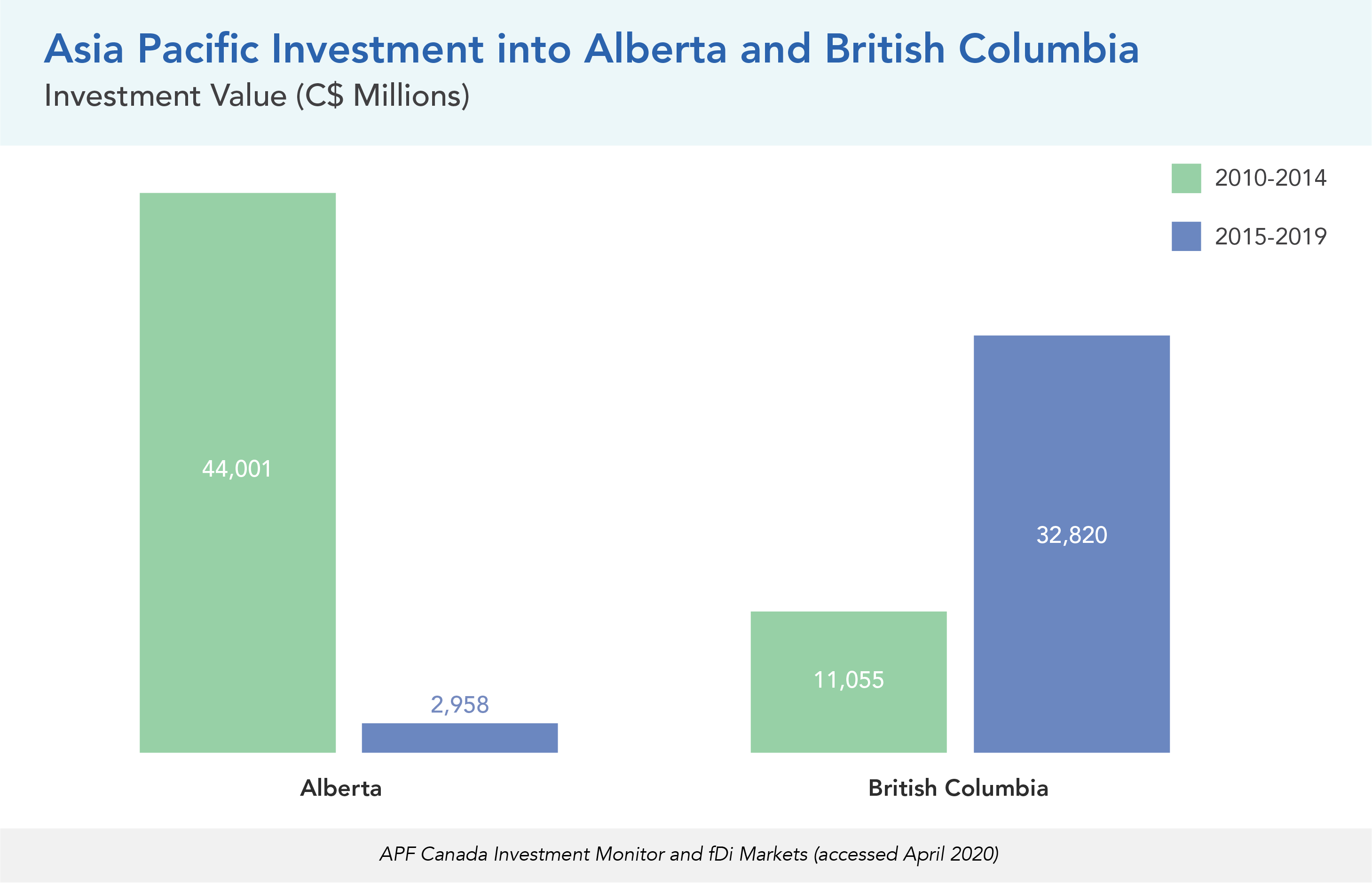
New Asia Pacific investment into Alberta dropped from C$44.0B in the first half of the 2010s to just C$2.9B in the second half, by far the largest drop in dollar terms among all provinces. While the province made notable gains between periods in investment received in alternative energy (a net increase of C$531M), farming (C$58M), and pharmaceuticals (C$38M), these were more than offset by deep drops in oil and gas producers (a net decrease of C$36.6B) and industrial metals and mining (C$2.8B).
In comparison, new Asia Pacific investment received by BC nearly tripled, rising from C$11.1B to C$32.8B. This increase was driven in part by gains between periods in oil and gas producers (a net increase of C$17.3B), real estate investment and services (C$1.8B), mining (C$1.7B), and health care equipment and services (C$1.6B), all offsetting a net drop in coal mining investment of C$1.1B.
Both Manitoba and Saskatchewan saw increases in the flow of new Asia Pacific-sourced investment received across the decade, and the territories saw a drop from an already marginal flow.
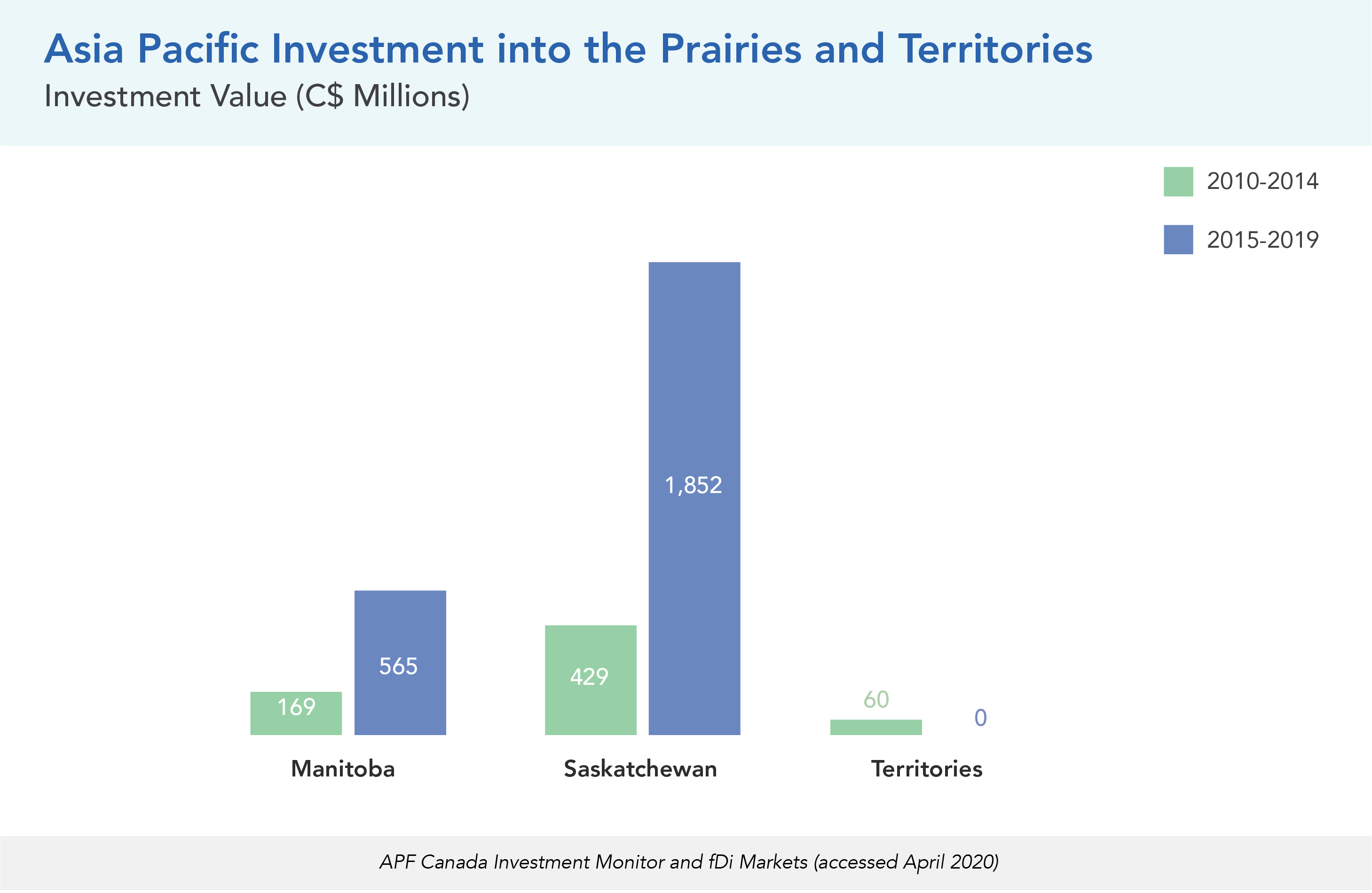
In Manitoba, the flow of Asia Pacific investment increased from C$169M in new investment in the first half of the decade to C$520M in the second half. With gains in fishing and animal production (a net increase of C$436M in new investment) and travel and leisure (C$13M), the net decline in financial services of C$107M was more than offset.
Saskatchewan saw its investment received increase from C$429M in new investment during the 2010 to 2014 period to C$1.9B in new investment during the latter half of the decade. The net increase in new investment received in oil and gas producers, at C$1.8B, more than outweighed declines in mining (a net decrease of C$298M in new investment between periods), software and computer services (C$88M), alternative energy (C$34M), and technology hardware and equipment (C$4M).
The Northwest Territories, Nunavut, and Yukon collectively attracted C$60M in the first half of the decade, with no value recorded in the second. The change was exclusively driven by a net decline of C$60M in new investment in industrial metals and mining between periods.
In central Canada, new Asia Pacific investment increased between the first and second halves of the 2010s, with both Ontario and Quebec seeing slight increases in flows.
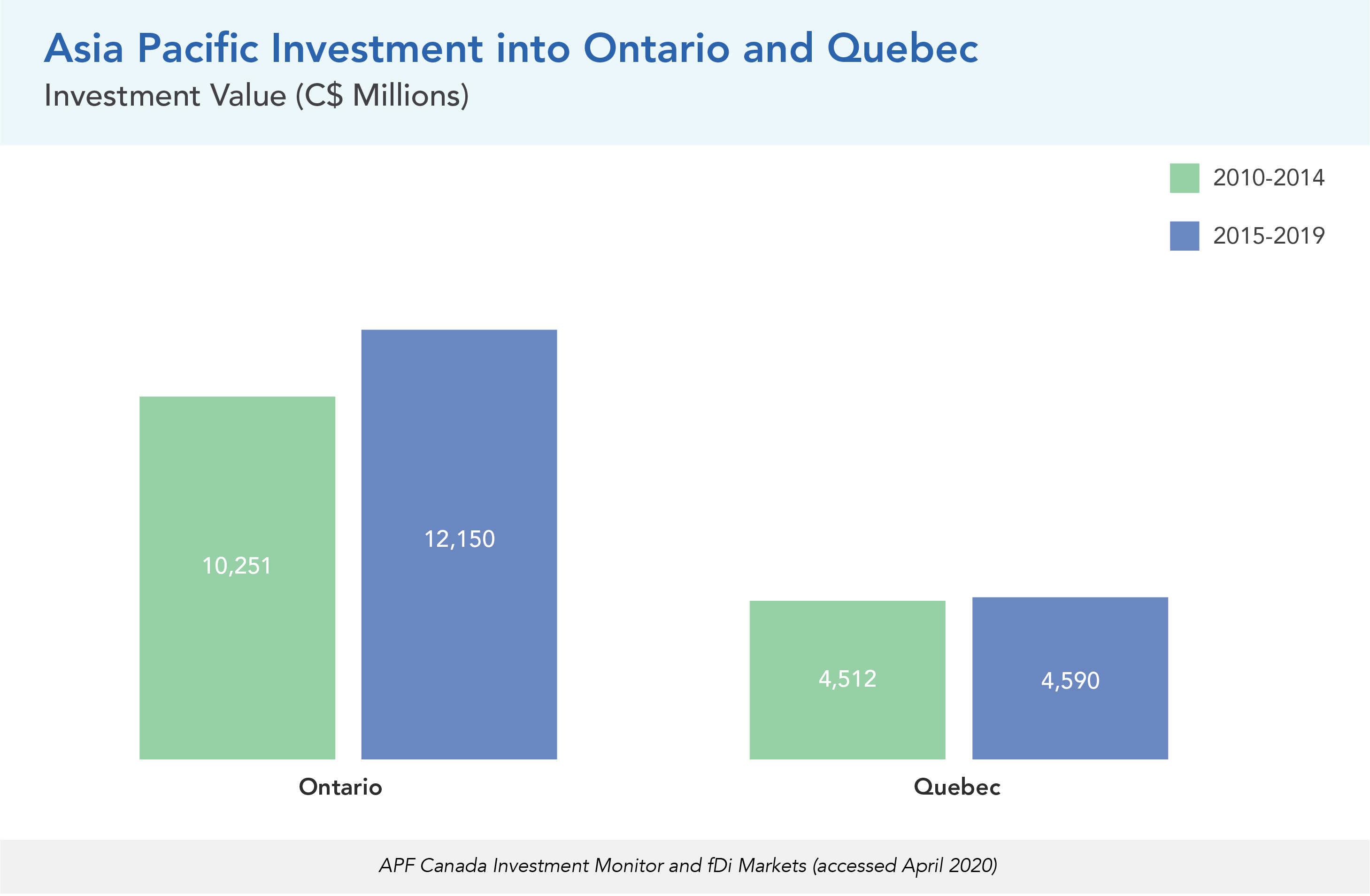
The value of Ontario’s new investments received increased from C$10.3B in the first half of the 2010s to C$12.6B in the second half. Gains in mining (a net increase of C$3.1B) and industrial engineering (C$1.4B) led against drops in new investments in electricity (a net decrease of C$1.8B), oil and gas producers (C$1.1B), and automobiles and parts (C$593M).
Quebec also saw an uptick in new inflows of investment across the decade, beginning with the first half of the decade’s C$4.5B, followed by the latter half’s additional C$5.1B in new investment. By far the largest sectoral increase was the net change of C$1.2B in additional investment in aerospace and defence, with the province only seeing drops in industrial metals and mining (a net decrease of C$3.5B), general retailers (C$50M), chemicals (C$7M), and support services (C$1M).
Overall, Atlantic Canada saw increased flows of investment as the decade progressed, with every Atlantic province except PEI recording increases at the provincial level, too.
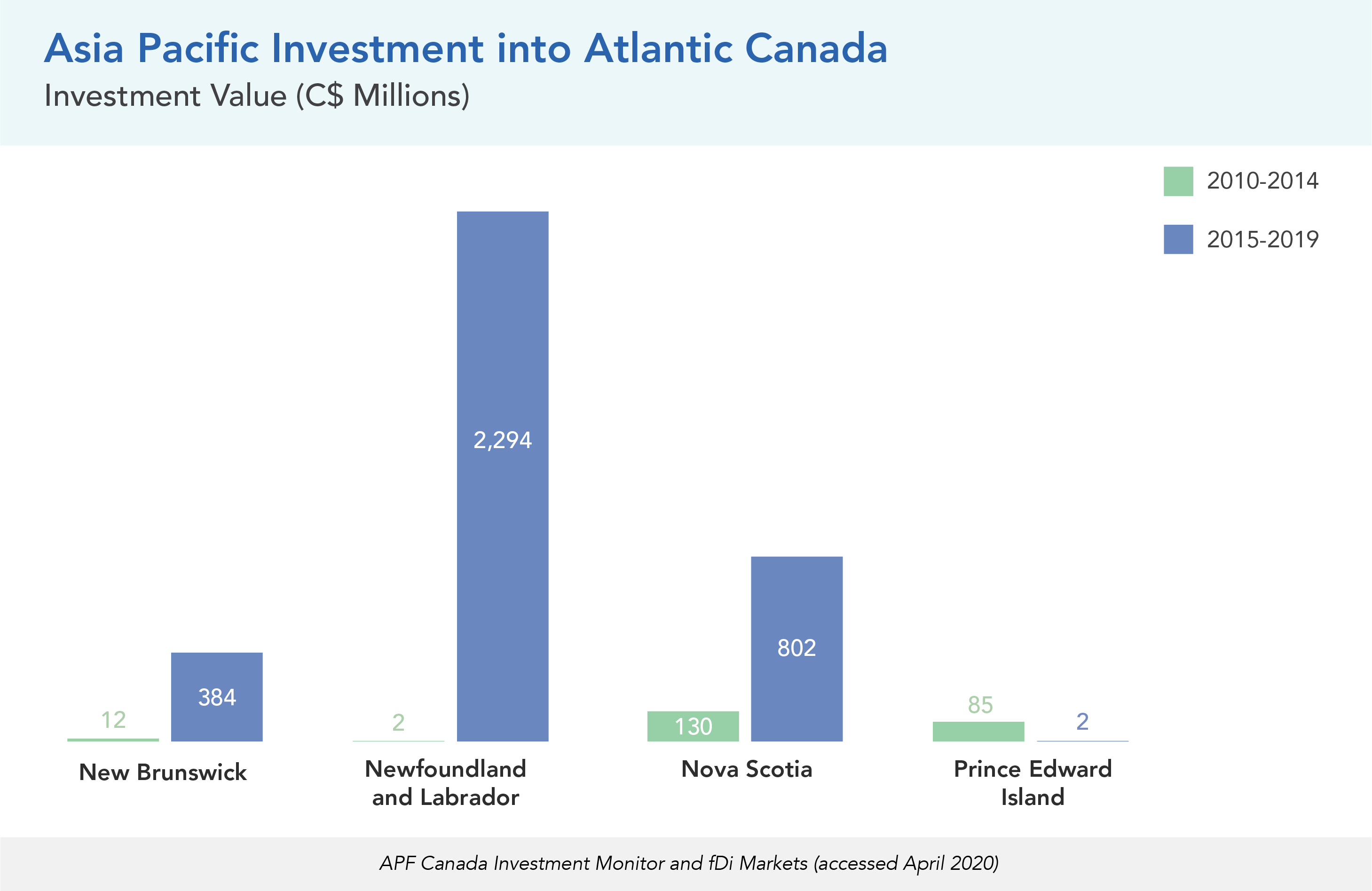
New Brunswick’s investment flow increased from C$12M in new investment between 2010 and 2014, to C$384M in new investment between 2015 and 2019. The increase was spurred by gains in software and computer services (a net increase of C$201M in new investment), technology hardware and equipment (C$121M), construction and materials (C$43M), and support services (C$6M).
Newfoundland and Labrador saw a dramatic increase in new investment received, starting from just C$2M in the first half of the decade to an additional C$2.3B in new investment in the latter half. New investment in oil and gas producers had a net increase of C$2.2B across periods, while support services had a net decrease of C$2M.
New investment into Nova Scotia also increased sharply across the first and second halves of the decade, from C$130M to C$3.7B, respectively. The province saw increases in mining (a net gain of C$3.6B in new investment), pharmaceuticals (C$46M), and industrial transportation (C$21M).
PEI saw marginal inflows in the first half of the decade, at C$85M in new investment received, decline in the second half to an even lower C$2M in new investment. The drop was driven by a net decline of C$85M in new investments received in software and computer services.
Outbound
Only eight provinces, and no territories, invested in the Asia Pacific in the 2010s. Both Alberta- and BC-sourced flows of investment declined across the decade, reaching similar levels of new investment between 2015 and 2019.
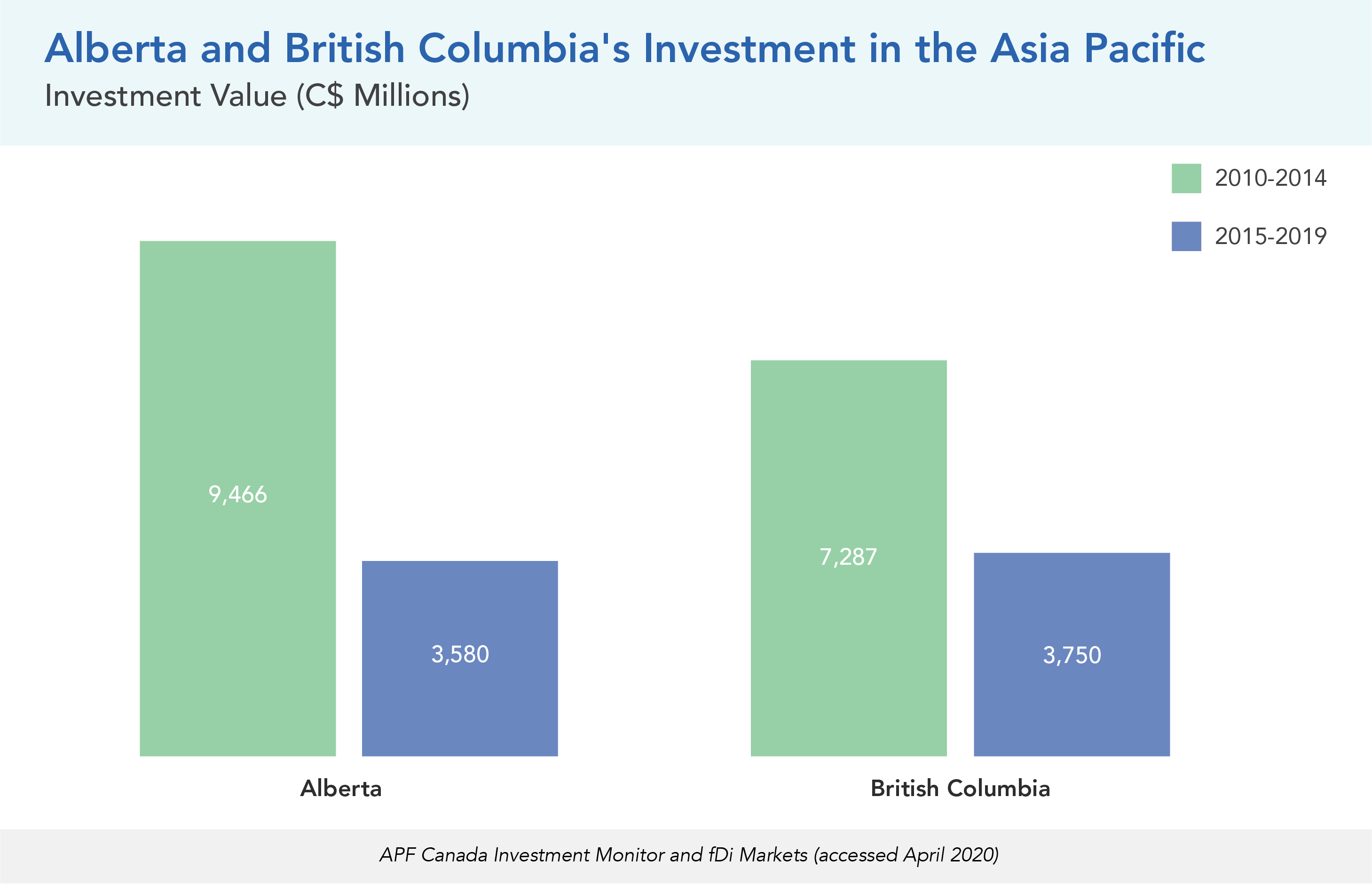
While Alberta invested C$9.5B into the Asia Pacific between 2010 and 2014, that number dropped to C$3.6B in new investment for the decade’s second half. Increases in Albertan investment in Asia Pacific alternative energy (a net increase of C$982M in new investment flows between periods), electricity (C$651M), industrial transportation (C$106M), and support services (C$66M) were more than offset by the decline in Albertan investment in Asia Pacific oil and gas producers, which saw a net decrease of C$3.0B in flows between periods.
BC’s investors decreased the amount of new investment into the Asia Pacific across periods, from C$7.3B invested in the 2010s’ first half, to C$3.8B in new investments across the second half. While the province invested more in the Asia Pacific’s industrial transportation sector (for a net change in new investment flow across periods of C$1.3B), automobiles and parts (C$796M), and electronic and electrical equipment (C$506M), it was accompanied by drops in investments in mining (down C$2.9B) and coal mining (C$1.7B) between periods.
Some of the largest flows came from Ontario and Quebec, which both increased their flow of new investments between the first and second halves of the decade.
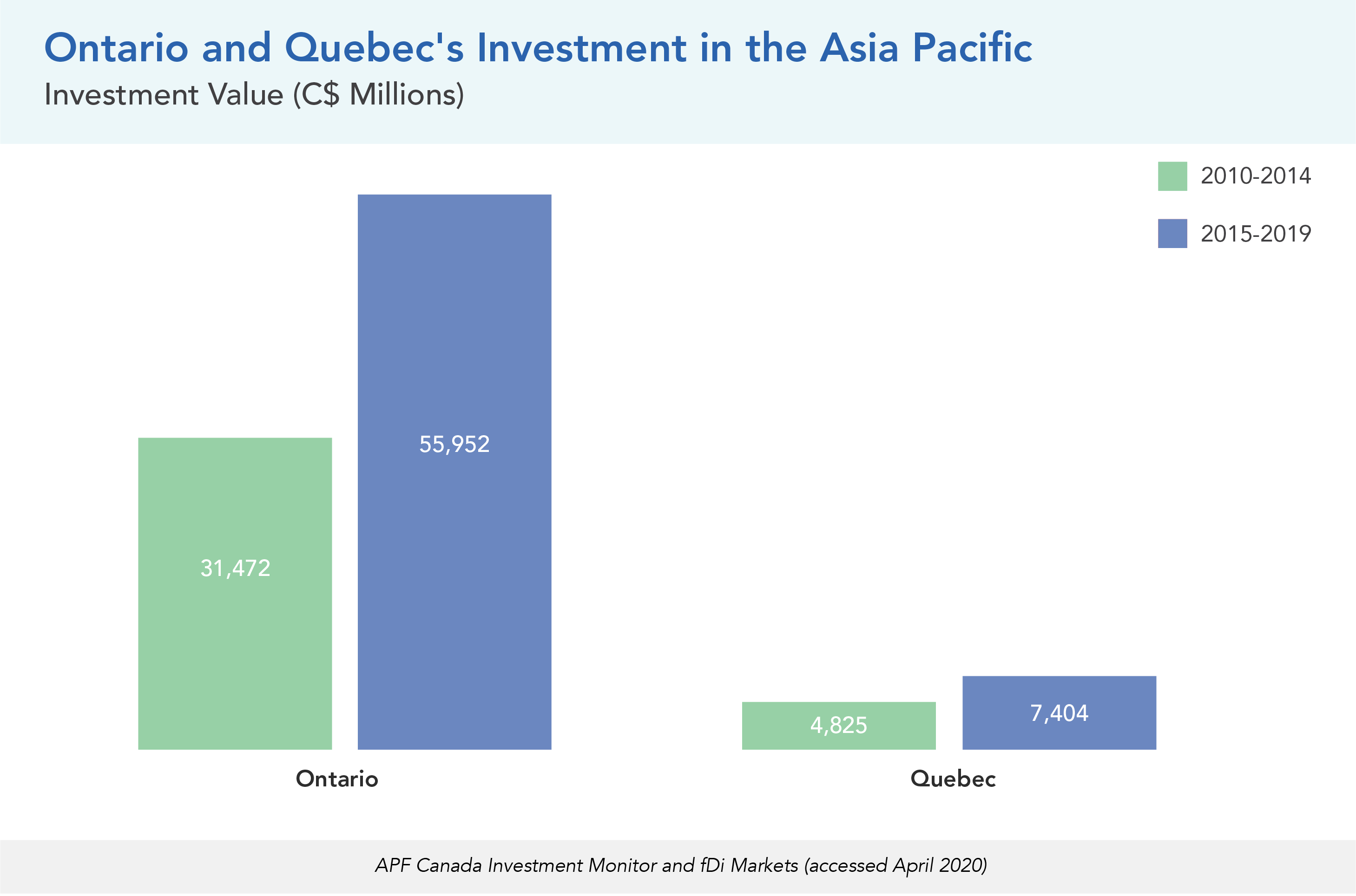
Ontario invested C$31.5B into the Asia Pacific between 2010 and 2014, followed by an additional C$56.0B in new investment over the next five years, from 2015 to 2019. Unsurprisingly, given Ontario’s role as Canada’s financial capital, the province ranked as the largest source of investment across periods, with the change across halves driven by new investments in industrial transportation (a net increase of C$13.8B in new investment between periods), alternative energy (C$7.0B), general retailers (C$4.7B), and real estate investment and services (C$2.7B) rising above the net decline in new investment in financial services by C$2.9B.
Quebec’s investment of C$4.8B during the first half of the decade ticked up to add another C$7.4B in new investment in the latter half. The increase in flows was driven by investments in food producers (with a net increase of C$1.0B in new investment flows between periods), electricity (C$733M), non-equity investment instruments (C$674M), equity investment instruments (C$342M), and health care equipment and services (C$281M).
Four other provinces invested in the Asia Pacific during the 2010s: Manitoba and Saskatchewan in the Prairies, and New Brunswick and Nova Scotia in Atlantic Canada.
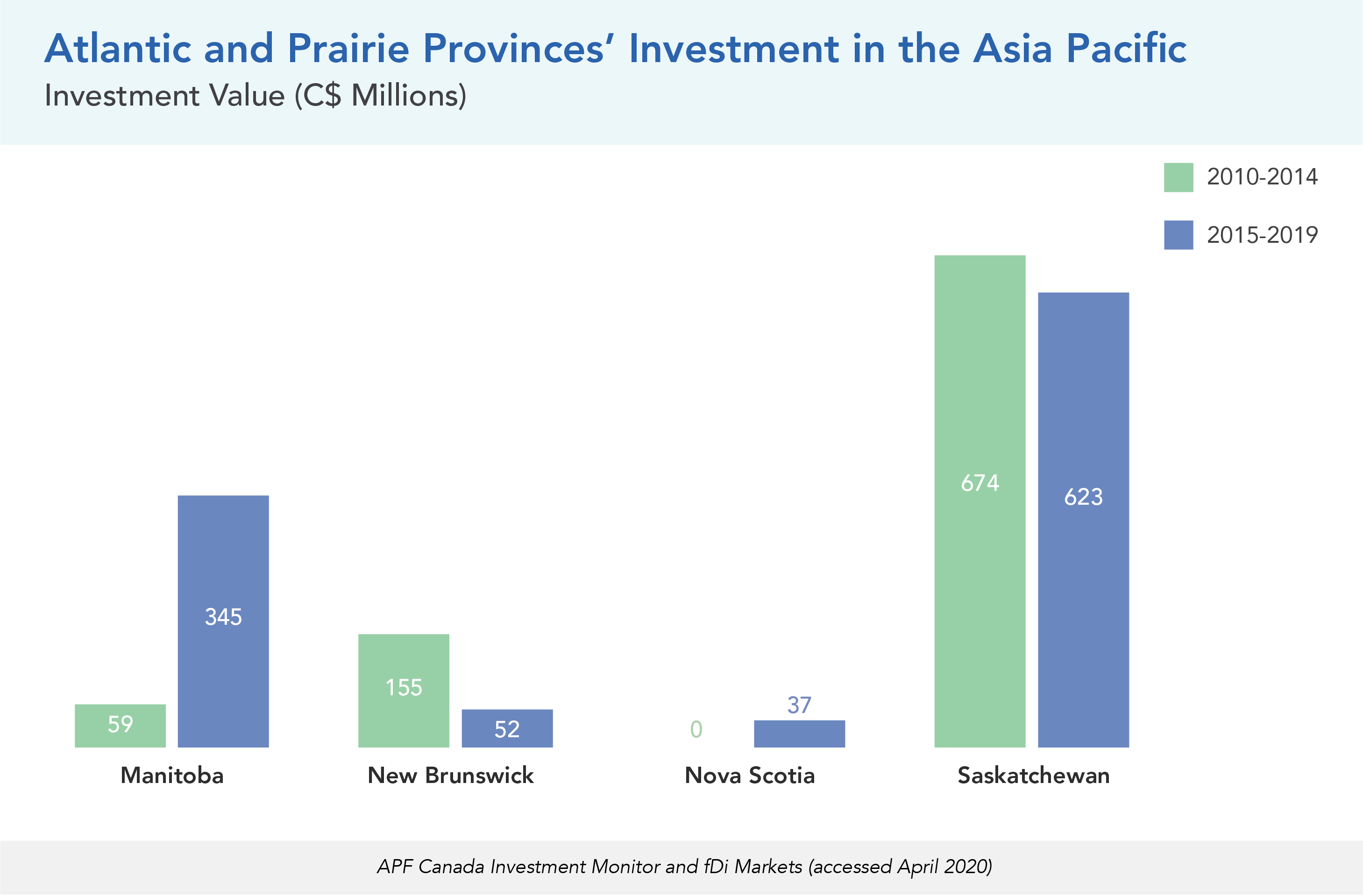
Manitoba’s increasing levels of investment, from C$59M from 2010 to 2014 to C$345M from 2015 to 2019, was spurred by a net increase in new investments of C$319M in travel and leisure, pharmaceuticals (C$9M), and health care equipment and services (C$1M), offsetting net declines of C$27M in industrial engineering and C$16M in food producers. Conversely, Saskatchewan’s modest drop in investment flows, from C$674M to C$623M, occurred in the context of a C$623M net increase in chemicals investment, offsetting net decreases in industrial metals and mining (a net decrease of C$483M in new investment), farming (C$180M), food producers (C$9M), and mining (C$2M).
New Brunswick’s drop in new investments into the Asia Pacific across the 2010s, from C$155M in the first half to C$52M in the second, came as minor upticks in new investments in support services (a net increase in flows of C$2M) and general retailers (C$1M) were drowned out by a C$106M net decrease in new investments into food producers in the Asia Pacific. For Nova Scotia’s part, the increase in new Nova Scotia-sourced investments between the 2010 to 2014 period and 2015 to 2019 was entirely driven by a C$37M increase in the pharmaceuticals sector.
City-Level Hubs of Investment Activity
KEY SECTION TAKEAWAYS
- Over the past 17 years, 97 Canadian cities have invested into the Asia Pacific, representing a strong network of ties across the Pacific. During that same period, 21 Canadian cities invested half a billion or more into the region, some with hundreds of deals.
- Toronto, as the financial capital of Canada, stands apart as the largest source of outbound investment into the Asia Pacific in terms of both dollar value and deal numbers, with C$110B invested across 800 deals. Meanwhile, Calgary ranks first in terms of dollars received from the Asia Pacific, given its capital-intensive oil and gas production sector.
- There is a diverse range of Canadian cities receiving inbound investment, notably where mining sites are located or where mining companies are headquartered.
CANADIAN CITIES OUTBOUND TO ASIA PACIFIC: FROM ANZAC TO WATERLOO
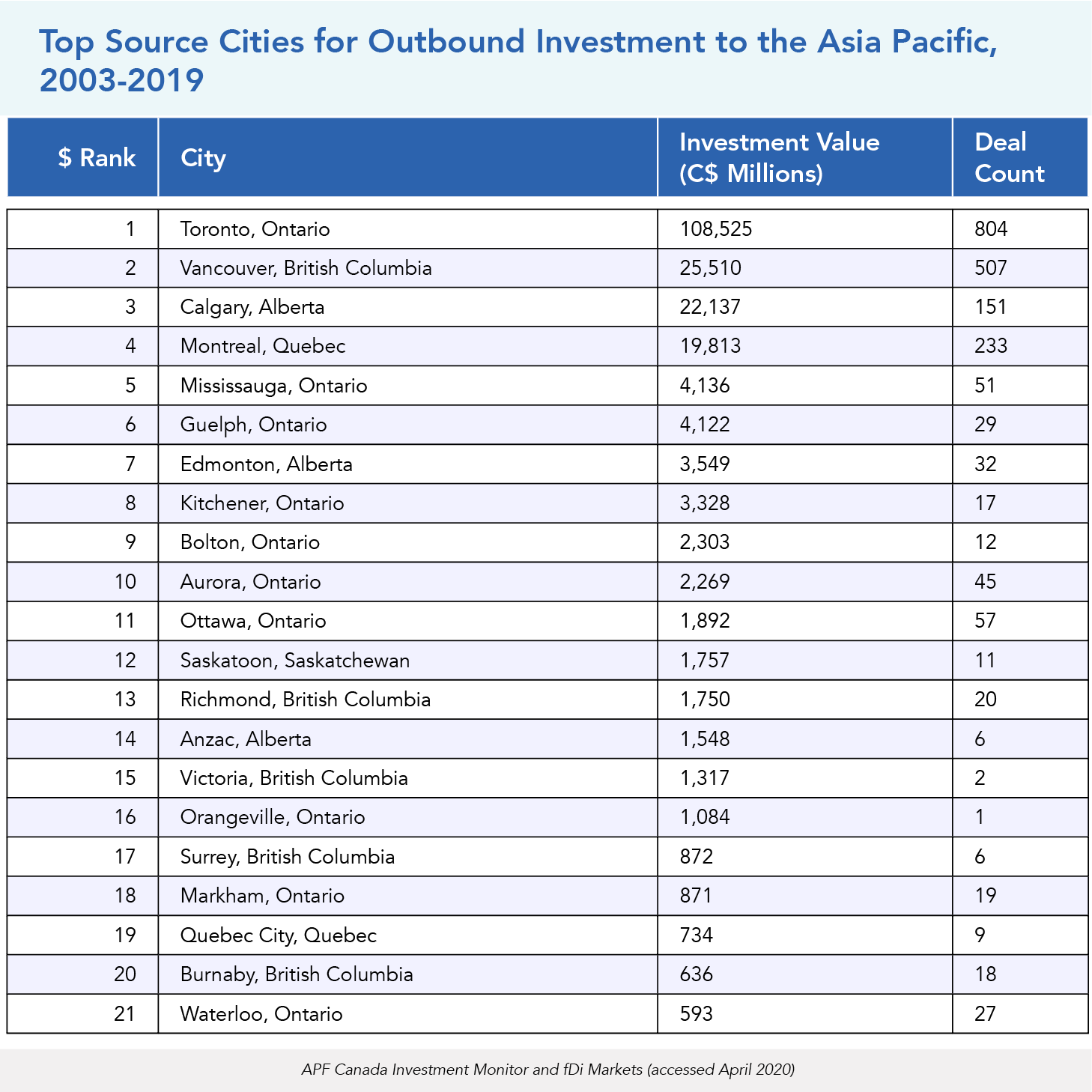
Over the past 17 years, 97 Canadian cities have invested into the Asia Pacific, representing a strong network of ties across the Pacific. During that same period, 21 Canadian cities invested half a billion or more into the region, some with hundreds of deals.
As the financial capital of Canada, Toronto stands apart as the largest source of investment into the Asia Pacific in terms of both dollar value and deal numbers, with C$110B invested across 800 deals during the period. Many of Canada’s largest funds are headquartered in the city, and with Toronto’s large flow driven in no small part by repeated, major deals by investors such as Brookfield, the Canada Pension Plan Investment Board, the Ontario Teachers’ Pension Plan, and Scotiabank. While Toronto-sourced investments can be found across the Asia Pacific, the bulk of their value flowed to just three economies: Australia, Mainland China, and India. Likewise, the highly diversified set of sectors targeted by Toronto’s investors were still largely dominated by investments in the core targets of real estate investment and services, industrial transportation, financial services, and travel and leisure.
The next three cities are also Canada’s largest cities, and they each invested tens of billions into the region. With C$27B invested across 506 deals, Vancouver sits comfortably in second place in both investment values and deal counts. As with Toronto, Vancouver’s target economies were mainly Australia, Mainland China, and India, while the majority of its capital flowed into the mining and construction sectors. In contrast, Calgary’s C$22B invested into the region mainly flowed into Australia, and at the sector level, into oil and gas producers. Montreal, fourth in terms of dollars invested but third in terms of deal counts, had Australia and Mainland China as its main targets in dollar terms, with a sectoral focus on the Asia Pacific’s industrial metals and mining, food producers, and industrial transportation sectors.
Rounding out the top sources for investment into the Asia Pacific are three cities in southern Ontario, and one from Alberta. Mississauga invested C$4.1B across 51 deals, mostly into Mainland China and Australia, with forestry and pharmaceuticals the main targets over the 17-year period. Narrowly behind, Guelph also invested C$4.1B through 29 deals, the majority of which flowed into Japan, mainly into electricity. Edmonton’s 31 deals in the Asia Pacific came to a total of C$3.5B, with the majority flowing to either Mainland China or Thailand, while its sectoral targets were alternative energy and industrial metals and mining. For Kitchener’s C$3.3B invested in 21 deals, the majority of dollars flowed into electricity in Pakistan.
Remaining cities on the list rank high for a variety of reasons. For Bolton, Ontario, the bulk of the value was driven by one deal into oil equipment, services, and distribution in Mainland China, while Orangeville, Ontario, ranks high due to just one deal, by Global 8 Environmental Technologies, into Mainland China’s electricity sector. Conversely, the presence of Aurora, Ontario, in the Asia Pacific has been entirely driven by its headquartering of Magna International, an auto component manufacturer; likewise, Saskatoon’s headquartering of Cameco, a uranium producer, is behind the city’s own relatively high ranking, while mining firm Turquoise Hill Resource’s investments entirely drove Anzac, Alberta, to its current ranking.
CANADIAN CITIES INBOUND FROM THE ASIA PACIFIC: INVESTMENTS FROM COAST TO COAST TO COAST
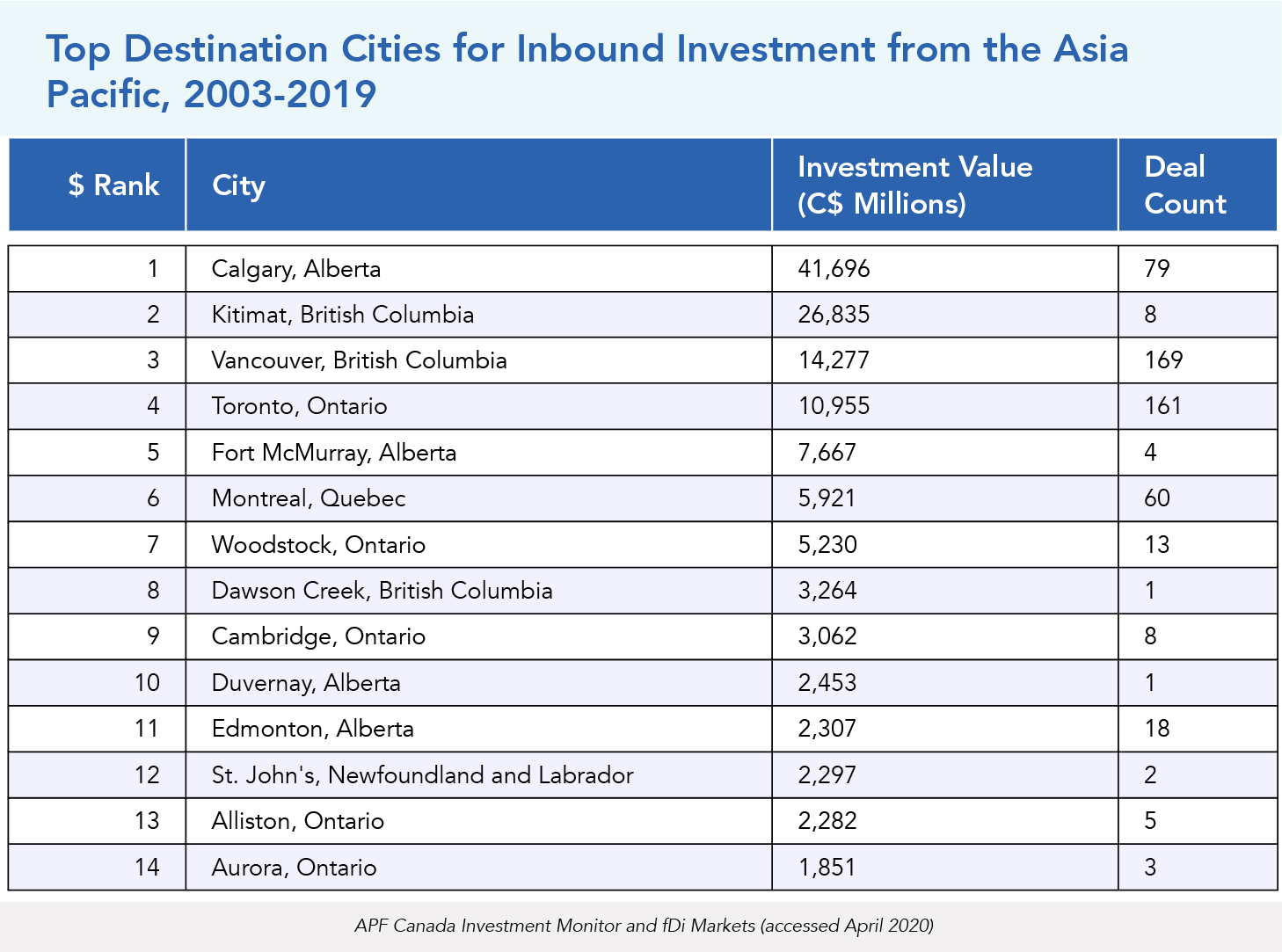
Between 2003 and 2019, 191 cities and city-level regions in Canada received investment from the Asia Pacific, highlighting how Canada’s investment relationship with the region goes far beyond the largest communities. Even among the 15-largest recipients by value, communities range from Canada’s most populous city, Toronto, to the hamlet of Duvernay, Alberta.
Given how capital intensive the oil and gas producers sector is, it is no surprise that Calgary ranks first in terms of dollars received from the Asia Pacific across this 17-year period. While the deal count, at 78, ranks below other cities’, the C$41.7B received is larger than investment into Toronto, Vancouver, and Montreal combined. With the bulk of investment coming from Mainland China and flowing into oil and gas production, the city’s ranking was also heavily determined by state-owned investment by China National Offshore Oil Corporation, China Petroleum & Chemical Corporation, and Thailand’s PTT Exploration and Production. While Calgary is likely to retain this top position given the substantial gap between it and other Canadian cities, the city has lagged in recent years: the bulk of the C$41.7B occurred before 2014, with only C$4.2B received since, behind Kitimat, Vancouver, and Toronto for that same time period.
Ranked second in terms of received investment is Kitimat, BC, which saw eight deals lead to C$26.8B in investment. Further illustrating how connected Asia Pacific-Canada investment is to energy, the entire amount flowed into oil and gas producers, stemming mainly from Malaysia, Mainland China, and Japan. In Kitimat’s case, these investments were largely driven by a mix of state-owned investors – namely, Petronas of Malaysia and the China National Petroleum Corporation – and private investment from Japan-based Mitsubishi Corporation into the LNG Canada project.
Vancouver and Toronto’s investments received and deal counts rank at similar levels. For Vancouver, 166 deals led to a third-placed C$14.3B in investment, with the majority of investment stemming from Mainland China. Again, natural resources played a significant role in determining this ranking, with the bulk of dollars received going into the mining and industrial metals and mining sectors. As with Vancouver, Mainland China was the source for most of the C$11.5B received by Toronto across 155 deals from 2003 to 2019. Presenting a slightly more diversified set of sectors, the mining sector still made up the top sectoral destination for investment into Toronto, with software and computer services and travel and leisure rounding out the majority of the investment value.
While Canada’s largest cities and towns have received the majority of the Asia Pacific’s investment into Canada, a full quarter of investment value since 2003 has been into communities and areas classified as rural by Statistics Canada. In all, the APF Canada Investment Monitor records investment from the Asia Pacific into 61 different rural communities, for a total of C$40B in received investment over the past 17 years.
A significant share of rural investment is associated with one location in BC, in the oil and gas production sector: specifically, the C$26.8B invested into Kitimat, BC, for light natural gas export facility projects. Oil and gas production was also the target for second-ranked Duvernay, Alberta, with C$2.5B going into the exploration and development of oil resources by China National Petroleum Corporation under a joint venture agreement with Encana.
Other locations have also passed, or are close to, the billion-dollar mark, spurred by investments into varying forms of energy and mining. Fort Nelson, BC, saw C$1.3B flow into oil and gas producers, primarily driven by a consortium of five Japanese companies collaborating on a shale gas project. For Quebec’s Labrador Trough, C$1.2B was invested into industrial metals and mining under a joint venture agreement with a consortium led by South Korea’s Pohang Iron and Steel Company and Taiwan’s China Steel Corporation. Letellier, Manitoba, received C$1.2B stemming from an investment in alternative energy as the Australia-based Babcock & Brown invested in the development of a 300-megawatt wind farm. Investments in coal mining brought the Peace River coalfields to C$976M, as Australia’s Xstrata Coal and Japan’s JX Nippon Oil & Energy Corporation invested to develop metallurgical coal in the region.
Spruce Lake, Saskatchewan, saw C$744M, also driven by oil and gas production, namely Hong Kong-owned Husky Energy’s two steam-assisted heavy oil extraction plants near the hamlet. For Wheatland County, Alberta, C$677M stemmed from Japan’s Toyota Group reaching an agreement with Encana to acquire an interest in Encana’s coalbed methane project. Red Lake received the largest investment into rural Ontario, with C$499M invested in mining as Australia’s Evolution Mining bought a Canadian gold mining complex at Red Lake from US-based Newmont Goldcorp.
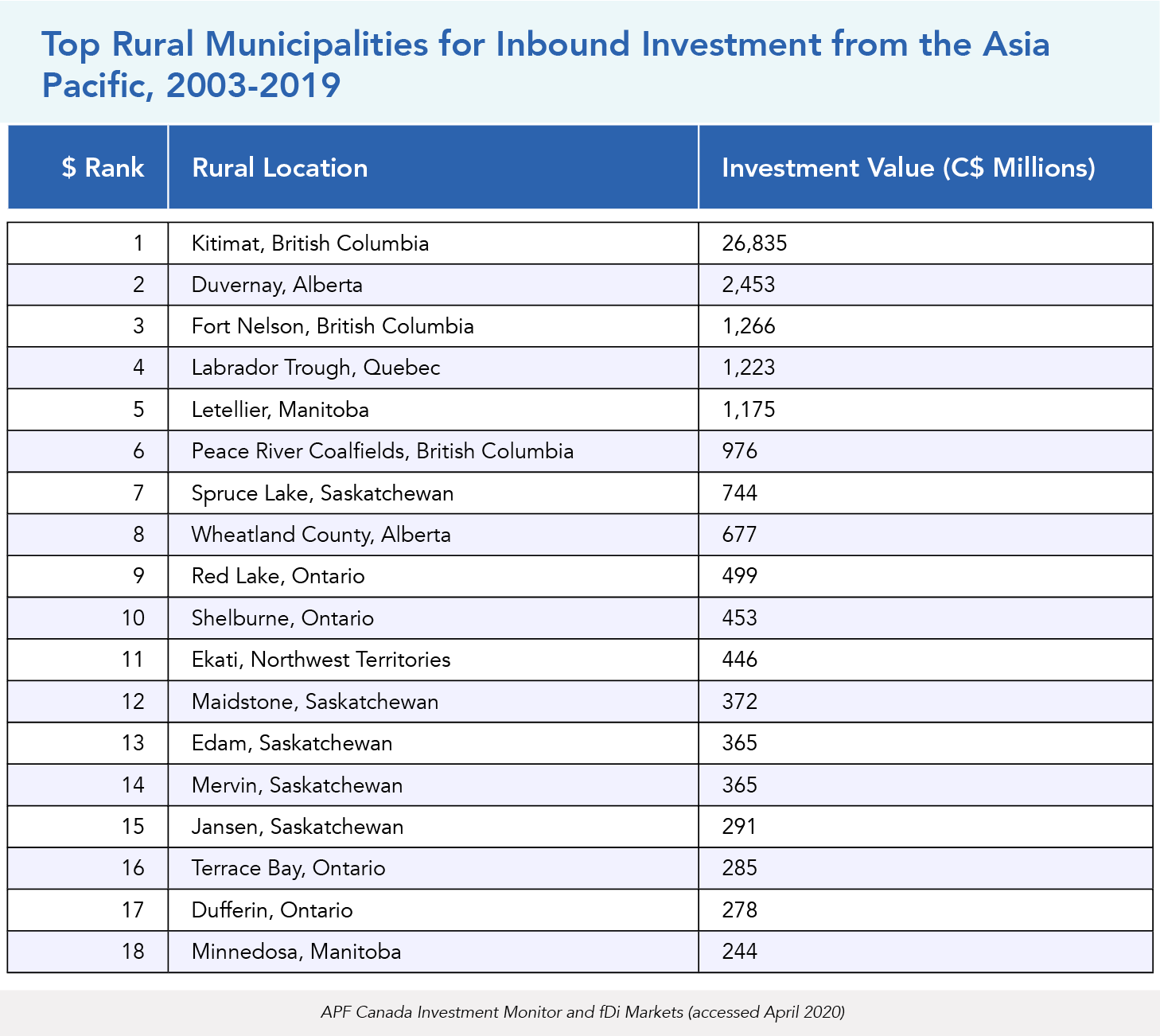
ASIA PACIFIC CITIES’ INVESTMENT INTO CANADA: IN A YEAR OF TENSE TIES, CHINA’S CITIES STILL LED
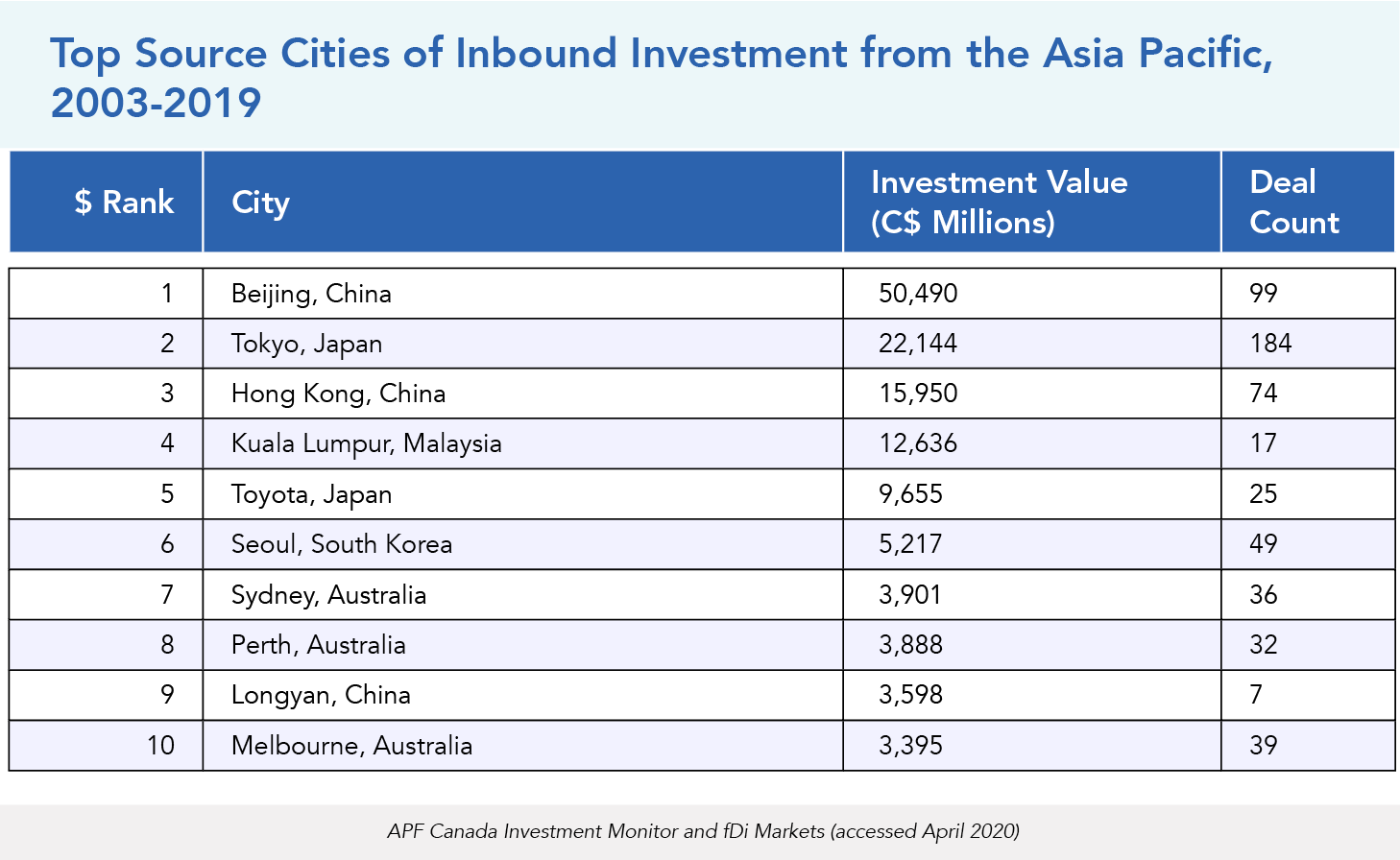
Considering inbound investment from the Asia Pacific, an analysis at the city level enables a greater understanding of where investments originate in the region. At a glance, the top-ranked source cities in the region reflect the top source economies of inbound investment, namely China, Japan, Hong Kong, and Australia. The ranking of these cities is largely due to their locations as headquarters for energy and mining companies.
Looking closer at 2019, the largest inbound deal this year came from Nanchang, China, with SOE Jiangxi Copper’s acquisition of a 17.6 percent stake in copper mining company First Quantum Metals for C$1.5B. The second-largest deal then came from Longyan, China, with SOE Zijin Mining’s acquisition of gold mining company Continental Gold for C$1.3B. This one deal makes up more than a third of the total amount of investments originating from Longyan. Other big deals for the year include Tokyo-based Mitsubishi’s acquisition of Bombardier for C$731M and Melbourne-based St. Barbara Limited’s acquisition of a stake in Atlantic Gold Corporation for C$723M.
One noteworthy deal is Kuala Lumpur-based leisure company Genting Group’s C$649M sale of a 35 percent stake in its subsidiary, Genting Hong Kong Ltd., to a consortium including the Ontario Teachers’ Pension Plan. Kuala Lumpur, Malaysia, fourth on the list, is the only city located in Southeast Asia. Indeed, this deal is the Ontario Teachers’ Pension Plan’s first investment in the Southeast Asian region. Overall, the city is notable for having only a few deals, but the fourth-largest amount of investment into Canada. Similar to Beijing and Tokyo, the majority of investments from the city are in oil and gas as well as industrial metals and mining.
Overall, Beijing, China, maintains its place as the largest source city of inbound investment from the Asia Pacific. Since 2003, C$50.5B in investments have arrived in Canada, in sectors ranging from oil and gas production to real estate investment. However, in 2019, investments from the city totalled just C$138M, its lowest amount for the 2016 to 2019 period.
As for the second-highest ranking city, Tokyo, Japan, the majority of deals in Canada are in the software and computer services sector. This includes popular Japanese software companies like Sony as well as well-known video game studios like Square Enix. However, in contrast, the largest investments by dollar value since 2003 are in oil and gas production, from the Mitsubishi Group and state-owned Japan Petroleum Exploration Co. Ltd., among others. These companies have invested a combined C$11.8B in oil and gas production in BC and Alberta. For 2019, as previously mentioned, the city’s most noteworthy deal is Mitsubishi’s C$731M acquisition of Bombardier.
Toyota, Japan, ranked fifth, is the exception to the trend of cities as hubs for energy and mining companies. Instead, inbound investments from Toyota are dominated by the car manufacturer Toyota through its various subsidiaries. Since 2003, the Toyota Group has invested C$9B in car manufacturing and distribution in Canada, primarily in Ontario with some locations in Alberta, BC, and Quebec.
ASIA PACIFIC CITIES’ INVESTMENTS FROM CANADA: MUMBAI LEADS THE YEAR
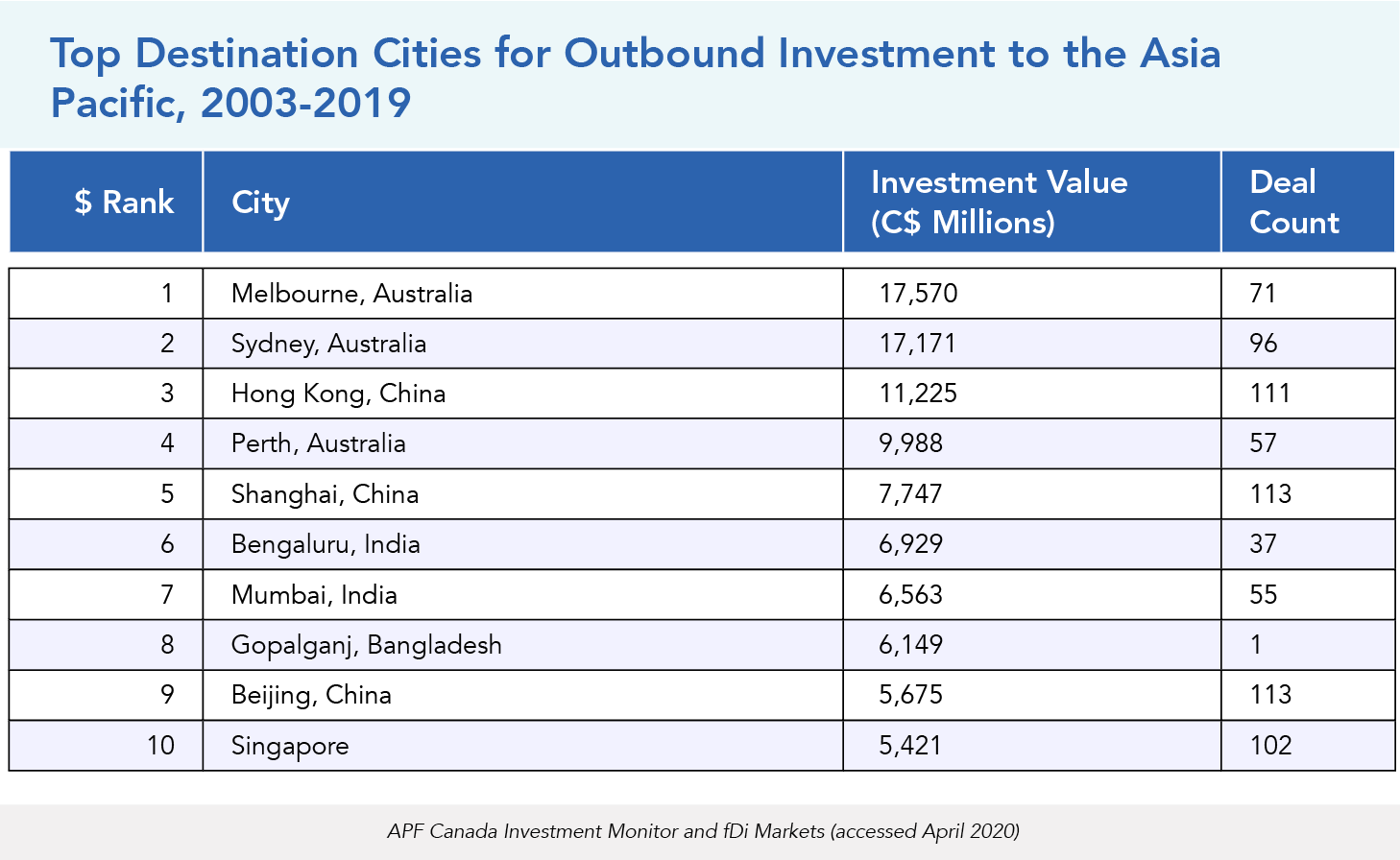
Analyzing the city level for destinations of Canadian investment into the Asia Pacific similarly allows for more understanding of the markets that Canadian companies are interested in. At first glance, most of the top destination cities in the region are familiar due to their role as source cities for inbound investments into Canada. However, while Beijing and Tokyo were the top source cities of inbound investment, as recipients of Canadian investment, these cities are further down the list. Instead, almost 20 percent of all Canadian investments in the region since 2003 have gone to Melbourne and Sydney, Australia.
For 2019, Mumbai, India, received the largest amount of Canadian investment. The city received C$1.3B in investments, making up 17 percent of all outbound investments for 2019. The largest of these investments is Brookfield Infrastructure Partners L.P.’s investment in Reliance Industries Limited, wherein Brookfield acquired a 100 percent stake in a telecom tower company owned by Reliance for C$493M. Another notable deal is the CDPQ’s C$346M investment in Mumbai-based conglomerate Piramal Enterprises Ltd. together with its partners. Overall, many of the large investments in Mumbai were made by Brookfield and various Canadian pension companies, specifically the CPPIB and the CDPQ.
Melbourne, Australia, has been a main hub for Canadian investment in the Asia Pacific since 2003, while in 2019 it received just C$346M, its lowest amount for the 2016 to 2019 period. Moreover, its 2019 total is largely made up of one deal from the CDPQ and Brookfield Business Partners, which acquired Healthscope Ltd., a private health care company that operates private hospitals and medical centres. Other deals that Melbourne received in 2019 include Vancouver-based customer intelligence company Vision Critical’s expansion into the city with a C$30M investment for a new office, and Toronto-based software company Sourced Group’s investment of C$11M into a new office.
Across the board, Canadian investments in the region encompass a great diversity of sectors that differ by city. For Perth, as a hub for energy companies, half of Canadian investments since 2003 have gone to its oil and gas production and mining sectors. For Sydney and Beijing, 40 percent and 28 percent, respectively, of Canadian investment has gone to the cities’ financial services sectors. Meanwhile, 43 percent of investments in Mumbai have gone to its real estate investment and services sector. For Singapore, its most highly invested sector is travel and leisure, making up 41 percent of investment there. In Melbourne and Shanghai, 60 percent and 36 percent, respectively, of Canadian investments have gone to the cities’ industrial transportation sectors. For Hong Kong, 39 percent of investment has gone toward its general retailers sector. For Bengaluru, 75 percent of Canadian investment went to its construction and materials sector. Lastly, the ranking of Gopalganj as the seventh-largest destination city of outbound investments is due to a single investment in solar power, made in 2015 by Toronto-based SkyPower.
Conclusions
The first months of 2020 have demonstrated just how central the Asia Pacific is to the world economy, with Canada being no exception. The indiscriminate effects of COVID-19 have been felt in all parts of the economy, and there are strong reasons to believe that Canada’s historic growth in investment relationships with the Asia Pacific will halt, reversing course as economies across the Pacific withdraw over at least the immediate term.
Even so, Canada’s experiences in the Asia Pacific over the past 17 years are informative for what comes next and the large, whole-economy trends in the region that will be, at worst, temporarily halted. Asia Pacific economies have rapidly grown and adjusted since 2003, and that development will continue to be crucial to Canadian diversification strategies – perhaps now more than ever. Canadians have very limited resources available to help them understand the impact of Canada’s two-way investment relationship with the Asia Pacific, especially at the city and sector level, while there is still more space to improve investment flows under free trade agreement frameworks.
By providing this discrete level of information, the APF Canada Investment Monitor sets the stage for more informed discussions for Canada’s foreign relations, business, and research communities, all ultimately helping the public learn more about the Canada-Asia Pacific investment relationship. The goal of the APF Canada Investment Monitor is to provide the foundation for evidence-based decision-making, not only for policy-makers, but also for all interested stakeholders in the Canadian public, by providing a growing set of data and analysis on both Asia Pacific companies’ investment into Canada and Canadian companies’ investment into the Asia Pacific.
Methodology and Data Sources
The APF Canada Investment Monitor tracks foreign direct investment announcements at the firm level, taking a bottom-up approach rather than reviewing the balance of payments in Canada’s national accounts.
To generate the APF Canada Investment Monitor data, APF Canada uses its own unique legacy data, third-party data sources, metasearch engines, and other search tools to aggregate data obtained from public sources including media reports, company documents, industry associations, and investment promotion agencies. Investment announcements that are entered in the database include greenfield investments, asset purchases, equity investment, mergers, acquisitions, joint ventures, and so on.
The APF Canada Investment Monitor sources its investment stories primarily from its decades-long archive of announcements on deals, trade missions, memorandums of understanding (MOUs), and other developments of note in the Canada-Asia relationship. Such a vast archive allows the APF Canada Investment Monitor to build a strong foundation on which to track deal flow both historically and going forward. Each deal announcement is recorded, catalogued, and added to our database. Deals are recorded using 30 different observations, ranging from parent company to destination city. Key to this cataloguing of investments for trend analysis is the use of a user-friendly sector classification system. Whereas deals catalogued with the widely used North American Industry Classification System (NAICS) often hide key trends in budding industries, the APF Canada Investment Monitor’s use of the modified Industrial Classification Benchmark (Modified ICB) allows it to clearly see growth in areas such as cleantech and the video gaming industry.
Dollar values for the APF Canada Investment Monitor are obtained through a thorough investigation of the deal value and, barring an official value, the best publicly available estimate. This methodology allows for the avoidance of errors that occur in databases that estimate deal value using proprietary algorithms.
Glossary and Abbreviations
|
Abbreviation/Term |
Meaning |
Definition |
|
ABS |
Australian Bureau of Statistics |
The ABS is Australia’s national statistical agency. |
|
APF Canada |
Asia Pacific Foundation of Canada |
The Asia Pacific Foundation of Canada (APF Canada) is a not-for-profit organization focused on Canada’s relations with Asia. |
|
ASEAN |
Association of Southeast Asian Nations |
ASEAN is a regional grouping that promotes economic, political, and security co-operation among its 10 members: Brunei, Cambodia, Indonesia, Laos, Malaysia, Myanmar, the Philippines, Singapore, Thailand, and Vietnam. |
|
BIT |
Bilateral investment treaties |
Bilateral investment treaties are international agreements establishing the terms and conditions for private investment by nationals and companies of one state in another state. |
|
CKFTA |
Canada-Korea Free Trade Agreement |
The CKFTA is a free trade agreement signed between Canada and South Korea in 2014. |
|
Cleantech |
Clean technology |
Clean technology is defined as any process, product, or service that reduces environmental impacts. |
|
CDPQ |
Caisse de Dépôt et Placement du Québec |
The CDPQ is an institutional investor that manages several public and partly public pension plans and insurance programs in Quebec. |
|
CPPIB |
Canada Pension Plan Investment Board |
The CPPIB is a Canadian Crown corporation established to manage and invest funds held by the Canada Pension Plan. |
|
CPTPP |
Comprehensive and Progressive Trans-Pacific Partnership |
The CPTPP is a free trade agreement between Canada and 10 other countries in the Asia Pacific region: Australia, Brunei, Chile, Japan, Malaysia, Mexico, New Zealand, Peru, Singapore, and Vietnam. |
|
FDI |
Foreign direct investment |
Foreign direct investment is a long-term investment by a resident or enterprise from one economy into a tangible asset in another economy. This investment can involve either a greenfield investment or acquisition consisting of at least 10 percent of the equity or voting shares of a firm. FDI in this report is reported as inbound and outbound. Inbound FDI refers to investments made by companies from the Asia Pacific into Canada, and outbound FDI refers to investments made by Canadian firms into the Asia Pacific region. |
|
Flow |
Flow refers to the movement of capital for the purpose of investment, adding to or removing from an economy’s stock. |
|
|
FIPA |
Foreign investment promotion and protection agreement |
A foreign investment promotion and protection agreement is a bilateral agreement designed to protect and promote foreign investment through legally binding rights and obligations. |
|
FPI |
Foreign portfolio investment |
Foreign portfolio investment refers to investing in the financial assets of a foreign country, such as stocks or bonds available on an exchange. |
|
FTA |
Free trade agreement |
A free trade agreement is a treaty between two or more countries to facilitate trade and eliminate trade barriers. |
|
GDP |
Gross domestic product |
GDP is the total monetary or market value of all the finished goods and services produced within a country’s borders in a specific time period. |
|
Greenfield |
Greenfield investments typically consist of firms’ establishment or expansions of their subsidiaries in a different economy. For example, this can involve investments into new offices or company branches. |
|
|
ICB |
Industrial Classification Benchmark |
The Industrial Classification Benchmark is a global standard for the categorization and comparison of companies by industry and sector. This report uses a modified ICB, where certain investment activities have been classified differently to fit the needs of the Investment Monitor. |
|
Industry |
An industry is a broad classification of companies that are related based on their primary business activities. |
|
|
Joint venture |
A joint venture is a business arrangement in which two or more parties agree to pool their resources for the purpose of accomplishing a specific task. |
|
|
LNG Canada |
Liquefied Natural Gas, Canada |
LNG Canada is a joint venture among Shell, PETRONAS, PetroChina, Mitsubishi, and KOGAS. |
|
M&A |
Mergers and acquisitions |
Mergers and acquisitions are a type of investment wherein the partial or full ownership of companies is either consolidated with or transferred to other firms. |
|
NAFTA |
North American Free Trade Agreement |
NAFTA is an agreement among the United States, Canada, and Mexico to eliminate trade barriers between the three economies, implemented in 1994. The new Canada-United States-Mexico Agreement (CUSMA), signed in 2018, has since replaced NAFTA. |
|
NAICS |
North American Industrial Classification System |
NAICS was developed by the statistical agencies of Canada, Mexico, and the United States. This report uses the NAICS Canada 2017 Version 3.0. |
|
NOP |
National Opinion Poll |
Since 2004, the Asia Pacific Foundation of Canada has been conducting regular nationwide surveys to assess Canadians’ attitudes toward countries in the Asia Pacific, and their perceptions of Canada-Asia relations. Unique in its construction and its objectives, APF Canada’s National Opinion Poll has been instrumental in drawing a portrait of Canadians’ perspectives on Asia and the region’s increasing relevance to Canada’s prosperity. |
|
OMERS |
Ontario Municipal Employees Retirement System |
OMERS is an Ontario government pension fund for local government employees in the province. |
|
Pacific Alliance |
The Pacific Alliance is a regional economic bloc composed of Chile, Colombia, Mexico, and Peru, established in 2011. |
|
|
Privately owned enterprise |
A privately owned enterprise is a commercial enterprise owned by private investors, shareholders, or owners. Also referred to as non-SOE. |
|
|
Sector |
A sector is a classification of businesses and economic activities that share the same or a related product or service. Under the ICB, these sectors are clustered together under industries. |
|
|
SOE |
State-owned enterprise |
A state-owned enterprise is a commercial enterprise owned by a government. |
|
Stock |
A stock, in contrast to flow, is a quantity of capital and money that is measurable at a particular point of time. |
|
|
StatCan |
Statistics Canada |
Statistics Canada is Canada’s national statistical agency, providing economic, social, and census data. |
|
UNCTAD |
United Nations Conference on Trade and Development |
UNCTAD is the main UN body dealing with trade, investment, and development issues. |
Sources
Brookfield Instructure Partners. 2019. Brookfield Infrastructure Acquires Indian Telecom Towers. https://bip.brookfield.com/press-releases/2019/12-16-2019-112919449
Caisse de Dépôt et Placement du Québec. 2019. CDPQ and Piramal Enterprises Strengthen Partnership. https://www.cdpq.com/en/news/pressreleases/cdpq-and-piramal-enterprises-strengthen-partnership
Entertainment Software Association of Canada. 2018. Canada – A Nation of Gamers. http://theesa.ca/2018/10/29/essentialfacts2018/
Entertainment Software Association of Canada. 2019. The Canadian Video Game Industry 2019. http://theesa.ca/wp-content/uploads/2019/11/CanadianVideoGameSector2019_EN.pdf
Government of Canada. 2017. Canada-Korea Free Trade Agreement (CKFTA). https://www.international.gc.ca/trade-commerce/trade-agreements-accords-commerciaux/agr-acc/korea-coree/summary-sommaire.aspx?lang=eng#2
Government of Canada. 2019. Canada-Pacific Alliance Free Trade Agreement. https://www.international.gc.ca/trade-commerce/trade-agreements-accords-commerciaux/agr-acc/pacific-alliance-pacifique/index.aspx?lang=eng
Government of Canada. 2020. Comprehensive and Progressive Agreement for Trans-Pacific Partnership (CPTPP). https://www.international.gc.ca/trade-commerce/trade-agreements-accords-commerciaux/agr-acc/cptpp-ptpgp/index.aspx?lang=eng
Jang, Yong Joon. 2011. The impact of bilateral free trade agreements on bilateral foreign direct investment among developed countries. The World Economy. 34.9: 1628-1651.
Montréal International. 2020. Montréal, a major player in video games. https://www.montrealinternational.com/en/keysectors/video-games/
Natural Resources Canada. 2019. Energy Fact Book 2019-2020. https://www.nrcan.gc.ca/sites/www.nrcan.gc.ca/files/energy/pdf/Energy%20Fact%20Book_2019_2020_web-resolution.pdf
Newswire. 2019. Jiangxi Copper Acquires FQM Shares from Pangaea Investment Management. https://www.newswire.ca/news-releases/jiangxi-copper-acquires-fqm-shares-from-pangaea-investment-management-823519821.html
O’Mara, Matthew. 2013. Tecmo Koei Canada closing its Toronto studio. Financial Post. https://business.financialpost.com/technology/gaming/tecmo-koei-canada-closing-its-toronto-studio
Pacific Economic Cooperation Council. 2019. State of the Region: 2019-2020. https://www.pecc.org/resources/regional-cooperation/2627-state-of-the-region-2019-2020
Romei, Valentina, and John Reed. 2019. The Asian Century is Set to Begin. Financial Times. https://www.ft.com/content/520cb6f6-2958-11e9-a5ab-ff8ef2b976c7
Suckley, Matt. 2016. Updated: Gumi shutters studios in Canada, Sweden, Germany, Austin and Hong Kong. Pocket Gamer. https://www.pocketgamer.biz/asia/job-news/63055/gumi-closes-vancouver-studio/
United Nations Conference on Trade and Development. 2019. World Investment Report 2019: Special Economic Zones. https://unctad.org/en/PublicationsLibrary/wir2019_en.pdf
United Nations Conference on Trade and Development. 2020. Investment Trends Monitor. https://unctad.org/en/PublicationsLibrary/diaeiainf2020d1_en.pdf
Zhu, Yushu. 2019. National Opinion Poll: Canadian Views on High-Tech Investment from Asia. Vancouver: Asia Pacific Foundation of Canada.
Partners and Sponsors
The Asia Pacific Foundation of Canada would like to acknowledge and recognize our partner, The School of Public Policy at the University of Calgary, without which this project could not have grown as it has. We also want to thank and acknowledge our generous sponsors: Export Development Canada, Invest in Canada, the Government of British Columbia, AdvantageBC, and the Bank of Canada.
Advisory Council
In addition to our sponsors and partner, we would like to especially thank their representatives who sit on the APF Canada Investment Monitor Advisory Council, whose input and guidance from the conception to the launch of this project has proved invaluable.
Sarah Albrecht, Director, Partnership Strategy, Invest in Canada.
Dr. Eugene Beaulieu, Professor of Economics and Program Director, International Economics, The School of Public Policy, University of Calgary.
Dr. Jeff Reeves, Vice-President, Research, Asia Pacific Foundation of Canada.
Lori Rennison, Senior Policy Advisor, Canadian Economic Analysis Department, Bank of Canada.
Clark Roberts, President and CEO, AdvantageBC.
Siobian Smith, International Strategy and Business Intelligence, British Columbia Ministry of Jobs, Economic Development and Competitiveness.
Dr. Stephen Tapp, Deputy Chief Economist and Director, Research Department, Export Development Canada.
About the Asia Pacific Foundation of Canada
The Asia Pacific Foundation of Canada (APF Canada) is a not-for-profit organization focused on Canada’s relations with Asia. Our mission is to be Canada’s catalyst for engagement with Asia and Asia’s bridge to Canada. APF Canada is dedicated to strengthening ties between Canada and Asia with a focus on expanding economic relations through trade, investment, and innovation; promoting Canada’s expertise in offering solutions to Asia’s climate change, energy, food security, and natural resource management challenges; building Asia skills and competencies among Canadians, including young Canadians; and improving Canadians’ general understanding of Asia and its growing global influence.
A leader in research and analysis on Canada-Asia relations for over 30 years, the Foundation is well known for its annual national opinion polls of Canadian attitudes regarding relations with Asia, including Asian foreign investment in Canada and Canada’s trade with Asia. The Foundation places an emphasis on China, India, Japan, and South Korea while also developing expertise in emerging markets in the region, particularly economies within ASEAN.
